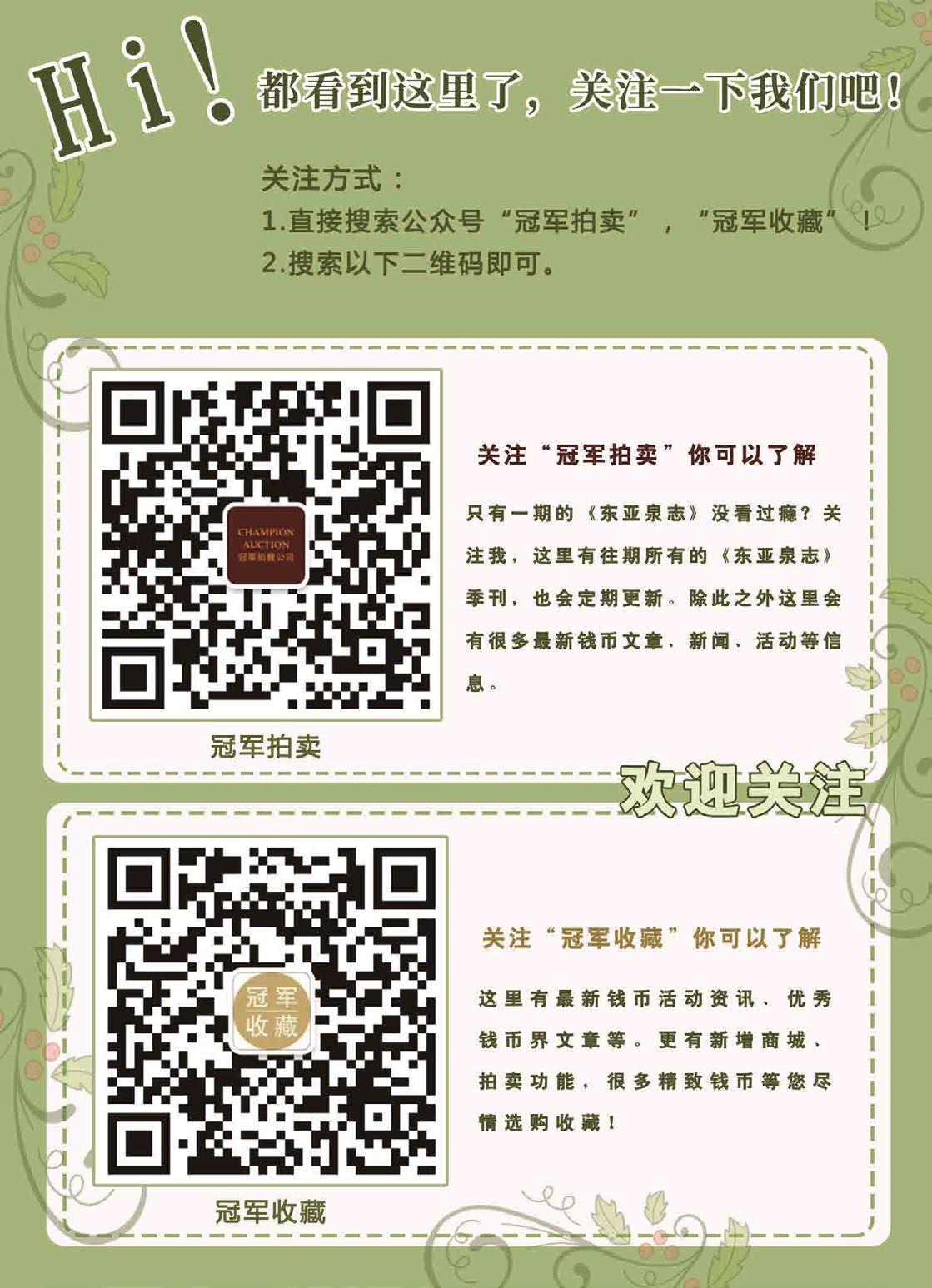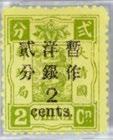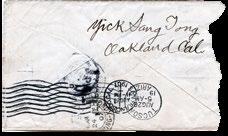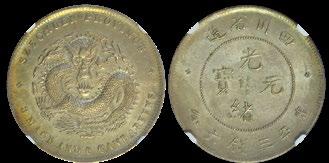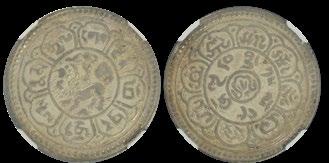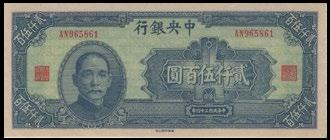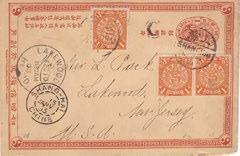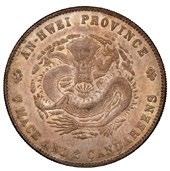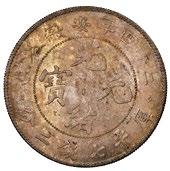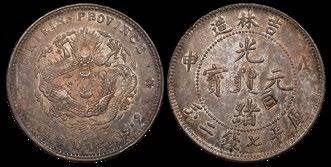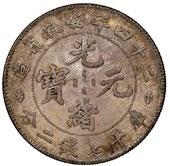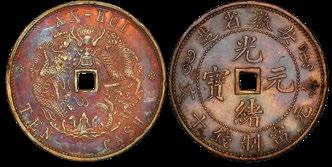












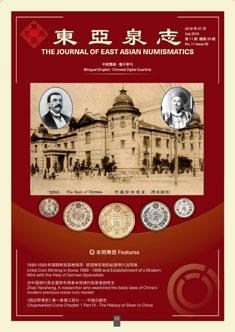



































































Welcome to the 29th issue of the Journal of East Asian Numismatics
One of the featured articles is The Ta-Ching Government Bank Redeemable Notes Bearing the Portrait of Li Hungchang with the Bank of China Overprint by our friend Alex NC Fung, which introduces the background of the birth and issuance of the first banknote issued by the Bank of China. Stephen Tai provided us with an interesting article on chopmarked coins, that is, Organized Chaos-ChopmarksonForeignCoins
This issue features two articles from prominent numismatists and scholars in the 20th century, Howard F. Bowker's Foochow 1903 and E.Kann'sEarlyChineseSilverCoinage
As the stamps, covers, and banknotes from the Bowker Collection recently aroused wide attention, Cheng Bin and Zhou Bian made some research on the stamps and envelopes from the Bowker Collection and wrote the Specimens for Use in Xinjiang from the Howard Franklin Bowker Collection and Interesting Postal EnvelopesfromtheBowkerCollection respectively.
Zhou Bian also made reviews on A Comprehensive Catalog of Macau Banknotes: Currency of Macau - A Complete Reference (Banknotes) II and The Annals of China Gold Coin Corporation 1987-2017
The new book South Korean Coins in the Era of Development published by iAsure Group was launched at the 2022 ANA World's Fair of Money, and Mark Lovmo, the author of the book and an expert on Korean coins, shared related activities. We also reviewed the past Champion 2022 Macau Auction and the 2023 Berlin World
Money Fair Panda Medal first strike ceremony in this issue. At the end of 2022, we regret to learn of the death of Mr. Wang Guichen, a famous ancient numismatist, philological and historical scholar, and Yuan Fang wrote an article to mourn this great numismatist.
Chen Hongyu contributed an article, A Rarely Seen One-Mace SixCharacter Coin: Whether it is an Original Strike in AH 1309 or a Restrike in AH 1319, which discussed a six-character coin he had seen.
Issue 29 also continues with articles by our friends Jeff Garrett and David Vagi, including The Importance of Professional Advice and Byzantine Coin Portraits. Both articles are reprinted with permission from NGC.
We hope that every reader will find an article of interest in this issue.
The World Money Fair, Berlin will be held from February 3 to 5, 2023, and the 2023 WMF Show Panda will be released at the show, so stay tuned! We also look forward to seeing you at the Singapore International Coin Fair from March 24 to 26 and the Hong Kong International Coin Show from April 11 to 13!
Michael Chou Publisher & Editor-in-ChiefChampion 2022 Macau Auction Review

Review on the 2023 Berlin World Money Fair Show Panda Medal First-Strike Ceremony
In Memory of Mr. Wang Guichen
Korean Coin Book Release at ANA 2022
Champion〔 Shanghai〕 Champion〔 Shanghai〕
Yuan Fang〔Xi' an〕
Mark Lovmo〔USA〕
A Comprehensive Catalog of Macau Banknotes: Currency of Macau - A Complete Reference (Banknotes) II
A Record of 30 Years of Entrepreneurship and Brilliance in Precious Metal Coins - The Annals of China Gold Coin Corporation 1987 - 2017
A Rarely Seen One-Mace Six-Character Coin: Is it an Original Strike from AH 1309 or a Restrike from AH 1319

The Specimen Stamps for Use in Xinjiang from the Howard Franklin Bowker Collection

yan
古錢方面,陳虹宇先生依託其見到的一枚六字壹錢銀幣實 物,對其“是 AH 1309初鑄還是 AH 1319補鑄”進行了探 討。
第29期雜誌中還繼續刊載了我們的好友傑夫 加勒特先生 和大衛 瓦吉先生的文章,分別是《錢幣收藏和投資專業建 議的重要性》和《拜占庭錢幣上的帝王肖像》。這兩篇文章





As for the ASG-certified stamps, PMG-certified banknotes, and postal envelopes from the Bowker Collection, the proceeds of those sold in July and October WeChat auctions have been donated to Macau schools to promote the development of numismatic and philately culture in Macau. Champion is working with the Macau Numismatic Society and its president David Chio for the selection and support of a five-year plan in five different Macau schools.
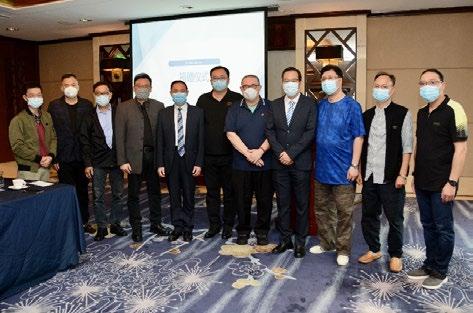
The NC Collection highlighted the auction again, arousing spirited bidding between a phone bidder and a local buyer. The top was lot 137 – 1898 Anhwei Silver Dollar with the short Chinese character "4" and large rosette (NC Collection, NGC MS65), realizing USD 246,000 (all figures include the 20% buyer's fee); lot 138 – 1898 Anhwei "A.S.T.C." Silver Dollar without "A.S.T.C." realized
USD 144,000; lot 140 – 1902-1906 Anhwei Squared Hole Copper Pattern Coin (NGC MS63) realized at USD 67,200, a record price for NGC certified Anhwei Squared Hole Copper Coin; lot 139 – 1908 Kirin Silver Dollar with a small chopmark (NGC AU DETAILS) went to a Taiwan phone bidder at USD 60,000; another NC Collection coin, lot 141 – 1898 Kirin Half Dollar Silver (NGC MS64), brought active bidding among a Taiwan buyer, an American buyer and a Singapore buyer, and it went to the American buyer at USD 27,600; lot 146 - 1899 Fengtien 10 Cash Copper Coin (NGC VF30BN) from the NC Collection went to a floor bidder at USD 9,600.
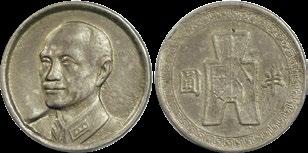
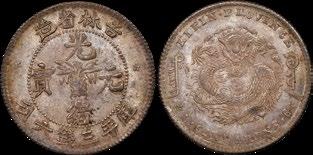
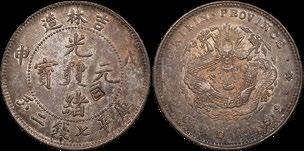


The coins from other famous collections also had great results. Lot 134 – 1871 Qing Dynasty Tung Chih 5 Taels Gold (NGC MS63) from the Kann Collection realized at a
record price of USD 126,000; lot 135 – 1863 Qing Dynasty Tung Chih 5 Tael Gold (NGC MS63), also from the Kann Collection, realized a record price of USD 97,200; the Arthur Coole Collection 1899 Hupeh One Dollar Note (lot 106, PMG Choice EF45) went to an online bidder at USD 67,200, breaking the auction record; lot 169 - 1936 Chiang Kai-shek Spade Half Dollar Lead-Tin Pattern from the J.C. Lee Collection realized USD 12,000.
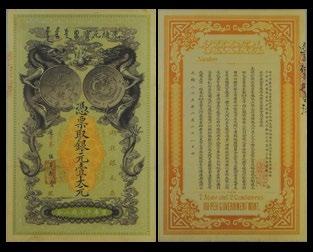
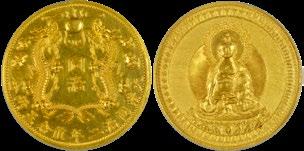


The stamps from the Bowker Collection were also impressive. There was spirited bidding among a phone bidder, an overseas bidder, and bidders on mxiqi.com, and most stamps were bought by the phone bidder. Lot 027 – CHINA Qing Dynasty 1915 1st Beijing Print Postage Due Specimen Stamp Set (8) (ASG VF80 Mint OP) realized USD 14,400; lot 030 - CHINA 1924 2nd Beijing
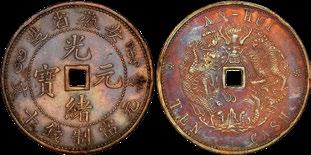
LOT 027
LOT 030
lot 038 - 1902 Cover from Yixian to Qingdao, Shantung, with Taiwan phone bidder winning at USD 2,160; lot 040 – 1906 Red-band Cover from Kimhwa, Chekiang to Moganshan went to a Macau buyer for USD 2,160.
In addition, lot 159 – 1916 Yuan Shikai Hung Hsien Flying Dragon Silver Dollar (NGC MS63) brought active bidding between a Singapore phone bidder and an American bidder, and it went to the phone bidder for USD 43,200.
LOT 041
Print Memorial Archway for use in Xinjiang Specimen Stamp Set(3) (5 Yuan, ASG VF/XF85 Mint POG; 10 Yuan, ASG VF80 Mint POG; 20 Yuan, ASG VF/XF85 Mint POG) realized USD 9,600; lot 019 – CHINA EMPIRE 1899 Weihai Port Courier Post Stamp 2 Cents Block of 25 (ASG F/VF75 Mint OG) realized USD 3,120. It is noteworthy that the phone bidder has been purchasing PMG-certified banknotes since 2009, and he has a very positive view of the future of ASG-certified stamps.
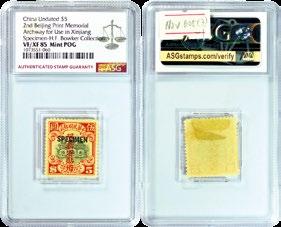
In terms of envelopes from the Bowker Collection, lot 041 – 1898 Postcard from Kwangchew to the US (Nov. 22) had many mail bids and phone bidders from Hong Kong and Taiwan, with the Hong Kong buyer winning at USD 10,200; lot 045 - 1950 Registered cover from Tientsin to the US had four different mail bidders and three phone bidders from Taiwan, Hong Kong, and the mainland, as the most popular postal cover in this auction, and the Mainland Chinese buyer won at USD 7,200; lot 034 - 1893 Shanghai Local Post Postcard (Oct. 27) from Shanghai to Peking went to a Hong Kong buyer at USD 2,160; phone bidders from Taiwan, a phone bidder from Mainland China, and floor bidders competed for the rare cover

Since the proceeds from all the ASG-graded stamps and PMG-graded banknotes from the Bowker Collection will be donated to five primary schools in Macau, we held a donation ceremony on November 26, the day before the auction, and participated in the ASG/PMG reception luncheon. Michael Chou, President of the Champion Auction, Mateo Zhao, Vice President of CCG Asian Business Development, David Chio, President of the Macau Numismatic Society, Io Hong Kuong ( 姚鴻光) , President of the Macau Philatelic Association, Ieong Chan Kei ( 楊燦基), Principal of Macau ESCOLA TONG NAN, and Chan Chon San ( 陳春新 ), Vice Principal attended the donation ceremony.
At the donation ceremony, Michael Chou presented Macau ESCOLA TONG NAN with a number of ancient coins, various fractional coins which circulated in Macau, 200 copies of the brochure Introduction to Ancient Chinese Coins, and 30,000 Hong Kong dollars as funds, to support the activity of the Chinese ancient coin interest group established by the school to carry out a research and study series. Principal Ieong Chan Kei said that the school would make good use of relevant materials to further promote the development of the interest group, enhance students' recognition of the culture of collecting, and comprehensively improve the level of cultural relics and appreciation ability of works of art.
In addition to the sponsorship for numismatic and stamp
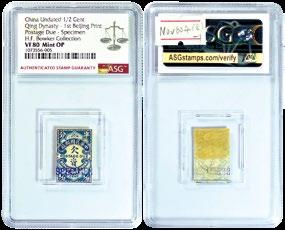
collecting activities, the auction proceeds of the Bowker Collection stamps, envelops and banknotes will also be used to set up a 5-year Bowker Culture Award program in Macau ESCOLA TONG NAN from this year to reward students who have excellent performance in Chinese and English, including outstanding performance in disciplines or related competitions and activities, so as to encourage primary and secondary students to develop their comprehensive abilities of Chinese and English.
At the ceremony, Michael Chou and Mateo Zhao also introduced the highlights of the Champion 2022 Macau Auction; David Chio delivered a welcome speech; Mateo Zhao introduced the story of ASG/PMG and the Bowker Collection; Michael Chou reviewed the activities of the Macau Numismatic Society over the years.
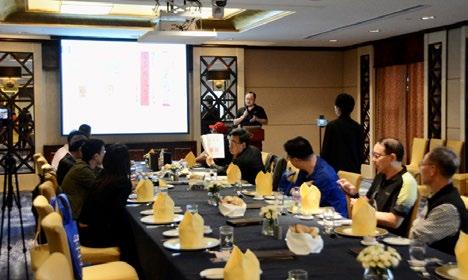
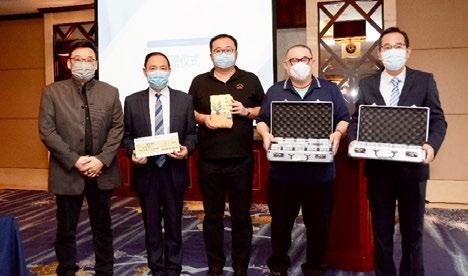
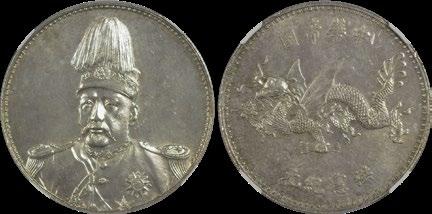
Since the auction was held during the annual meeting of the Macau Numismatic Society, Michael Chou was invited to attend the opening ceremony of the annual meeting held on November 24 and cut the ribbon. At the opening ceremony, Michael Chou together with David Chio and Mateo Zhao unveiled the 2022 Macau Numismatic Society Panda Medal and the plaster. After the opening ceremony, Michael Chou also attended the reception dinner of the Macau Numismatic Society.

The Champion 2022 Macau Auction and donation ceremony were both broadcast on the "Champion Auction" account on the Kuaishou platform, with over 15,000 views, as one of the most watched broadcasts since the launch of the "Champion Auction" account.
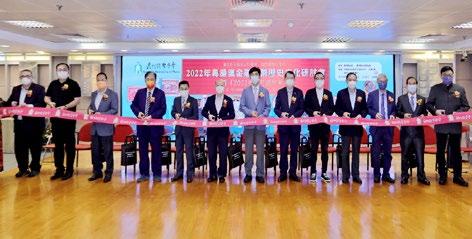



/ 席徳柄舊藏
的 LOT 138 - 1898年(光緒二十四年)安徽省造光緒元寶 庫平七錢二分“A.S.T.C.”不帶“A.S.T.C.”版銀幣(NGC MS64),以144 000 美元的價格成交;出自張南琛收藏的 LOT140 - 1902 - 1906年安徽省造光緒元寶每元當制錢十 文銅幣方孔樣幣(NGCMS63BN),以67 200 美元的價格成 交,價格打破









27 600 美元的價格成交,競價主要在中國臺灣買家、美國買 家和新加坡買家之間展開,最終美國買家得標。 其他名人收藏拍品也成績斐然:出自耿愛德舊藏的 LOT 134 - 1871年清代辛未同治十年值念五兩金金幣,背彌勒佛像, 以126 000美元的價格成交;出自耿愛德舊藏的 LOT 1351863年大清同治二年值念五兩金以97 200美元的價格成交; 出自邱文明收藏的 LOT 106 - 1899年湖北銀元局壹大元銀 元票(PMG Choice EF45),被線上買家以67 200美元的價 格競得;LOT 146 - 1899年奉天機器局造光緒通寶當十錢紫 銅幣(NGC VF30)被現場買家以9 600美元的價格收入囊中。 以上三項均打破拍賣紀錄。而出自 J.C.Lee 收藏的 LOT169 - 1936年蔣介石像背布圖半圓錫鉛試樣幣,以12 000美元的價 格成交。

7 200 美元的價格競得;LOT 034 - 1893.10.27上海工部書信館郵資 信卡被一位中國香港買家以2 160美元的價格競得;一位臺灣 電話委託買家及一位內地電話委託買家都對 LOT038 - 1902 年山東嶧縣寄青島平信志在必得,中國臺灣買家最終以2 160 美元的價格將其收入囊中;LOT 040 - 1906年浙江金華寄莫 幹山紅條封被一位中國澳門買家以


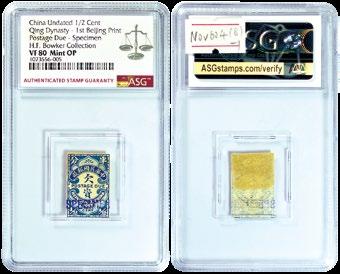





The first-strike ceremony of the 2023 Berlin World Money Fair Show Panda Medal was held at 11:00 on December 9 in the offices of Shanghai New Century Coin Minting Co., Ltd.


Michael Chou, President of Champion Auction, Mateo Zhao, Vice President of CCG's Asian Business Development, Yu Min, winner of the Lifetime Achievement Award of the COTY, Mr. Yi Shizhong, founder of Shanghai New Century Coin Minting Co., Ltd., Li Zhenhua, die
engineer of Shanghai New Century Coin Minting Co., Ltd., and Tang Xingbang, general manager of China (Hong Kong) Coin Company, Michael Hu, co-founder of mxiqi. com, and others attended the event.
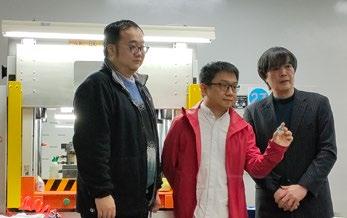

Yu Min first explained the design of this medal; Later, Mateo Zhao introduced this cooperation with the Champion Auction; Li Zhenhua illustrated the techniques used in this medal. Finally, Yu Min struck the first 2023 Berlin World Money Fair Show Panda Medal.

◎
Yuan Fang〔Xi'an〕Mr. Wang Guichen ( 王貴忱 ), a famous ancient coin, philological and historical scholar, passed away peacefully at 11:30 p.m. on October 26, 2022, in Guangdong Provincial People's Hospital at the age of 95.
Mr. Wang was born in Tieling, Liaoning Province in 1928, joined the revolution in 1945, went south with the army in 1949, and lived in Lingnan for more than seventy years. During his lifetime, he served as the Manager of the Bank of Communication in eastern Guangdong, the President of the Shantou Construction Bank, the Deputy Director of Guangdong Zhongshan Library, the Former Deputy Curator of the Guangdong Museum, the director of Guangzhou Historical Record Office, a council member of the Chinese Numismatic Society and a member and honorary director of the academic committee of the Chinese Numismatic Society, and former Vice President of Guangdong Numismatic Society. He has made extraordinary achievements in the fields of Chinese ancient coins, philology, calligraphy, and collecting, and is known as one of the "two Wangs" along with Wang Shixiang ( 王世襄 ) in the collecting community. He is regarded as "a rare generalist in the contemporary literary and historical field in Lingnan".(Fig. 1)
Mr. Wang was involved in the collecting and arranging of historical documents, especially numismatic documents. Starting at an early age and lasting decades he accumulated a magnificent collection of numismatic documents. He made many generous donations, turning his private collection into a shared one. In 1963, he donated five volumes of the Zhou Yi Cheng Zhu Chuan Yi (《周易程朱傳義》) edited during the Jiajing's reign in the Qing dynasty to the Guangdong Zhongshan
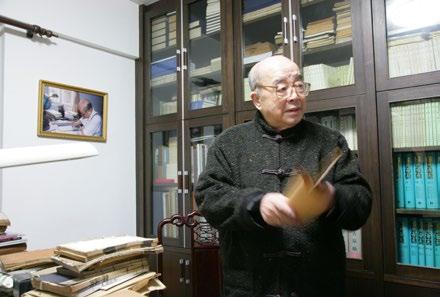

Fig. 1 Wang Guchen in his "Keju" study in 2015
Library; in 1990, he donated 363 pottery tiles from the Nanyue Kingdom that he had collected over his life to the Guangdong Museum. In 1999, he donated more than 600 volumes of numismatic literature that he had spent half his life collecting to the Chinese Numismatic Museum, including A Record of Coins (《泉志》) by Hong Zun ( 洪 遵 ) in the Ming dynasty, A Study of Coins in two volumes (《錢幣考二卷》) written during the Zhengde's reign in the Ming dynasty, A Coin Catalog in one volume (《錢譜一 卷》) by Dong Yu ( 董遹 ) in the Ming dynasty, A Register of Coins in 12 volumes (《錢錄十二卷》) written by Zhang Duanmu ( 張端木 ) in the Qing dynasty, A Coin Catalog By Imperial Order in 16 volumes (《欽定錢錄十六卷》) by Liang Shizheng ( 梁詩正 ) and others, Statements on Ancient Coins in two volumes ( 《古泉叢話二卷》) by Dai Xi ( 戴熙 ) with Rong Geng's ( 容庚 ) comments, the original edition A Collection of Coin Rubbings (《泉幣集拓》) edited by Ma Dingxiang ( 馬定祥 ), which greatly enriched the collection of the Chinese Numismatic Museum(Fig. 2) Later, he donated nearly 100 of Chang Chih-tung's ( 張
之洞 ) books and 807 volumes of ancient documents to the Guangzhou Library, including the red-printed version of 1899 Ding'an Poems (《定庵續集己亥雜詩》), leaving behind a precious wealth of literature and history. Mr. Wang's noble character is a model for all.
Mr. Wang Guichen used his collection of ancient documents as a reference, diligent writing in his study named "Keju". He co-edited the Five Types of Chaozhou Opera in the Ming Dynasty (《明本潮州戲文五種》) with Yang Yue ( 楊樾 ), Qu Dajun Complete Collection (《屈大 均全集》) with Ou Chu ( 歐初 ), Notes on Tseng Kuo-fan's Unpublished Books (《曾國藩未刊書劄》), 1898 Zhang Yinhuan's Diary Manuscript (《張蔭桓戊戌日記手稿》), Correspondence with Luo Zhenyu Collected in Keju Study (《可居室藏書翰 羅振玉》), The Correspondence from ZhouShuzoutoZhouYiLiangCollectedinKejuStudy ( 《可 居室藏周叔弢致週一良函》), and The Correspondence from Zhou Shuzou, Zhou Yiliang, and Zhou Jingliang to Wang Guichen Collected in Keju Study (《周叔弢、週 一良、周景良致王貴忱函》). In the field of ancient coin research, he wrote extensively and devotedly. His main works include Zhi Nai Qian Bo (《庤乃錢博》), On the
Wu Coins (《吳泉說》), A Catalog of Three-hole Spades (《三孔幣彙編》), A Collection of Pre-Qin Coinage (《先 秦貨幣文編》) co-edited with Shang Chengzuo [ 商承祚 ) (Fig. 3)and Tan Dihua ( 譚棣華 ], A Dictionary of Ancient Coins (《中國錢幣大辭典 泉人著述編》), A Catalog of Ancient Vietnam Coins (《越南景興錢譜》), The Rubbings of Ancient Vietnam Coins (《越南古錢集拓》), and Large Annam Coins Collected in the Keju Study (《可居室藏 安南大錢》), and the Document and Catalog of Coins Collected in the Keju Study (《可居室藏錢幣文獻圖錄》) co-edited with Wang Dawen ( 王大文 ) in October 2015. He also published many numismatic articles published in prestigious journals, including three that received the Gold Coin Award for Outstanding Paper and two that received the Gold Coin Award for Outstanding Works.
Mr. Wang Guichen was well known in the field of literature, numismatics, and libraries, and he was highly respected and made outstanding contributions. We deeply miss the honorable Mr. Wang Guichen.
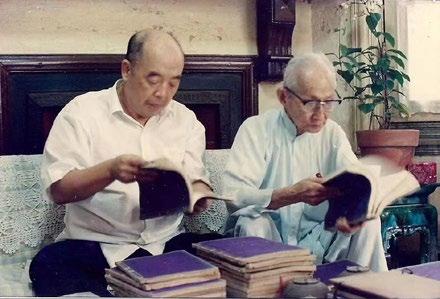
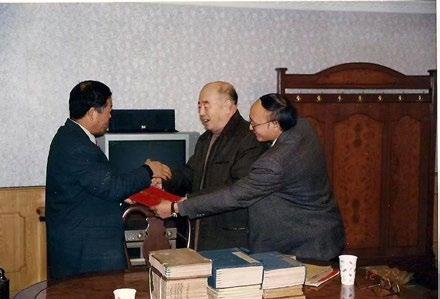

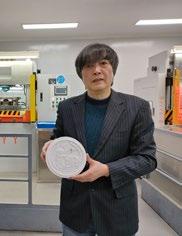



和收藏領域成就非凡,與王世襄並稱收藏界“二王”,被譽為 “當代嶺南文史學界一位不可多得的通才式人物”。( 圖1)
王貴忱早年即涉足歷史文獻,特別是錢幣文獻的搜集、整 理,歷數十年積累,收藏宏富,被譽為“當代收藏錢幣文獻 最多的人”。他變私藏為共用,多次慷慨捐贈。1963年把嘉 靖本《周易程朱傳義》5 冊捐贈給了省立中山圖書館。1990年, 將畢生收藏的


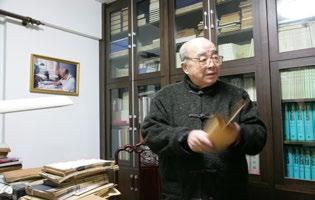

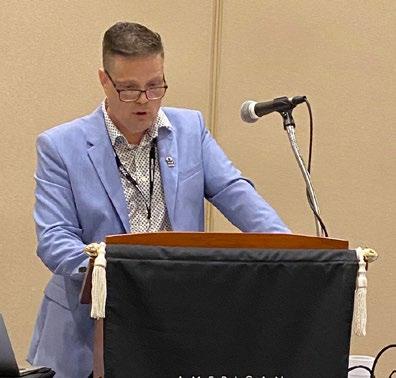

 ◎ Mark Lovmo〔USA〕
◎ Mark Lovmo〔USA〕
I recently had the great pleasure to present my book, SouthKoreanCoinsintheEraofDevelopment (published by iAsure Group), to the numismatic community in the USA at the 2022 World's Fair of Money in Chicago in August. After years of attending coin shows as a collector and spectator, the experience of "standing on the other side of the dealer table" along with the release and promotion of my book was an insight into the advantages of cultivating expertise in an area of numismatics, and to the many opportunities that it can afford.
The American Numismatic Association (ANA) has been holding its annual "World's Fair of Money" at the same convention center location every year in a row for about the past five years in Rosemount, Illinois near Chicago. The large Donald E. Stephens Convention Center again housed over 450 dealer tables in mid-August 2022, with over 1,000 numismatic dealers and their employees for this six-day event. With its location near a major city, the "ANA Show" is a week-long hive of numismatic sale activity and educational opportunities in the United States. As I had a busy schedule promoting and selling my book, I needed to be present every day of the ANA Show this year, from Tuesday through Saturday.
I have attended the World's Fair of Money in each of those past five years that it has been held at this location. Therefore, I was familiar with this convention center and the rather dangerous road that runs in front of it. True to form, the Chicago-area drivers racing down that thoroughfare almost ran me over in the crosswalk on two occasions this year as I headed on foot to my hotel on the other side of the street. I am certainly not the only person who has ever had this experience. This road in front of the Stephens Convention Center is one of the major downsides to this
event location (in addition to the rather low-lighting conditions of the bourse floor), but according to an insider source,
the ANA will not move the location of the World's Fair of Money to the much safer and overall better location of the Schaumburg Renaissance Convention Center, which is located nearby. The reason for this is rumored to be that certain attendees prefer a shorter drive to downtown Chicago to take advantage of the restaurants and bars for their parties and meetings.
Thomas Michael of Active Interest Media and I in downtown Chicago. Mr. Michael is Senior Editor of Numismaster.com.
Lunch Downtown
During the week I spent at the ANA show, I was invited to one such downtown meeting. The 20-minute drive from the Stephens Convention Center to downtown Chicago on that Wednesday morning was perhaps shorter
by 10 minutes compared to the drive from Schaumburg. When I arrived, I had the honor of meeting with Michael Chou of JEAN and our hosts, J.C. Lee of Poongsan Hwadong and his staff at a well-known upscale restaurant. Also in attendance was Thomas Michael of Active Interest Media (AIM). Thanks to Mr. Chou's recommendation, J.C. Lee graciously agreed to have Hwadong market my book in Korea as its official distributor there. Mr. Lee therefore had generously arranged this lunch in order to reconnect with us after our last meeting in the summer of 2019.
As two of the most influential figures in the East Asian numismatics business were present, this lunch involved rather enlightening conversation. The most interesting highlight was learning of J.C. Lee's leadership of Golden dew Company in the late 1980s after the Korean government liberalized local

Mark Lovmo presenting his Money Talk: "South Korean Coins in the Era of Development: An Overview" at the ANA World's Fair of Money on August 18, 2022.

gold trading, which had previously been quite restrictive in Korea. Golden dew Company started out as a dealer of gold coins in the United States in 1973 and, by 1989 when J.C. Lee was with the company, had started to retail jewelry to the nouveau riche of Korea who had begun to appreciate and buy jewelry as fashionable accessories. One notable item of jewelry that the company sold at this time took the form of a gold coin held in a bezel setting suspended on a necklace. Apparently, Mr. Lee was not only quite successful in selling this popular item, but his above-board business practices also allowed Golden dew to avoid running afoul of the local regulators and their changing rules; much unlike his less-fortunate business contemporaries who had also tried their hand at selling gold in Korea.
Mr. Lee's story confirmed much of what I had learned while researching the topic of the gold market in Korea during the time that the 1988 Seoul Olympics commemorative coin series first appeared. The 1988 Seoul Olympics series - about which the most comprehensive recounting to be found anywhere is Chapter 20 of my bookfeatured the very first Olympics coins to contain one full-ounce of gold. These were the first real fungible, investmentquality gold coins issued in Korea, and
they were very popular upon release.
With Hwadong's great help in distributing my book in Korea, I am able to reach the main collector community for South Korean coins more effectively. Yet another incredible opportunity arose from this meeting, since I was able to connect with Tom Michael of AIM immediately afterwards. Mr. Michael sat down with me to ask me to help update the South Korea listings at Numismaster. com. In the coming months through email exchanges, I suggested what I thought were some helpful, yet modest edits to the Numismaster Catalog. With his years of work in the field, the Catalog is clearly in good hands with Tom Michael as senior editor. He is very conversant and experienced in the expansive subject of world coins and is keenly interested in meeting the needs of collectors and dealers when it comes to information on coins. As for my participation, it was quite exciting to have input into what is essentially the main source of information that collectors worldwide access when inquiring about South Korean coins.
Although enjoyable, these downtown meetings were not the primary reason I had come to Chicago. This year, I arrived at the ANA show as the author of a new book, and I was to use this occasion to announce its official release and sell copies to attendees at the show. In this regard, I was scheduled to promote my book the next day by talking about my research on South Korean coins in a presentation hosted by the ANA. The ANA sponsored eight other 30- to 45-minute presentations that day at the convention center. Rather encouraging was the fact that, along with my presentation, there were two other presentations, or "Money Talks" as the ANA calls them, on Asian numismatics: One by chopmark coin researcher Colin Gullberg and another by modern Chinese coin researcher Michael Corley of NGC.
Past ANA shows seemed not to have hosted three Asian coin-related presentations on one day let alone that many during one of these week-long events, so it was an
encouraging sign that the ANA was choosing to widen its parameters of "acceptable topics" for these Money Talks. Although I had submitted the application well before the deadline, my Money Talk almost did not happen, as the ANA board that decides which presentations to accept or reject had almost rejected mine. However, I had a great advocate in the form of ANA volunteer Sam Gelberd, who was able to convince the board to stretch that day's schedule to accommodate my presentation. Mr. Gelberd also helpfully prepped the room where my Money Talk took place in his capacity of tech support - in addition to the many other duties he cheerfully performed at this year's ANA show.
When it came time to present, I was ready. In fact, I had spent the previous three months to create and revise my presentation, which I structured as a quick overview of South Korea's coins and coin production during that country's vital period of national growth that spanned the late 1950s to the 1980s. I believed that attendees would best enjoy a brief rundown on this almost completely unknown history of South Korea's coins, as well as a few PowerPoint slides on the prices of a few of the key date coins in today's numismatic market. Once I had my Money Talk prepared, I "field tested" it by giving a version of this presentation at my local coin club in Minnesota a week before I left for Chicago. It was well-received, and this first showing allowed me to revise it for an even better presentation at the ANA show.
Thanks to these efforts, and with a bit of luck, my Money Talk at the World's Fair of Money went off without a hitch. I was even lucky enough to have both Michael Chou and J.C. Lee in attendance as well as other noted audience members Colin Gullberg and Jim Moores of the Central States Numismatic Society also kindly taking some time from their evening to attend. With my Korean coin presentation now finely tuned, I was later asked to present a version of it at an online event the following month hosted by the coin forum site, World of Coins (worldofcoins.eu). And to my surprise, the Newman Numismatic Portal (NNP) of Washington University in St Louis accepted with alacrity my proposal to present a different version of this Korean coin talk at their online event in November. After these presentations, I was humbled by the many subsequent positive reviews, one of which was from the prolific writer and my favorite author in numismatics, Roger W. Burdette. All these opportunities were not only fun and encouraging, but they also allowed me greater exposure in the wider world of numismatics as a specialist on South Korean coins.
arranged space at his dealer table to allow sales of my book. It was difficult to balance being present at the table to sell copies while also walking the bourse floor in search of world coin dealers. Most of the dealers who I approached were quite interested in the book and purchased one or more copies. Their interest was especially piqued when they learned that the book also features recent Korean auction and retail pricing for South Korean coins. This pricing information, along with a full accounting of all the commemorative coins released up to 2021, appeared to be the main selling points for them. To my pleasant surprise, the major U.S. third-party grading companies and most of the big auction businesses present at the ANA Show also purchased copies to use as their main reference on the subject. Only ICG and ANACS took a pass on the book, citing insufficient business in grading South Korean coins.
The second-to-last day of the ANA show was a whirlwind of book sales, as customers who had heard of my presentation began to appear at Michal Chou's Champion Auction table to purchase copies. Mr. Chou helpfully
As Saturday was the last day of the show, many dealers began leaving by midmorning. Before I left the show that day, I used this time to make the final rounds to those tables that I might have missed the day before. I was happy to find David Lisot's "Coin Television" booth near one of the last rows of tables at the convention center. Mr. Lisot is known in the U.S. numismatic community as the hobby's videographer, and he has captured on video thousands of numismatic meetings
and presentations at coin shows around the country for decades. I've watched many of his videos the NNP archive, especially his interviews with authors and business owners in the hobby.
As Mr. Lisot was present at his booth, I chatted him up and told him just how much I enjoy watching his interviews with the great numismatists from the past four decades. He had interviewed Clifford Mishler, Chester Krause, R.W. Julian, Walter Breen, and Anthony Swiatek, among many other giants in U.S. numismatics. I wanted to let Mr. Lisot know just how much his work has benefitted me through the knowledge and stories that he elicited from these people. He was obviously touched and told me that it was his great pleasure to have captured these interviews. I also detected from him a bit of sadness in that many of these good old friends of his in this field are now gone.
He then asked me about the book I was hawking, and then swung his camera around and turned on the square light above it and said, "How about an interview?" I had to think about it for a minute, but I agreed. Mr. Lisot was an expert at this short form interview, and he got me talking about the book on camera. Just from this short interaction with him, I found out that he was very well-spoken and showed strong evidence that he had an intellect on par with pretty much any of those big brains in numismatics he's interviewed!
I left the convention center that day with the feeling that I had accomplished what I had set out to do, and I was especially pleased to have met and talked with David Lisot. Therefore, I was very sad to have later learned of his passing so soon afterward on October 15th this year. Everyone who knew him regarded him as both a kind soul and as an important fixture in the U.S. numismatics scene who will not be easily replaced.
My new experiences at the ANA Show that I describe in this article are certainly not the end of my newfound journey. In the months immediately after the ANA Show, I was very busy with book sales and shipping copies to customers from all across the United States and Canada, and to coin enthusiasts as far away as Sweden and Australia. I was also busy with journalists interviewing me for press reviews of my book, with more reviews promising to take place in 2023 in publications such as CoinWeek and ONS. Writing my book on South Korean coins was not only an adventure in itself, but this later work to promote and sell the book also placed me in contact with some of the more important people in the numismatic scene, as well as the equally important individual collectors and dealers who have a keen interest in South Korean coins. I encourage those who are willing and able to do so to make more efforts to increase their competence that area of numismatics where their passion and interest lies.
David Lisot once asked a famous U.S. coin expert in an interview why he had gotten into coins in the first place, and the response was " I found that numismatics is a field where a little expertise goes a long way."
I completely agree!
Shown here are (L to R) Michael Chou, Thomas Michael, and President of Poongsan Hwadong, JC Lee watching the Korean coin presentation.
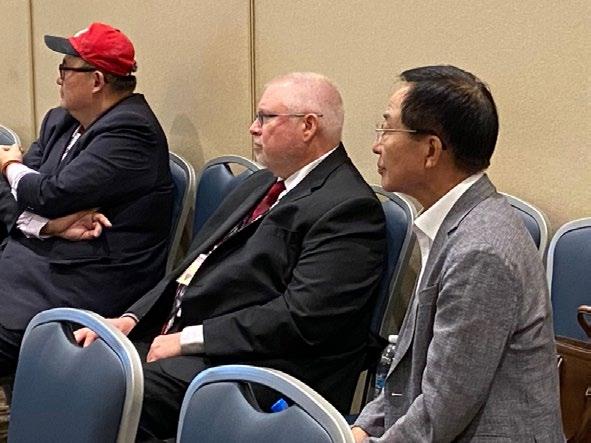



美國錢幣協會(American Numismatic Society,即 ANA)在過去 5年中,每 年都在芝加哥附近的伊利諾伊州羅斯 蒙特市的同一會議中心舉行年度國際 錢幣展銷會。2022年8月中旬,巨大的 斯蒂芬斯會議中心再次向幣商安排了 450多張展位,供1 000多名幣商及他 們的員工參加這個為期 6天的活動。由 於其位置靠近主要城市,國際錢幣展 銷會也成為了美國為期一周的錢幣銷售

活動和宣傳教育的聚集地。此次由於
我忙於宣傳和銷售我的書,所以從週二
到週六,每天都需要親赴展會。 我在過去 5年中,每年都參加了在這個 地方舉行的國際錢幣展銷會。因此, 我對這個會議中心非常熟悉 包括 會議中心前面那條相當危險的道路。
在我参加美国钱币协会展会的那一周 里,于周三受邀参加了一个在市中心举 行的会议,从斯蒂芬斯会议中心到芝 加哥市中心大约 20 分钟车程,与从绍 姆堡镇出发的车程相比,缩短了差不 多10 分钟。到达后我有幸与《东亚泉 志》的周迈可和韩国的 J.C. Lee 及其 员工在一家著名的高档餐厅见面。出 席会议的还有 AIM 的托马斯 迈克尔 (Thomas Michael)。由于周先生的推 荐,J.C. Lee 慷慨地同意让华东公司 作为我的书代销商在韩国的官方经销 商在那里销售。因此,李先生大方地 安排了这次午餐,这是我们自2019年 夏天最后一次见面后再次进行联系。 东亚钱币界两位最具影响力的人物都 出席了这次午餐会,他们的谈话相当
有启发性。最有趣的亮点是,我了解到
在韩国政府放开当地黄金交易后,J.C. Lee 曾在20 世纪80年代末领导 Golden dew 公司,而此前韩国的黄金交易是 相当受限制的。Golden dew 公司于 1973年作为美国的金币经销商起家, 到1989年 J.C. Lee 管理公司时,已经 开始向韩国的新贵们零售珠宝,而这 些新贵们已经开始欣赏并购买珠宝作 为时尚饰品。该公司在这一时期出售 的一件值得注意的珠宝,是将一枚金 币装在吊坠空托悬挂在项链上。显然, J.C. Lee 不仅在销售受欢迎产品方面 相当成功,而且他光明正大的商业行 为也使 Golden dew 公司避免冒犯当地 监管者,同时避免触犯他们不断变化的 规则。这点与他同时代那些在韩国售 卖黄金的不幸商人大为不同。 我曾研究1988年汉城奥运会纪念币系 列首次出现时韩国黄金市场的情况。 J.C. Lee 的故事证实了我了解到的许多 情况。关于1988年汉城奥运会系列最
全面的敘述可以在我的書中的第20 章 找到,這是第一次推出含金量達1盎司
的奧運會紀念幣,也是韓國發行的第
一枚真正可替代的、具有投資價值的 金幣,一經發行就非常受歡迎。
我的書在韓國錢幣行業的巨頭華東公 司的大力幫助下得以在韓國發行,這也
讓我能夠更有效地接觸到韓國錢幣的
主要收藏群體。然而,這次會議給我 帶了另一個令人難以置信的機會 我 在會後立即與 AIM 的托馬斯 邁克爾 取得聯繫。邁克爾先生和我坐下來,請
我幫忙更新 Numismaster.com 上的韓 國錢幣目錄。在接下來的幾個月裏,我 們通過電子郵件進行交流,我建議對 Numismaster 目錄進行一些我認為有 幫助且適度的編輯。憑藉邁克爾在該領

雖然前往市中心參加的這次會議很是 愉快,但這並不是我來到芝加哥的主 要原因。此次我是作為一本新書的作 者來到美國國際錢幣展銷會的,我將 利用這個機會宣佈該書的正式發行,並 在展會上向參會者出售。在展會的第 二天,我得以宣傳我的新書,在 ANA 主辦的演講中談論我對韓國錢幣的研 究。當天,ANA 在會議中心贊助了另 外八場30到 45 分鐘的演講。更令人鼓 舞的是,除了我的演講之外,還有另外 兩個關於亞洲錢幣的演講(ANA 亦稱 之為“金錢論壇”)。一場是由戳記幣研 究者高林(Colin Gullberg)主講,另 一場則是 NGC 的現代中國錢幣研究者 麥克 考利(Michael Corley)主講。
過去的 ANA 國際錢幣展銷會中似乎沒 有在一天內舉辦過3 個與亞洲錢幣有關 的演講,更不用說在為期一周的展會 期間舉辦這麼多的演講了,所以這是一 個令人鼓舞的跡象,即 ANA 正在擴大 這些“可接受的演講主題”的範圍。雖 然我早在截止日期之前就提交了申請, 但我的“金錢論壇”舉辦希望渺茫,因 為決定接受或拒絕哪些演講的 ANA 委 員會幾乎拒絕了我的申請。然而,我有 一個了不起的支持者,即 ANA 志願者 山姆 蓋爾伯德(
的身份幫助我準備了“金錢論壇”的房 間,除此之外,他還在這次 ANA 展會 上履行了許多其他職責。
到了演講的時候,我已經準備好了。事
實上,我花了3 個月的時間來起草和
修改我的演講,我將其定為對韓國的 錢幣和錢幣生產的快速概述,這段時 期是韓國國家發展的重要時期,時間 跨度為20 世紀 50年代末至80年代。我 相信,與會者最喜歡的是對這段幾乎 完全不為人知的韓國錢幣歷史的介紹, 以及一些關於當今錢幣市場上一些重 要年代錢幣價格的幻燈片。我準備好 “金錢論壇”演講內容之後,在我去芝 加哥的前一周,我在明尼蘇達州當地 的錢幣俱樂部預演了這個版本的演講, 對它進行了“實地測試”。它深受歡迎, 首次展示的機會使我能夠修改它,以 便在 ANA 展會上進行更好的演講。 由於這些努力,加上一點運氣,我在 國際錢幣展銷會上的“金錢論壇”順 利進行。我甚至有幸請到了周邁可和 J.C. Lee,以及其他著名的觀眾,高林 和吉姆 摩爾(Jim Moores)也從晚上 抽出時間來參加。由於我的韓國錢幣 演講已經經過了很好的調整,後來我 被邀請在次月由錢幣論壇網站 World of Coins(worldofcoins.eu)舉辦的線 上活動中進行演講。而令我驚訝的是, 聖路易斯華盛頓大學的紐曼錢幣門戶
的幣商,這很難兩全。我接觸過的大 多數幣商都對這本書相當感興趣,並購
買了一本或多本。當他們瞭解到這本書
還介紹了韓國最近拍賣和零售的韓國錢
幣價格時興趣尤為濃烈。錢幣定價信
息,以及截至2021年發行的所有紀念
幣的詳細記錄,似乎是這本書的主要
賣點。令我驚喜的是,在 ANA 展會上,
美國主要的第三方評級公司和大多數
大型拍賣公司也購買了這本書,作為他 們對這一主題的主要參考。只有 ICG 和 ANACS 以韓國錢幣評級業務不足為 由,對該書採取了不予購買的態度。 由於週六是展會的最後一天,許多經
幣門戶網站上的許多視頻,特別是他 對書籍作者和企業主的採訪。
由於大衛 利索特先生在他的展位上, 我便和他聊了起來,並告訴他,我非 常喜歡看他過去 40年中對了不起的錢 幣學家的採訪。他曾採訪過世界硬幣 大獎創辦人克利福德 米什勒(Clifford
Mishler)、切斯特 克勞斯(Chester Krause)、朱利安(R.W. Julian)、沃爾
特 布林(Walter Breen)和安東尼 斯沃泰克(Anthony Swiatek),以及其 他許多美國錢幣學界的巨頭。我想讓 利索特先生知道,我通過他從這些人 身上獲得的知識和故事,他的工作使 我受益良多。他顯然很感動,並告訴 我,他很高興能拍攝這些採訪。我還 從他身上嗅到了一絲悲傷,因為他在這 個領域的許多好朋友現在都不在了。
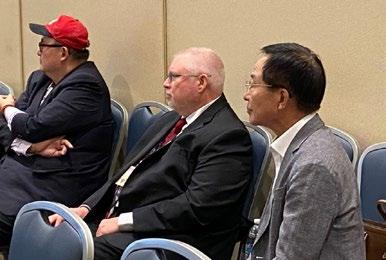
然後他問我關於我正在售賣的書的情 況,並把他的相機架了起來,打開上 面的燈,說:“採訪一下怎麼樣?”我不 得不考慮了一下,然後我同意了。利索 特先生是這種簡短採訪的專家,他讓 我在鏡頭前談論這本書。僅僅從這次 與他的短暫互動中,我發現他說話談 吐文雅,並有力地證明了他的才智與他 所採訪過的那些錢幣學界的大人物幾 乎不相上下!他是一個很好的榜樣。
那天我離開會議中心時,覺得自己已經 完成了所要做的事情,我特別高興能
與大衛 利索特見面並交談。因此,我 對後來得知他在2022年10月15日這麼 快就去世感到非常難過。所有認識他 的人都認為他既是一個善良的人,又 是美國錢幣界的重要人物,不會輕易被 取代。
我在這篇文章中描述的在 ANA 展會上 的新經歷當然不是我新發現之旅的終 點。在 ANA 展會之後的幾個月裏,我 都忙於圖書銷售,並向來自美國和加 拿大各地的客戶,以及遠在瑞典和澳 大利亞的錢幣愛好者運送圖書。我還 忙着接受記者採訪,對我的書進行新 聞回顧,更多的評論有望2023年在《錢 幣週刊》(CoinWeek)和 ONS 等出版 物上刊載。撰寫關於韓國錢幣的書不 僅本身是一次冒險,之後的推廣和銷售 工作也使我接觸到錢幣界一些比較重 要的人,以及對韓國錢幣有濃厚興趣 的收藏家和經銷商。我鼓勵那些有意 願和能力這樣做的人,努力提高他們 在錢幣學領域的能力,因為這是他們 的熱情和興趣所在。 大衛 · 利索特曾在一次採訪中問一位著 名的美國錢幣專家,為什麼他一開始 就進入了錢幣領域,他的回答是:“我 發現錢幣學是一個有點專業知識就能 發揮很大作用的領域。”
我完全同意 !
The Currency of Macau - A Complete Reference (Banknotes) II is published by the Macau Numismatic Society and sponsored by the Macau Foundation, with a print run of 500 copies. ISBN 97899981-893-0-0, 1st printing, November 2022. Contact e-mail: dcdesign772@yahoo.com.hk
I have read and reviewed the book Currency of Macau - A Complete Reference (Banknotes) edited by Mr. Deng Junxiao ( 鄧浚曉 ) and Mr. David Chio ( 趙康池 ), and now I have received the new book Currency of Macau - A Complete Reference(Banknotes)II edited by them.

The book is an exhaustive record of Macau banknotes from the time of their issuance to the present day. The information in the book also includes the signatures on each banknote, issue numbers, serial numbers, supplements, and specimens. The book is divided into two main parts, namely, currency issued by the Banco Nacional Ultramarino and the Bank of China, the two major banks that issued currency in Macau.
In the first seventeen chapters, an introduction of the currencies issued by the Banco Nacional Ultramarino divided into nine series according to age and design, including early ordinary banknotes, early banknotes, paper fractional currencies, vouchers, Templo A-Má, Camões, Avenida do Ouvidor Arriaga, Bishop of Don Carneiro, and Ruínas da Antiga Catedral de São Paulo. There are also two series of banknotes issued by the agent issuing institution and agent bank for the Banco Nacional Ultramarino; another three series were banknotes issued jointly by the Banco Nacional Ultramarino and the Bank of China.
This is covered in a total of fourteen chapters. The next three chapters are about banknotes issued by the agent bank.

The Bank of China section is divided into currencies issued according to the year, that is, 1995-2002, 2002-2003, 2008, and 2013. There are also three chapters about banknote series jointly issued by the Bank of China and the Banco Nacional Ultramarino; and two chapters about commemorative and conjoined banknotes.
The book Currency of Macau - A Complete Reference (Banknotes) II contains hundreds of Macau banknotes with clear photos in undistorted colors; it also provides detailed information on the denomination, design, color, size, issue date, issue copy, issue year, return date and remarks in both Chinese and English. It is extremely easy to search through. The contents and information are very detailed, making it an indispensable tool for the study of Macau banknotes.
The editorial team, with Mr. Deng Junxiao and Mr. David Chio as the editors-in-chief, diligently collected and edited this updated edition based on the first edition published many years ago, with the support and assistance of the Monetary Authority of the Macao SAR, the Macau Branch of the Bank of China, the Macau Archives, and many scholars and collectors. It fills the gap in the historical information of banknotes in Macau for more than 100 years and makes an outstanding contribution to the study of Macau currency and the presentation of Macau culture.
◎ Zhou Bian〔Shanghai〕
The Annals of China Gold Coin Corporation 1987-2017, ISBN978-7-5196-0264-2, Tel: 010-63584556 (Editorial Department), Website: www.edpbook.com.cn. Price: RMB 380.
I recently read a book documenting the history of the development of the precious metal commemorative coins in China, The Annals of China Gold Coin Corporation 19872017 by its editorial committee, published and distributed by Economic Daily Press in December 2017.

China Gold Coin Corporation was established in 1987, and celebrated its 30th anniversary in 2017, marking an important milestone in the development of China's precious metal commemorative coin business. During this period, a total of 10 major themes, more than 410 items, and 2,100 varieties of precious metal coins were offered for sale, forming a gold and silver coin management, design, minting, and marketing system with Chinese characteristics. A total of 12 coins have won international and domestic awards, and the panda gold and silver coins have become a well-known brand in the international numismatic market. Rich in national characteristics and artistic style, Chinese precious metal coins are renowned worldwide. Besides, the social and economic benefits of Chinese precious metal commemorative coins have been a win-win for both domestic and foreign coin collectors and amateurs, as these products are highly favored by them.
This book is divided into 25 chapters, detailing the approval and planning of the project, design, production, marketing, and publicity, the commemorative coin design management and production process, and the establishment and development of the marketing and publicity system. It also covers the management and history of the company’s finance, investment, and gold business. There is also an overview of the construction and development of personnel and administrative affairs, information, inspection, party building, and cadre work. Seven chapters, from 17 to 23, introduce the profiles of the seven
organizations under China Gold Coin Inc., namely, China Great Wall Coins Investments Ltd., China Gold Coin Shenzhen Distribution Center, Beijing Kaiyuan China Gold Coin Distribution Center, Shenzhen Guobao Minting Co., Beijing Xinwen Times Gold Coin Culture Communication Co., Ltd, Shanghai Gold Coin Investment Co., Ltd, and Beijing Zhongjin Guoheng Collection Coin Appraisal and Grading Co. After these sections the secretariat, figures, and events are introduced. The appendix contains documents related to the establishment and development of the head office and subordinate institutions, regulations of the People's Republic of China on the administration of RMB, the list of Chinese precious metal commemorative coins (1987-2016), the best of Chinese precious metal commemorative coins, awards and related products, and explanations of common terms used in modern Chinese precious metal commemorative coins.
The Annals of China Gold Coin Corporation 1987-2017 was completed with the full cooperation of all departments and subsidiaries of the company. After the compilation, arrangement, and supplementation by the editorial committee, the information recorded in the book is accurate, systematic, and complete, and it comprehensively and exhaustively records the development history of China Gold Coin Corporation. It is a good book worth recommending for studying and understanding the history of Chinese precious metal commemorative coins.


◎ 周 邊〔上海〕
最近閱讀了一本記載中國貴金屬紀念幣發展歷史的行業志 書⸺�《中國金幣總公司志1987-2017》。該書由《中國金幣 總公司志》編委會編寫,經濟日報出版社 2017年12月出版 發行。 1987年成立中國金幣總公司,到 2017年30 華誕,是中國貴 金屬紀念幣發展事業的一個重要的里程碑。期間,共發行 了十大題材、410 多個項目、2 100 多個品種的貴金屬紀念幣, 形成了具有中國特色的金銀幣管理、設計、鑄造及行銷體 系。先後有12個幣種榮獲國際國內大獎。熊貓金銀幣成為
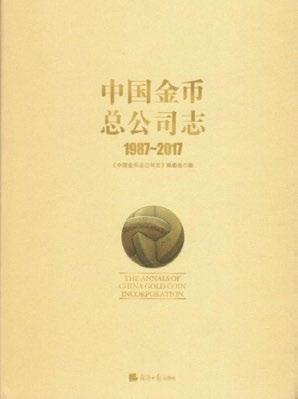
◎ Chen Hongyu〔Chengdu〕
The Kashgar Mint designed and minted Guangxu silver coins in the late Qing dynasty of four denominations, namely, one mace, two mace, three mace, and five mace. Since the early Guangxu silver coins did not have Chinese characters to show the place of minting on the obverse, only the four characters which mean Guangxu silver coin, and two characters to show the denomination, it is known as the six-character silver coin in the numismatic community (figure 1). As for the one-mace six-character silver coin, it can be divided into five types according to dates, including undated, AH 1310, AH 1311, AH 13X9, and AH 1322. In AH 1313, the Kashgar Mint made a major change to the inscription of the Guangxu silver coin, that is, the Chinese characters that refer to Kashgar
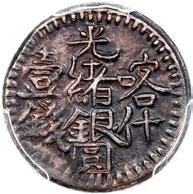

Due to my interest in Xinjiang coins, I have been a keen visitor the major coin and auction websites to collect pictures of rare Xinjiang coins. When collecting the pictures of the one-mace six-character silver coins of various years, I happened to find an AH 13X9 coin on the PCGS website (figure 3). According to my experience, one-mace six-character silver coins were minted from early AH 1310 to AH 1312, and the Kashgar Mint produced the Guangxu silver coins with the place name Kashgar on the obverse after AH 1313, with only a small number of long-flower varieties restruck in AH 1322. This AH 13X9 six-character one mace coin is somewhat mysterious. As it is hard to identify the year of this coin
were added to the obverse (figure 2). Since then, the sixcharacter silver coins retired from history, and Kashgar Guangxu silver coins were minted in the following eight years.
through the image on the PCGS official website, driven by my curiosity I followed the trail to find the SBP website to see the original auction records.
Through careful observation of the Moslem calendar date on the coin, it is confirmed that the coin has a palindrome number 9 on the reverse. Yet, the number in front of 9 is a flat, long dot like a teardrop, which is exactly how the palindrome zero is written, so the number can be regarded as both 1 and 0. Since the six-character silver coins with denominations of two mace, three mace, and five mace were not minted after AH 1313, people tend to identify its minting year as AH 1309. After reviewing various
A
Is it an Original Strike from AH 1309 or a Restrike from AH 1319?Figure 1 Undated One-Mace Six-Character Silver Coin Figure 2 AH 1313 Kashgar Guangxu One-Mace Silver Coin
catalogs, I found that the mainstream catalogs (Sinkiang Gold and Silver Coin Catalog, Concise Catalogue of Modern Chinese Vintage Coins, and A Catalog of Chinese Silver Coins) published in recent years all identify the year of this variety of the six-character one mace coin as AH 1309.
When I worked to find the answer, I asked myself several questions:
1. If the undated variety is the original strike, why does only one-mace coin have the date AH 1309 when other six-character silver coins are undated?
2. Is it too subjective to identify it as from 1309 just because of the continuity of four years 1309, 1310, 1311,
According to my experience in collecting Xinjiang coins, I believe that this one-mace six-character coin should have been minted in 1319, for the following reasons.
According to the Qing dynasty Wang Shunan edited Xinjiang Record - A Record of Agricultural Economy and Fiscal Situation (《新疆圖志 食貨志》) by Wang Shunan ( 王樹楠 ) in the Qing dynasty, "in the eighteenth year of Guangxu's reign, or AH 1309, Kashgar Intendent Li Zongbin ( 李宗賓 ) ordered alternate county leader Luo Zhengxiang ( 羅正湘 ) to make a trial in minting Guangxu silver coins, to mint one-mace, two-mace, and threemace coins initially, and to mint five-mace coins from the next year." 1
Judging from the existing coins, there are only one-mace, two-mace, and three-mace undated coins, while no fivemace undated coins have ever been found. Therefore, it is clear that the one-mace, two-mace, and three-mace undated coins are indeed coins that Kashgar Intendent Li
Figure 3 The picture of the 13X9 Six-Character One Mace Coin on the PCGS official website

and 1312?
3. Because the Kashgar Mint stopped minting sixcharacter silver coins in AH 1313, it is entirely dependent on logic to think the one-mace six-character coin was minted before AH 1313.
Zongbin asked alternate county leader Luo Zhengxiang to mint in AH 1309.
After the success of trial minting, the Kashgar Mint minted Guangxu silver coins of four denominations on a large scale in the following year and added the year of the Moslem calendar on the reverse. This shows that the act of adding the year of minting on the reverse of the Guangxu silver coins began in AH 1310. Since the mintage of the undated one-mace six-character coin had already been completed, there is no reason for the Kashgar Mint to design another batch of one-mace coin dies with the year AH 1309 added.
The minting crafts and design style allow modern people to understand the ancient coins. By observing the Chinese writing and stroke style of the one-mace sixcharacter coins without date (figure 4), minted in AH 1310 (figure 5) and AH 1311 (figure 6), we can roughly see that undated, AH 1310 and AH 1311 coins were produced with
dies engraved by the same die maker. The second stroke of the character " 壹 " (one) on these three kinds of coins is written down to the left, and the right side of " 緒 " has a downward point. In contrast, in terms of the AH 13X9 one-mace six-character coin (fig. 7), the second stroke of the character " 壹 " is thick and runs down to the right, and the character " 緒 " does not have a dot at the bottom right, which differs greatly from the above three coins. Therefore, it is less likely that the coin was struck around AH 1310.



As evidenced by the existing coin, the Kashgar Mint did not completely stop minting the six-character silver coins after AH 1313. For some reason, the Kashgar Mint re-engraved the dies after many years and minted the famous AH 1322 Xinjiang long-flower variety one-mace Guangxu silver coin (see figure 8), which supports the fact that the one-mace six-character coins were restruck. Therefore, it is not beyond reason that there were AH 1319 one-mace six-character restrike coins.



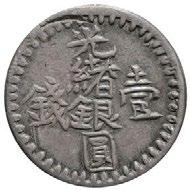
According to my experience, even if the mintage is small, the coins which had been minted and issued in bulk will definitely leave traces in history. I browsed all the major coin websites and finally found a one-mace six-character coin with a repair on the obverse.
Although the obverse of this coin has a small repair, it can still be seen from the font style that it is in line with the one-mace six-character silver coins in the discussion. Its reverse remains in its original state without signs of revising. As for the writing style of Moslem calendar AH 1319, the number written in front of the 9 is the same as the 1 of 13, which is direct proof of the fact that this variety of the one-mace six-character coin was minted in AH 1319 (figure 10).



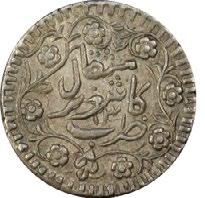

Only the one-mace six-character silver coin appears to have restrikes, and the number of one-mace six-character coins (AH 1310, AH 1311, AH 1319, AH 1322) is even larger than Kashgar Guangxu one-mace silver coins (AH 1313). For this reason, the author assumes that, because of the small diameter of the one-mace die, coupled with the inferior minting conditions in the Kashgar region than in eastern China, the life of the coin dies was shorter and the dies were replaced frequently. To extend the life of the dies and increase the success rate of striking, the Kashgar Mint managers chose to use the coin dies for one-mace sixcharacter coins which had less character inscription and were easier to mint.

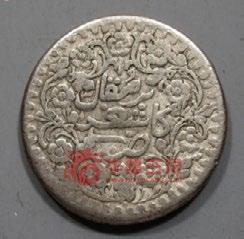
The Kashgar Mint's preference for minting dies with fewer characters is also evident on the one-mace coin. The AH 1310 Guangxu one-mace coin only has four Chinese characters on the obverse (figure 12); the AH 1310 Guangxu one-mace coin without denomination on the reverse only has four Chinese characters on the obverse (figure 13); the AH 1322 Kashgar one-mace with flowers only has four

Chinese characters on the obverse (figure 14); the AH 1323 Kashgar Guangxu Yuanbao one-mace coin only has two Chinese characters on the obverse (figure 15). The above existing coins all support my assumption.
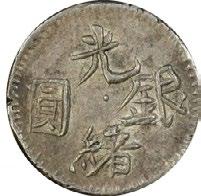
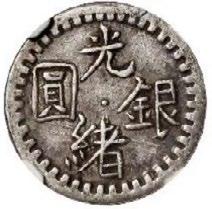



Figure 12
Figure 13
Figure 15 Figure 14
After reviewing historical documents, comparing existing coins, analyzing the shapes and styles, and logical reasoning, it can be determined that the one-mace sixcharacter coin was a restrike in AH 1319, correcting the conclusion in the past sources that it was minted in AH 1309. There are only a few existing AH 1319 one-mace six-character coins, as it is a hard-to-find Xinjiang onemace coin. Almost all known AH 1319 Xinjiang one-mace coins have been repaired, and it is hard to one without repair.
A large number of historical documents from the late Qing dynasty have been lost, which makes the clues to
study Xinjiang coins scarce and fragmented. As is far as possible, the coins should be researched to enhance our knowledge of the history of the time through careful research.


(Special thanks to SBP Hong Kong, Huaxia Ancient Coin Website, and Auction World for providing the images.)

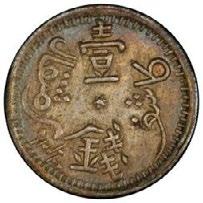


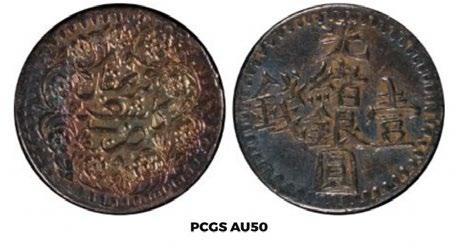
/ 貳錢 / 壹錢存在無紀年版式,而伍 錢從未發現無紀年版式,則可知三錢 / 貳錢 / 壹錢的無紀年 版式確為 AH 1309年喀什道李宗賓令候補知縣羅正湘試辦
























Howard Franklin Bowker (H. F. Bowker, 1889-1970) was an accomplished collector and researcher of Chinese coins, stamps, and banknotes. However, compared to his colleagues Eduard Kann and Arthur B. Coole, Bowker is less wellknown among Chinese collectors. The good thing is that there is already a systematic and in-depth study and description of his life, collection, and writings in the book Howard Franklin Bowker-Numismatic Pioneer (2014). The recent article The Chinese Stamp Collection of Howard Franklin Bowker by Champion reveals how Bowker became involved with Chinese stamps and his experience of collecting Chinese treaty port stamps.
Among the stamps in the Bowker Collection, the specimens for use in Xinjiang are certainly interesting items. There is a significant difference between these stamps and Xinjiang coins, that is, it is difficult to collect Xinjiang coins due to the long distances, as they were manufactured, issued, and circulated in Xinjiang, while it is also noted to obtain the postal specimens for the use in Xinjiang though they were printed and overprinted by an organization designated by the China Post.
The origin of stamps for use in Xinjiang begins in the late Qing dynasty and early Republican period. When the Late Qing reforms was implemented at the end of the Qing dynasty, postal services were created all over the country, including the remote Xinjiang, making modern postal services gradually replace traditional postal services, increased convenience for traders
and people in the border areas. It also made the ancient Silk Road come alive again. However, due to the long and arduous postal routes and high postal costs, the Provisional Regulations on the Discretionary Increase of Postage Fees ( 酌加新省郵 費暫行章程 ) in Xinjiang Province were formulated in 1910, stipulating that postage fees would be increased in Xinjiang at the discretion of the government.
Since the Republic of China, Qing Post was immediately replaced by China Post. Xinjiang had to rely on the issuance of banknotes to maintain market stability after the co-payment system (the system that province, where the balance between income and expenditure could not be balanced in the barren land, provided for assistance by the provinces with rich tax revenue) was abandoned, and at this time Xinjiang had become "a world of paper money"1. In such a financial environment, the stamps issued by China Post were the first to bear the brunt. In the early years of the Republic of China, stamps could be used nationwide in equivalent value, so speculators usually carried out arbitrage from the stamps through the difference between the currency of Xinjiang and the silver dollars used elsewhere in the mainland, which made the postal sector suffer losses. As a response, the postal service created a restriction in the region for the use of stamps as a means of eliminating this loophole.
In 1915, the Chinese postal service began to overprint the words “ for the use in Xinjiang” to show the difference and to restrict circulation, so as to prevent speculation. Such limitation on the
areas for use was later advanced to Guilin, Guizhou, Yunnan, Sichuan, Kirin, Heilongjiang, and many other postal areas.
According to The History of Chinese Postage Stamps ( 中國 郵票史 ), from 1915 to 1949, a total of 26 sets of 267 stamps were issued for use in Xinjiang, as the regional stamp with the largest number of issuance and the longest period of use in the Republic of China. This is quite similar to the Xinjiang coins, which have a wide variety of types and varieties.
The specimens for the use in Xinjiang in the Bowker collection, together with coins of the same period, witnessed a change in history. At the end of 1915, after Yuan Shikai ( 袁世凯 ) was crowned emperor, he changed the name of the country to the Chinese Empire and proposed to issue a commemorative stamp entitled “ The Founding of the Chinese Empire” 2. The stamps were printed by the Bureau of Printing of the Ministry of Finance, with face values of 5 cents, 10 cents, and 50 cents, with a scheduled printing of 2.86 million pieces and a total value of 200,000 dollars. China Post was scheduled to print 160,000 stamps with a total value of 15,000 dollars for the use in Xinjiang. Soon after Yuan Shikai abolished the imperial system due to internal and external pressure, the Chinese Empire stamps printed for him were scrapped before they were issued. The General Post Office requested and then received approval from the Ministry of Transportation and Communications, saying, “ The request is granted, and all existing stamps, except for 2,000 sets overprinted with the 'Specimen', should be destroyed. Officers will be sent to monitor the destruction.” A total of 167,500 stamps for the founding of the Chinese Empire overprinted “ for the use in Xinjiang” were destroyed, valued at 16,625 dollars.3 It is against this backdrop that the specimens of the stamps for the founding of the Chinese Empire overprinted with “ for the use in Xinjiang” from the Bowker Collection have survived.
Also included in the Bowker Collection are eleven specimens
of the 1916 Beijing 1st Edition Junk Stamp overprinted with “ for the use in Xinjiang ” by the Bureau of Printing of the Ministry of Finance in Beijing, covering various face values from half a cent to 10 cents. This stamp is the “1st Edition Junk Stamp overprinted with straight-stroke ‘ for the use in Xinjiang province’”, which is the second time that China Post overprinted the stamp with “ for the use in Xinjiang”, while the first one was the 1915 Beijing 1st Edition Junk Stamp overprinted with the oblique-stroke ‘ for the use in Xinjiang province’
Bowker stayed in Hankou, China, from May 7, 1923, to April 30, 1924, and since then, started his near half-century career as a collector and researcher of Chinese coins and stamps.4As a result of his extensive association with fellow collectors, Bowker maintained contact with many Chinese coin and stamp collectors. From the correspondence between Bowker and Eduard Kann and Arthur Coole, it is clear that Bowker usually commissioned his contacts around the world to acquire the coins he needed by correspondence, and his method of obtaining stamps may have been similar. We can see in the Bowker collection four specimens of the 1923 Constitution Commemorative Stamp overprinted with “ for the use in Xinjiang” and three specimens of the 1924 Beijing 2nd Edition Junk Stamps overprinted with “ for the use in Xinjiang” issued at that time.5
On December 2, 1939, Bowker, who was in New York, wrote to Eduard Kann in Shanghai to find some Chinese coins for him, especially coins from Tibet, Xinjiang, Gansu, Yunnan, and other inland provinces of China.6 On February 10, 1940, Bowker wrote to Arthur Coole in Beijing that he had just purchased a batch of Xinjiang coins, and if he could not purchase the whole collection, he expected to acquire the rubbings of all these coins.7 The word “ Xinjiang ” appears several times in this correspondence series, which shows the
2 The Postage Stamps Catalogue of the Republic of China ed., The Postage Stamps Catalogue of the Republic of China 1912-1949, People's Post and Telecommunications Publishing House, 1990.08, p.217.
3 Editorial Review Committee of the History of Chinese Postage Stamps, Ministry of Information Industry of the People's Republic of China, the History of Chinese Postage Stamps (Vol. 3), Commercial Press, 2004.12, p.63-66.
4 Michael Chou, Ron Guth, and Bruce Smith, A Brief Biography of the Life of Howard Franklin Bowker, Howard Franklin Bowker - A Pioneer in Numismatics, p.7-27.
5 Li Zhenhuan, A Catalog of Chinese Stamps, 1944, p.31.
6 Bruce Smith, Howard F. Bowker - Eduard Kann Correspondence 1939-1949, Journal of East Asian Numismatics, No. 10, p.37-50; Howard F. Bowker - Eduard Kann Letters Part II 1949, Journal Of East Asian Numismatics, No.13, p.28-36.
7 Howard F. Bowker – Arthur B. Coole Correspondence (1937–1967), Journal of East Asian Numismatics, p.50-57.
attraction of Xinjiang coins to Bowker. At the same time, the philatelic market in Shanghai facilitated Bowker's philately.
For example, the 1938 London 2nd Edition Shanghai Sun Yatsen stamps overprinted with “ for the use in Xinjiang” were sold by the set at the Shanghai post office, except for those allocated to Xinjiang postal district for sale.8 The August 1939 issue of China Clipper published A Rare Sun Yat-sen Commemorative Stampwith “Xinjiang”Overprint written by Bowker.9
In the 1940s, the collection and study of stamps for the use in Xinjiang became one of the most popular topics in the postal community, with hundreds of articles published in postal magazines nationwide. For example, Yan Chengfu's ( 嚴澄孚 ) A Brief History of Stamps for the Use in Xinjiang ( 限新省貼 用郵票史略 , in JinzhuPostMagazine 金竹郵刊 , 1943, No. 3), Wan Canwen's ( 萬燦文 ) the Beginning and End of Xinjiang Stamps, ( 新疆置郵始末及限新票拉雜談 , in Jinzhu Post Magazine, 1945, No. 1), Zheng Yi's ( 正義 ) Note to Collectors of Stamps for the Use in Xinjiang ( 收集限新省票者注意 , in TheVoiceoftheNankingPost 陪都郵聲 , 1945, No. 10), etc.
In 1944, Dang Enlai ( 黨恩來 ), a well-known philatelist and author of The Essentials of National Stamps ( 國郵要目 ), and his friends founded the Dihua Amateur Philatelic Society in Urumqi, which later merged into the Yicheng Stamp Society.10 In the Xinjiang Daily ( 新疆日報 ) of September 6 and 7, 1946, the advertisement of the society stated, “Buy and sell all kinds of ancient and modern stamps for the use in Xinjiang”. Sang Xinru ( 桑新如 ) and Yu Donghai ( 于東海 ), who worked for
the Xinjiang Postal Administration, not only reported news of new stamps through postal magazines but also joined wellknown postal societies as off-society members and purchased and sent stamps and used covers on behalf of their counterparts in other regions of China.11
With the arrival of the collecting and research boom, the stamps for the use in Xinjiang have also appeared in major stamp shows and auctions. In 1948, the “ State-owned Stamp Collection” exhibited by the General Post Office of the Ministry of Communications at the Shanghai Post Exhibition included all sixteen unissued specimens of the Beijing 1st Edition Junk Stamps overprinted with “Chinese Empire” and “ for the use in Xinjiang”. 12 The 1948-1949 issue of the Stamp Mail Auction Catalogue ( 郵票通訊拍賣目錄 ) also includes the stamp for the use in Xinjiang13 and the Xinjiang Airmail Used Envelope with Junk Stamps.
To this day, people can still see the real face of the former stamps for the use in Xinjiang through the Collection of the ChineseStampMuseum (1990) ( 中國郵票博物館藏品集 ) . The specimen stamps for the use in Xinjiang has become a great rarity that collectors rarely see. It should be noted that the used covers bearing stamps for the use in Xinjiang are richer in historical information.14 As for the in-depth exploration of the specimens of the stamps for the use in Xinjiang in the Bowker Collection and used envelopes, much still depends on a considerable amount of Bowker research data as yet to be collated and published, which makes us full of excitement.
8 Editorial Review Committee of the History of Chinese Postage Stamps, Ministry of Information Industry of the People's Republic of China, the History of Chinese Postage Stamps (Vol. 3), Commercial Press, 2004.12, p.185.
9 Philatelic Works by Howard Franklin Bowker, Journal of East Asian Numismatics, No.28, p.18-22.
10 Fan Boqin, A Brief History of Philatelic Activities in Xinjiang, Xinjiang Uygur Autonomous Region Post and Telecommunications Administration Office of History and Records, Compilation of Xinjiang Post and Telecommunications History and Records, No.4, 1991.07, p.20.
11 Sun Shaoying, The Philatelic History of China, Beijing Publishing House, 1999.07, p. 272.
12 A Collection of Rare and Precious Stamps from the Shanghai Post Exhibition of the General Post Office of the Ministry of Communications, Xinguang Stamp Magazine, 1948,Vol.15, No.3, p.7.
13 Stamp MailAuction Catalogue, No.17, 1949, p.7-8.
14 The study on the used enveloped with stamps for use in Xinjiang can be referred to author’s articles Siberian Railway Post Roads andTraffic in theWritings ofTianjin Merchants in the Early 20th Century (in Maritime Philately, 2022), Urgent News from the Border:A Glimpse of the Situation in Xinjiang during the Republican Period from the Letter andTelegram of Zhu Ruichi (in Asian Philatelist, 2022 Annual), etc.
2014)一 書對其生平、集藏和著述情況進行了系統而深入的研究和
闡述。近來,冠軍研究室撰寫的《不懈追求於方寸之間⸺�
霍華德 · 佛蘭克林 · 包克先生的郵票收藏》揭曉了包克與中
國郵票結緣的過程,以及其收藏中國“商埠口岸”郵票的 經歷。3
在包克舊藏的眾多郵品中,“限新省貼用”郵票樣票無疑是 個有趣的專題。這種限地區貼用的郵票與新疆錢幣相比有 一個顯著的不同之處,那就是新疆錢幣的製造、發行與流 通均在新疆,由於路途遙遠,致使集藏頗為艱難。而“限 新省貼用”郵票儘管由中華郵政指定的機構印製並加蓋戳 記,但想獲得郵票樣票也絕非易事。 關於“限新省貼用”郵票的由來還要從清末民初說起,清
餉”斷絕後不得不依靠發行紙幣維持市面,此時的新疆“已 成紙幣世界” 4 在這樣的金融環境內,中華郵政統一發行的 郵票首當其衝。因民國初年的郵票為全國等值通用,投機 者遂利用新疆貨幣與內地銀元的差價藉郵票套利的情況屢 有發生,使郵政部門蒙受損失。為此作為郵政部門應對之 策的限地區貼用郵票應運而生,以此來杜絕漏洞。
1915 年起,中華郵政開始在郵票上加蓋“限新省貼用”等 字樣以示區別,限制流通,防止投機,專供新疆郵區使用。 此類限地區貼用郵票後推及桂、黔、滇、川、吉黑 5等多個 郵區。據《中國郵票史》記載:“從1915年至1949年,‘ 限新 省貼用’ 郵票共發行26套267種, 其發行的種類之多, 使用的 時間之長, 為民國限地方貼用郵票之首”。這與種類繁多、版 式龐雜的新疆錢幣頗有幾分相似。
而包克收藏的“限新省貼用”郵票樣票與同時期的錢幣,還 共同見證着風雲變幻的歷史。1915年底,袁世凱稱帝後, 將國號改為中華帝國,擬議發行“中華帝國開國紀盛”紀念 郵票, 6並交由財政部印刷局開印,面值分別為伍分、壹角、
8 由於包克廣結同好,與不少中國錢幣 和郵票收藏家保持聯繫。從包克與耿愛德、邱文明等人的 往來書信可知,包克通常以通訊方式委託各地聯繫人為其 收購所需錢幣,其獲得郵票的方式或許與之相仿。我們可 以在包克藏品中看到當時發行的1923 年憲法紀念“新疆省 貼用”郵票樣票 4 枚和1924 年北京二版帆船“限新省貼用”
郵票樣票3 枚。 9
1939 年12月2日,身處紐約的包克致信在上海的耿愛德為
其尋找一些中國錢幣,尤其是西藏、新疆、甘肅、雲南以
及其他中國內陸省份的錢幣。101940 年2月10日包克致信在
北京的邱文明,稱自己剛剛購買了一批新疆錢幣,如果不能
全部購買,他預計將獲得整批藏品的拓片。11在這組書信輯
中先後多次出現“新疆”一詞,足見新疆錢幣對包克的吸 引力。此外,當時上海的集郵市場也為包克的集郵提供了 便利。如1938 年倫敦二版孫中山像“限新省貼用”的上海 加蓋郵票,除了撥給新疆郵區供窗口出售外,其餘可在上 海郵局集郵臺按套出售。121939 年 8月的《中國剪報》便刊
隨之而來的 20 世紀 40 年代,中國國內的“限新省貼用”郵 票收藏與研究也成為彼時郵壇的熱門話題之一,各地郵刊 陸續刊載的相關文章竟達百篇之多。如嚴澄孚的《限新省 貼用郵票史略》(載《金竹郵刊》1943第3 期),萬燦文《新 疆置郵始末及限新票拉雜談》(載《金竹郵刊》1945第1期), 正義的《收集限新省票者注意》(載《陪都郵聲》1945第10 期) 等佳作不勝枚舉。
1944 年,國內知名集郵家、《國郵要目》的作者黨恩來與友 人在烏魯木齊創辦“迪化業餘集郵社”,後合併為“義成郵 票社”,141946 年9月6日、7日的《新疆日報》刊出“義成郵 票社”廣告稱:“買賣古今各種限新省郵票”。供職於新疆郵 政管理局的桑新如、于東海等人,不但通過郵刊報告新郵 消息,還以外埠會員身份加入知名郵會,並為內地同好代 購代寄郵票和實寄封。15 伴隨着收藏研究熱潮的到來,“限新省貼用”郵票還曾現身 各大郵展和拍賣會。1948 年,交通部郵政總局在上海郵展 展出的“國有郵集”,就收錄有洪憲稱帝北京老版帆船加蓋 “中華帝國”及“限新省貼用”未發行之樣票全組十六種。16 1948-1949 年出版的《郵票通訊拍賣目錄》還收錄“限新省” 郵票17 和“新疆帆船航空三角實寄封”18 等拍品。 時至今日,人們還能憑藉《中國郵票博物館藏品集》(1990)19 目睹昔日“限新省貼用”郵票樣票的真容。各個時期流入民 間的“限新省貼用”郵票樣票,已成為收藏者可遇而不可求 的“滄海遺珠”。應當指出的是“限新省貼用”郵票的實寄封 則承載著更為豐佛的歷史信息。20而關於包克舊藏“限新省 貼用”郵票樣票乃至實寄封的深層次探究,尚有賴數量甚為 可觀的包克研究資料的整理刊布,這足以令人充滿期待。
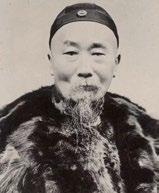
The Ta-Ching Government Bank redeemable notes bearing the portrait of Li Hungchang with the Bank of China overprint (hereinafter referred to as the overprinted Li Hungchang notes) were the earliest currency issued by the Bank of China. The Bank of China should have issued its first banknotes by itself, while it issued these notes by overprinting on the TaChing Government Bank redeemable notes bearing the portrait of Li Hungchang (hereinafter referred to as the Li Hungchang notes) in the vault of the main branch of the Ta-Cing Bank, as there were only twelve days from the approval by the newly established Ministry of Finance of the Republic of China Government to the opening of the Bank of China. At this time, the Bank of China had just opened and replaced the Ta-Ching Government Bank that had ended its business, so the banknotes printed by the Ta-Ching Government Bank could not be issued. Moreover, the market needed enough banknotes as a balance against the political situation which was not yet stable. Therefore, it was too late for the Bank of China to make new banknotes. The Bank of China was established on the basis of the Ta-Ching Government Bank, and it had taken over most of its resources, including the Li Hungchang notes that the Ta-Ching Government Bank commissioned the American Banknote Company to print. When the Qing Government was in power, only a portion of the printed Li Hungchang notes were issued and circulated in the northeast, with many unissued notes of this kind held in the vault. The quickest and most convenient way to meet the urgent needs in the market was to
issue the Li Hungchang notes held in the vault for circulation after overprinting.
The establishment of the Bank of China was prompted by the outbreak of the 1911 Revolution on October 10, 1911. After the outbreak of the revolution, revolutionaries and local officials made active responses. Many places were restored by revolutionaries, and a number of local officials came forward to take a stand and declare independence. The Ta-Ching Government Bank was a joint-stock bank between the government and private businesses with many branches and agencies throughout the country. The shareholders who owned commercial shares of the bank realized that the change of regime would pose the threat of significant losses to their investment in the bank, and this awareness of investment risk made these shareholders realize that they must take immediate action to protect their investment interests. On November 5, 1911, the shareholders of the TaChing Government Bank established an organization, Union of Shareholders of the Ta-Ching Government Bank, in Shanghai, to unite the power of the commercial shareholders of the Ta-Ching Government Bank and to protect their investment interests in the shares. Later, the commercial shareholders found that the name of the organization, Union of Shareholders of The Ta-Ching Government Bank, could not distinguish them from the Qing Government, and it could not show clearly that they are commercial investors. On December 4, 1911, the shareholders of
the commercial shares changed the name from the Union of Shareholders of the Ta-Ching Government Bank to the Union of Commercial Shareholders of the Ta-Ching Government Bank (hereinafter referred to as the Union), so that the name of the organization could not only draw a clear line with the Qing Government but also cater to the future policy arrangements of the new government.
On January 1, 1912, Dr. Sun Yat-sen ( 孫中山 ) was sworn in as the first provisional president of the Republic of China in Nanking and the capital was set up in Nanking. At this time, the Nanking Government, which had started everything from scratch, did not yet have a central banking institution belonging to the government. Against this backdrop, the members of the Union aimed at this once-in-alifetime opportunity, so they wrote to Dr. Sun Yatsen in the name of the Union in early January 1912, pointing out that since the new government had been established, while the market was still in a state of uncertainty, a government central bank should be set up immediately. They also stated that given the TaChing Government Bank was the central banking institution of the Qing Government, the original TaChing Government Bank was renamed the Bank of China which became the central bank of the new governmen. Moreover, the Ta-Ching Government Bank had many branches throughout the country, with a mature and stable business as well as good experience in acting as the Treasury, so it was the best basis for being restructured into the central bank of the new government. On January 24, 1912, Dr. Sun Yat-sen authorized the Ministry of Finance to reply to the Union, approving the change of the original Ta-Ching Government Bank into the Bank of China. At the same time, Wu Ting-ch'ang ( 吳鼎 昌 ) and Hsueh Sung-ying ( 薛頌贏 ) were appointed as the supervisor and deputy supervisor to establish the Bank of China in Shanghai. On January 28, 1912, the Union held a meeting in Shanghai. It was decided that the shareholders would form the Provisional
Board of Directors and Supervisors of the Bank of China, assisting Wu and Hsueh appointed by the Nanking Government in formulating the Liquidation Department of Ta-Ching Government Bank and that the Provisional Board of Directors and Supervisors would be given the authority to manage all the affairs of the Bank of China.
On February 1, 1912, the Bank of China published for the first time in the Shun Pao (《申報》), under the name of the Bank of China, an advertisement for a ceremony to be held on February 5, 1912, at the former site of the Ta-Ching Government Bank at 3 Hankow Road, Shanghai, and its commencement of business to the public. On the same day, the TaChing Government Bank also published in the Shun Pao that the Union of the Ta-Ching Government Bank shareholders had jointly resolved that the TaChing Government Bank would close its accounts, cease operations, and liquidate its business on February 2, 1912. At 10:00 a.m. on February 5, 1912, the Bank of China held its inaugural ceremony at the former site of the Ta-Ching Government Bank, 3 Hankow Road, Shanghai, with the Financial Minister Chen Chintao ( 陳錦濤 ) and Wu Ting-ch'ang, the first Supervisor of the Bank of China, presiding over the opening ceremony. Wu recommended Song Han-chang ( 宋漢 章 ), former manager of the Shanghai branch of the TaChing Government Bank, to be the first Manager of the Bank of China. On the same day, it was officially opened to the public.
It only took twelve days for the Bank of China to be established, from approval to preparation, from formation to the inauguration. Due to the rushed time, it lacked sufficient conditions to print new banknotes and retrieve the defunct Qing banknotes to balance the market. At the same time, merchants and citizens were worried that the banknotes they had would become waste paper overnight and they would suffer a loss when the old and new governments changed. They all asked to cash the banknotes they had or exchange them
for banknotes of the new government. Since the Bank of China had opened to the public as the central bank of the new government, it had the responsibility of being a high-level financial department, acting as the national treasury. The Bank of China must not make the merchants lose confidence in the new government's financial and currency exchange system. When the Bank of China first opened, it was imperative to issue new banknotes to balance the market in addition to dealing with the redemption of military banknotes, as it was the most effective way to prevent the collapse of the merchants' confidence in the financial and currency exchange system.
Confronted with such an urgent need, there was not enough time to print new banknotes. The Bank of China planned to overprint the unissued Li Hungchang notes in the vault to stamp for circulation as the Bank of China notes to meet the urgent needs of the financial market and to build the confidence of the merchants in the banknote exchange system. In order to issue the overprinted Li Hungchang notes to merchants and citizens, a full reserve was set up. In other words, if a merchant wanted to redeem the above-mentioned overprinted notes, the Bank of China would have full reserves to cash them at any time. Due to the full reserves and good cashability, the merchants were happy to accept and circulate the overprinted Li Hungchang notes, and the Bank of China thus had less pressure on the banknote redemption from the merchants.
The Li Hungchang notes were banknotes redeemable for silver dollars and printed by the American Banknote Company on behalf of the Ta-Ching Government Bank (1908-1909). The banknote was well printed with quality paper. At that time, the TaChing Government Bank was planning to put them into circulation throughout the country. This series of notes had five denominations, namely, 1 dollar, 5 dollars, 10 dollars, 50 dollars, and 100 dollars, and the size of each note was designed according
to the denomination. On the obverse, a bust of Li Hungchang, a minister of the Ching government, was printed on the left side, and different designs of famous buildings or sceneries were on the right. It was printed with "Ta-Ching Government Bank Redeemable Note" in Chinese at the center of the note, and "printed in the first year of Xuan Tung's reign" at the bottom of the center. As for the reverse, five different scenic spots of the Qing dynasty are in the center respectively, and the full name of the bank, "THE TA-CHING GOVERNMENT BANK", was printed above the center, with the date "1st October 1909" in English at the bottom of the center. The obverse of the note had corresponding denominations in Chinese in prominent places, while the reverse was in Arabic numbers and English letters. All Li Hungchang notes were finely printed on special banknote paper developed by the American Banknote Company, which is tough and durable. Paired with the engraved steel intaglio printing technology, it produced a clear and detailed printing effect, difficult to counterfeit. When the Ta-Ching Government Bank commissioned the American Banknote Company to print this series of Li Hungchang notes, it requested the American Banknote Company to reserve the place for Chinese and English place names to be printed as well as the place for Chinese seals and signatures of the issuers on both sides, considering the fact that there was no uniformity in the exchange market throughout the country at that time, and it would cause confusion due to the difference in financial exchange rates if the notes were not differentiated by places. The full set of Ta-Ching Government Bank Li Hungchang notes was printed in a variety of colors according to the denomination, being beautiful and colorful.
All Li Hungchang notes commissioned to the American Banknote Company were printed and shipped back to China, and the Ta-Ching Government Bank distributed them to its branches in each province to be stocked and ready for issuance. The banknotes were first used in the northeast region on a trial basis.
Although branches in other parts of the country had already received the Li Hungchang notes, they had not yet been approved by the Ta-Ching Government Bank for circulation. According to the existing Li Hungchang notes, it is known that the notes with the place names of Fengtien, Kirin, and Yingkou had been issued and circulated. After examining the numbers of existing issued and circulated notes and comparing them with the number of the existing notes overprinted with the Bank of China that have been found, it has been confirmed that only a small number of the Li Hungchang notes were issued and circulated in Northeast China at that time. Judging from the small number of issues and the few places where they were issued, the circulation period of the Li Hungchang notes must have been very short; the actual issue date must have been in the second half of the third year of Xuan Tung's reign, not immediately after the "first year of Xuan Tung's reign" as printed on the banknotes. When the banknotes circulated in Northeast China, they met the 1911 Revolution, which broke out on October 10, 1911, so their circulation had not been promoted to the whole country. As a result, the regional branches did not have the opportunity to issue the Li Hungchang notes but to keep them in the vaults. Therefore, the Bank of China established later had a considerable number of unissued Li Hungchang notes to be put into circulation after overprinting.
The Li Hungchang notes had five denominations, namely the 1 dollar, 5 dollar, 10 dollar, 50 dollar and 100 dollar. According to the needs of the situation, the Bank of China only used the notes of three denominations for circulation after overprinting, the 1 dollar, 5 dollar and 10 dollar, while the two other higher denomination notes were never used for circulation. On February 5, 1912, the Nanking Republican Government appointed Wu Ta-ch'an ( 吳 達詮 ) and Hsueh Hsien-chou ( 薛仙舟 ), as the chief supervisor and deputy supervisor, to Shanghai to take the lead in reorganizing the Shanghai branch of the Ta-Ching Government Bank into the Bank of China
in cooperation with members of the Provisional Board of Directors and Supervisors of the Bank of China. Therefore, Shanghai was the place where the head office of the Bank of China was first established, and Song Han-chang, the former manager of the Shanghai branch of the Ta-Ching Government Bank, was recommended for the position of manager of the Bank of China. In the beginning when there was no time to issue new notes, the unissued Li Hungchang notes in the bank's reverses were overprinted to be Bank of China notes and circulated in the market to solve the financial shortage in the market and fulfill the duty of the central bank of issuing banknotes. This was the earliest currency issued by the Bank of China, and the first phase for the overprinted Li Hungchang notes to be issued. The overprinted Li Hungchang notes are also known as the 'Li Portrait Banknote' due to its unique design of Li Hungchang.
From February 1912 to 1917, the Li Hungchang notes were issued seven times in two phases. To differentiate these notes, they were classified into three types according to their different forms of overprinting. Type A was issued in the first phase, during the peace negotiations between the Republic of China and the Qing Government. At the time when the Bank of China was just established, the Ta-Ching Government Bank in the areas controlled by the Qing government throughout the country were still running, while there were no branches of the Bank of China reorganized from the branches of the Ta-Ching Government Bank except for Shanghai where the Bank of China was set up and Nanking where the branch of the Bank of China was launched on February 14, 1912.
During the period from February 5, 1912, to August 1, 1912, before the Peking Head Office of the Bank of China was established in Peking, there were regional limitations led by the political situation and the division of the financial system. In these circumstances, Type A banknotes were issued not only to redeem military notes during the 1911 Revolution, but also to maintain the confidence of businessmen and people in
the financial system.
The Type A notes issued at the very beginning had a very limited scope of circulation, only in the provinces of Kiangsu and Chekiang. Later, the political situation gradually stabilized and more branches of the Bank of China were established in various places, so the Type A notes came to have wider circulation and perform their function as currency. The Type B and Type C notes were issued in the second phase. The initial issuance date should be August 1, 1912, when the Head Office of the Bank of China was established in Beijing. Since the Bank of China had a strategy to unify the banknote patterns and there was a common feature of the existing Type B and Type C notes that many of them had the name of places, these two types of notes were undoubtedly issued after the Republican Government unified the North and South and implemented the new policy. Moreover, the Bank of China had already set up branches in many places at this time. In this case, the overprinted Li Hungchang notes were issued for circulation in various places in the second phase. In this stage, the circulation period and scope of Type B and Type C notes, from August 1912 to June 1917 in cities of all sizes, was longer and wider than those of Type A. The most recent existing overprinted Li Hungchang note was an undated Peking 1-dollar Type C note with the signature of Hsu Enyuan ( 徐恩元 ), who served as President of the Bank of China from 1916 to 1917. This proves that at least some of the Type C notes issued in the second phase were still in circulation from 1916 to 1917. In addition to the overprinted Li Hungchang notes with names of common places, the 1912 Heihe 1-dollar Type B note was the note issued in the most remote place, a city located on the border between Russia and China. All these banknotes testify to the long circulation period and wide circulation range of the Type B and Type C notes in the second phase.
The three types of overprinted Li Hungchang notes issued in two different phases were divided into seven
different issues as follows.
1. [1912 Type A Note with the Name of Place] (Figure 1)
2. [1912 Ordinary Type B Note] (Figure 2)
3. [1912 Type B Note with the Name of Place] (Figure 3)
4. [1912 Ordinary Type A Note Overprinted to be the Note with the Name of Place] (Figure 4)
5. [1913 Type B Note with the Name of Place] (Figure 5)
6. [1914 Chilhi Type C Note] (Figure 6)
7. [Undated Type C Note with the Name of Place] (Figure 7)
8. [8A, 8B, 8C ,The repot of Type A, B, C records.]
The largest overprint on Type A notes is parallel horizon lines, Type B large ink flowers, and Type C small ink flowers. The overprint forms of Type B and Type C are similar, but the size of the ink flower is different.
Position: Member of the Standing Committee of the Banknote Committee of the Chinese Numismatic Society

Secretary of Chinese Banknote Exhibition Committee
President of Hong Kong Chinese Ancient Banknote Society
Academic Works:
In 2012, co-authored the Exhibition of Historical Chinese Paper Money (China Financial Publishing House)
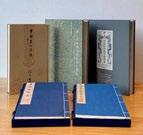
In 2015, co-authored the Second Exhibition of Historical Chinese Paper Money (China Bookstore Press)
In 2016, co-authored A Catalog of Chinese Business Seals(Taiwan Strait Publishing Group)
In 2016, co-authored A Catalog of Chinese Business Seals (Swen edition)
Figure 1
Figure 2
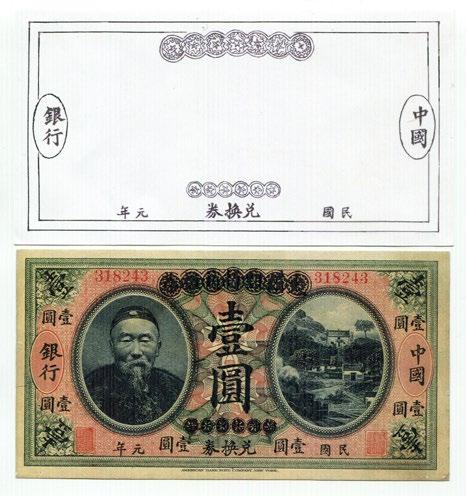

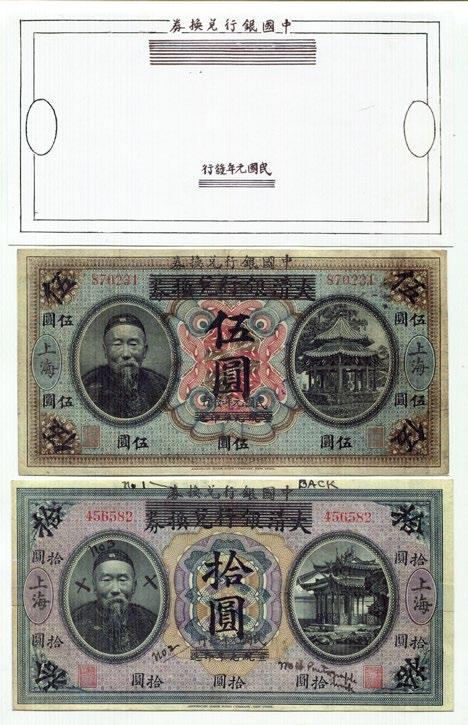
Figure 3 Figure 4

Figure 6
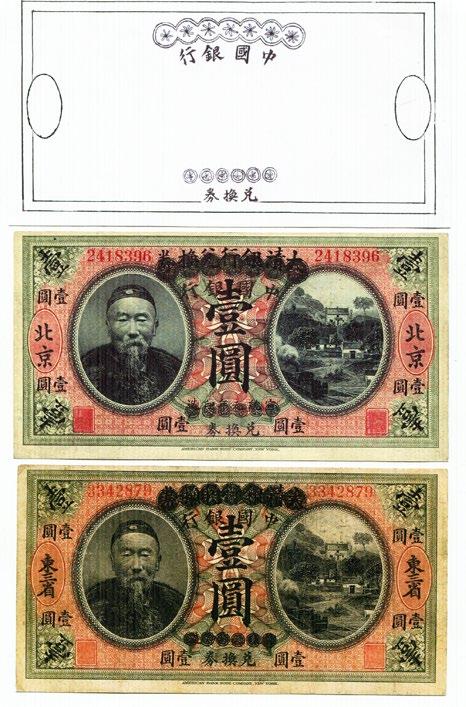
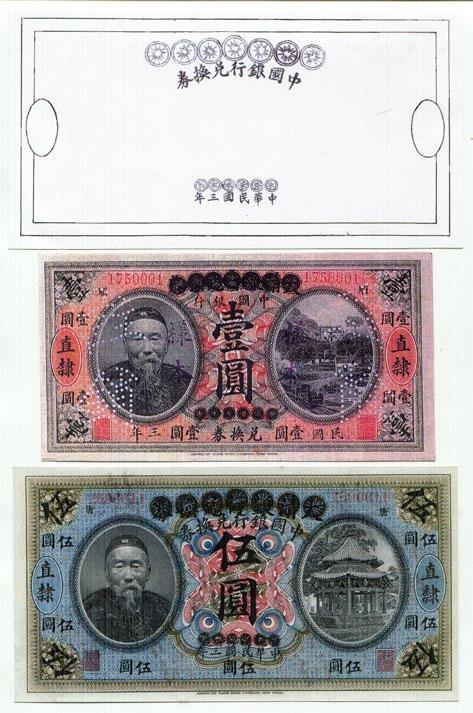
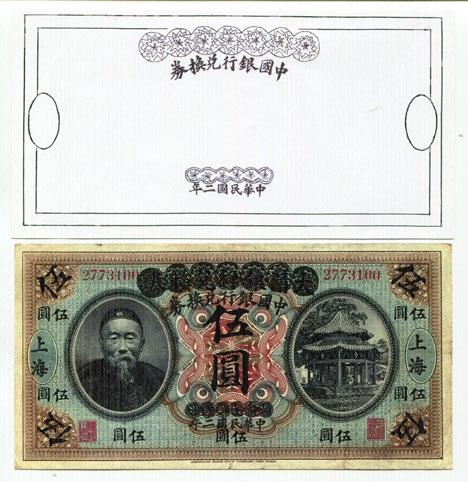

Figure 5
Figure 7
8A The Numbers of Existing 10-Dollar Ta-Ching Government Bank Redeemable Notes Bearing the Portrait of Li Hungchang with the Bank of China Overprint
As of May 1th 2003
No. Serial Number Year·Place Type and Overprint Type Condition and Pedigree
1 440052 1912·Shanghai 1912 Ordinary note overprinted with the name of place
A Hong Kong·Alex Fung Collection
2 456582 1912·Shanghai (Specimen for submission) A Hong Kong·Alex Fung Collection
3 487076 1912·Shanghai 1912 Ordinary note overprinted with the name of place A Shanghai·Shanghai Museum
4 541485 1912·Shanghai (Punch specimen)
A Nanjing·The Second Historical Archives of China
A Japan·Mr. Isamu Morimoto Collection 6 570777 1912·Shanghai 1912 Ordinary note overprinted with the name of place A Shanghai·Ma Dingxiang Collection 7 655582 1912·Tientsin (Punch cancellation)
5 571959 1912·Shanghai (Punch cancellation)
B Japan·former Mr. Isamu Morimoto ( 森本 勇 ) Collection 8 662976 1912·Tientsin 1912 Ordinary note overprinted with the name of place B Chengli Stamp and Banknote Journal 9 694396 1912·Tientsin (Punch cancellation)
B Shanghai·Shanghai Branch of the People's Bank of China 10 694398 1912·Tientsin (Punch specimen) B Beijing·China Numismatic Museum 11 575158 1912·Honan (Punch specimen) B Japan·former Mr. Isamu Morimoto ( 森本 勇 ) Collection 12 580713 1912·Honan (Punch specimen) B Shanghai·Shanghai Branch of the People's Bank of China 13 614001 1912·Honan (Overprinted specimen) B Beijing·China Numismatic Museum 14 629852 1912·Shantung (Overprinted specimen) B Shanghai·Shanghai Branch of the People's Bank of China 15 629853 1912·Shantung (Overprinted specimen) B Beijing·China Numismatic Museum 16 675065 1912·Kankow (Overprinted specimen) B Shanghai·Shanghai Branch of the People's Bank of China 17 675066 1912·Kankow (Overprinted specimen) B Beijing·China Numismatic Museum 18 675074 1912·Kankow (Overprinted specimen) B Japan·former Mr. Isamu Morimoto ( 森本 勇 ) Collection
of May 1th 2003
No. Serial Number Year·Place
Type and Overprint Type Condition and Pedigree
1 700553 1912·Shanghai 1912 Ordinary note overprinted with the name of place A Shanghai·Shanghai Branch of the People's Bank of China 2 735936 1912·Shanghai 1912 Ordinary note overprinted with the name of place A 3 766213 1912·Shanghai 1912 Ordinary note overprinted with the name of place A 4 870231 1912·Shanghai 1912 Ordinary note overprinted with the name of place A Nanjing·The Second Historical Archives of China 5 874586 1912·Shanghai 1912 Ordinary note overprinted with the name of place A 6 1218998 1912·Shanghai 1912 Ordinary note overprinted with the name of place A 7 1239976 1912·Shanghai 1912 Ordinary note overprinted with the name of place A Hong Kong·Alex Fung Collection 8 1248874 1912·Shanghai 1912 Ordinary note overprinted with the name of place A World Banknote Catalog 9 614783 1912·Shanghai 1912 Ordinary note overprinted with the name of place B Shanghai·Shanghai Museum 10 889259 1912·Shanghai 1912 Ordinary note overprinted with the name of place B 11 1309915 1912·Shanghai 1912 Ordinary note overprinted with the name of place B 12 833729 1912·Beijing 1912 Ordinary note overprinted with the name of place B Taipei·Prof. Hsu Yih-Tzong Collection 13 1188563 1912·Beijing 1912 Ordinary note overprinted with the name of place B 14 1194364 1912·Beijing 1912 Ordinary note overprinted with the name of place B 15 1409249 1912·Beijing 1912 Ordinary note overprinted with the name of place B Hong Kong·Alex Fung Collection 16 1498258 1912·Beijing 1912 Ordinary note overprinted with the name of place B Japan·former Mr. Isamu Morimoto ( 森本 勇 ) Collection 17 1000464 1912·Tientsin (Punch Cancellation) B Beijing·Head office of the Bank of China 18 1000466 1912·Tientsin (Punch Cancellation) B Shanghai·Shanghai Branch of the People's Bank of China 19 1005169 1912·Tientsin (Punch Cancellation) B Japan·former Mr. Isamu Morimoto ( 森本 勇 ) Collection 20 460080 1912·Honan (Punch Specimen) B 21 462655 1912·Honan (Punch Specimen) B Shanghai·Shanghai Branch of the People's Bank of China 22 462657 1912·Honan (Punch Specimen)
Shanghai·Shanghai Branch of the People's Bank of China 23 487611 1912·Honan (Punch Specimen) B Beijing·Head office of the Bank of China 24 401344 1912·Shantung (Punch Specimen) B Beijing·Head office of the Bank of China 25 401400 1912·Shantung (Punch Cancellation) B Shanghai·Shanghai Branch of the People's Bank of China
26 1051164 1912·Kankow (Punch Cancellation)
27 1051165 1912·Kankow (Punch Specimen)
B Shanghai·Shanghai Branch of the People's Bank of China
B Shanghai·Shanghai Branch of the People's Bank of China
B Beijing·Head office of the Bank of China 29 1051167 1912·Kankow (Punch Specimen)
28 1051166 1912·Kankow (Punch Specimen)
30 2773100 1913·Shanghai 1913 Ordinary note overprinted with the name of place
31 1100004 1913·Chihli (Punch Specimen)
32 2620049 1913·Shanghai [Qi] 1914 Chihli note
33 2645913 1913·Shanghai [Bao] 1914 Chihli note
34 2650056 1913·Shanghai [Shun] 1914 Chihli note
35 2660002 1913·Shanghai [Shi] (Punch Cancellation)
B Japan·former Mr. Isamu Morimoto ( 森本 勇 ) Collection
B Hong Kong·Alex Fung Collection
B Beijing·Head office of the Bank of China
C Japan·former Mr. Isamu Morimoto ( 森本 勇 ) Collection
C Hong Kong·Alex Fung Collection
C Hong Kong·Cheng His-ming Collection
C Beijing·Head office of the Bank of China
36 2670008 1913·Shanghai [Cang] 1914 Chihli note C Hong Kong·Ni Ta-chang Collection
37 2604020 1913·Shanghai [Luan] (Punch Specimen) C Hong Kong·Alex Fung Collection
38 2690011 1913·Shanghai [Tang] 1914 Chihli note C Hong Kong·Alex Fung Collection
8C The Numbers of Existing 1-Dollar Ta-Ching Government Bank Redeemable Notes Bearing the Portrait of Li Hungchang with the Bank of China Overprint
As of May 1th 2003
No. Serial Number Year·Place Type and Overprint Type Condition and Pedigree
1 318243 1911·Bank of China 1912 Ordinary note B Hong Kong·Alex Fung Collection 2 318249 1911·Bank of China 1912 Ordinary note B Shanghai·Shanghai Branch of the People's Bank of China 3 373109 1911·Bank of China 1912 Ordinary note B 2003 Guardian Auction Catalog 4 4000065 1911·Bank of China (Punch cancellation) B Beijing·China Numismatic Museum 5 445679 1911·Bank of China 1912 Ordinary Note B 2003 Guardian Auction Catalog 6 385669 1911·Bank of China/ Beijing 1912 Ordinary note overprinted with the name of place B Beijing·China Numismatic Museum 7 471707 1911·Bank of China/ Beijing 1912 Ordinary note overprinted with the name of place B
8 628340 1911·Bank of China/ Beijing 1912 Ordinary note overprinted with the name of place B Beijing·China Numismatic Museum
9 681985 1911·Bank of China/ Beijing 1912 Ordinary note overprinted with the name of place B
10 695627 1911·Bank of China/ Beijing 1912 Ordinary note overprinted with the name of place B
11 712257 1911·Bank of China/ Beijing 1912 Ordinary note overprinted with the name of place B
12 766155 1911·Bank of China/ Beijing 1912 Ordinary note overprinted with the name of place B
13 823290 1911·Bank of China/ Beijing 1912 Ordinary note overprinted with the name of place B
14 807002 1911·Bank of China/ Tientsin 1912 Ordinary note overprinted with the name of place B Shanghai·Shanghai Branch of the People's Bank of China
15 807003 1911·Bank of China/ Tientsin 1912 Ordinary note overprinted with the name of place B Beijing·Head office of the Bank of China
16 807008 1911·Bank of China/ Tientsin 1912 Ordinary note overprinted with the name of place B Japan·former Mr. Isamu Morimoto ( 森本勇 ) Collection
17 898304 1911·Bank of China/ Tientsin 1912 Ordinary note overprinted with the name of place B World Banknote Catalog
18 1041755 1911·Bank of China/ Tientsin 1912 Ordinary note overprinted with the name of place B 19 1070298 1911·Bank of China/ Honan (Overprinted with black “ Honan ” on the left and red on the right) B Beijing·Head office of the Bank of China
20 1155845 1911·Bank of China/ Honan 1912 Ordinary note overprinted with the name of place B Shanghai·Shanghai Branch of the People's Bank of China 21 1155857 1911·Bank of China/ Honan 1912 Ordinary note overprinted with the name of place B Shanghai·Shanghai Branch of the People's Bank of China 22 1155872 1911·Bank of China/ Honan 1912 Ordinary note overprinted with the name of place B Shanghai·Shanghai Branch of the People's Bank of China 23 1205326 1911·Bank of China/ Heihe 1912 Ordinary note overprinted with the name of place B 24 1336500 1911·Bank of China/ Shantung 1912 Ordinary note overprinted with the name of place B Zhang Ansheng Collection 25 1336601 1911·Bank of China/ Shantung 1912 Ordinary note overprinted with the name of place B Beijing·Head office of the Bank of China 26 1600149 1914·Chihli[Qi] 1914 Chihli note C 27 1750001 1914·Chihli[Shun] 1914 Chihli note C Shanghai·Shanghai Branch of the People ’ s Bank of China 28 1750056 1914·Chihli[Shun] 1914 Chihli note C Japan·Mr. Isamu Morimoto Collection 29 1850002 1914·Chihli[Cang] 1914 Chihli note C Beijing·Head office of the Bank of China 30 1850009 1914·Chihli[Cang] 1914 Chihli note C Hong Kong·Ni Ta-chang Collection 31 1920403 1914·Chihli[Cang] 1914 Chihli note C 32 1950026 1914·Chihli[Luan] 1914 Chihli note C Hong Kong·Cheng His-ming Collection 33 2109528 1914·Chihli[Tang] 1914 Chihli note C Hong Kong·Ni Ta-chang Collection 34 2370221 Beijing Undated note with the name of place C 35 2418396 Beijing 1914 Chihli note C Hong Kong·Alex Fung Collection 36 2467250 Beijing 1914 Chihli note C 37 2513452 Beijing 1914 Chihli note C Beijing·Head office of the Bank of China 38 2535427 Beijing 1914 Chihli note C 39 2671366 Beijing 1914 Chihli note C Japan·Mr. Isamu Morimoto ( 森本勇 ) Collection 40 2709958 Beijing (Punch specimen) C Shanghai·Shanghai Branch of the People ’ s Bank of China 41 3291309 Manchuria 1914 Chihli note C Beijing·Chinese Numismatic Society 42 3342879 Manchuria 1914 Chihli note C Hong Kong·Alex Fung Collection 43 3385367 Manchuria 1914 Chihli note C Taipei·Prof. Hsu Yih-Tzong Collection
大清銀行(李鴻章像)兌換券加蓋中國銀行兌換券是中國 銀行發行的第一種紙幣。這種紙幣是中國銀行將庫存中的 大清銀行(李鴻章像)兌換券加蓋改作中國銀行兌換券後 發行。中國銀行在第一次發行紙幣的時候未能夠自行印製, 而是利用大清銀行(李鴻章像)兌換券加蓋後發行,其原 因是中國銀行從獲得新成立的中華民國政府財政部批准建 立到開業,前後只有12天時間,加上當時的政局尚未穩定,
市面需要足夠的紙幣來平衡。大清銀行既已結束營業,取 而代之的中國銀行亦已開業,過去的大清銀行紙幣故然不 可以再發出。而且,中國銀行亦來不及趕制自己的紙幣。中 國銀行是在大清銀行的基礎上建立出來的,承接了大清銀 行的絕大部分資源,包括當年大清銀行向美國鈔票公司訂
印的大清銀行(李鴻章像)兌換券。這批已經印就的兌換 券在滿清政府的時候,只在東北地區簽發流通一部分,仍 有部分未經簽發的兌換券存放於庫。最快捷便利的方法,
以與滿清政府劃清界線,也迎合了將來新政府的政策安排。 1912 年1月1日,孫中山先生於南京宣誓就職中華民國第一 任臨時大總統,同時設國都於南京。這時候的南京政府, 一切由頭開始,尚未設有屬於政府的中央銀行機構。大清 銀行商股的股東們也瞄準了這個千載難逢的機會,於1912 年1月初,以“大清銀行商股聯合會”的名義上書孫中山先 生,指出新政府既已成立,市面金融尚在彷徨階段,設立 一家國家性質的中央銀行已事不宜遲。並表示大清銀行是 清政府之中央銀行機構組織,政局既已有取而代之之勢, 理應承接正統,建議將原有之大清銀行改為中國銀行,並 重新組織作為新政府的中央銀行;況且大清銀行於全國的 分行支構眾多,遍佈甚廣,業務成熟穩健,又有代理國庫 業務的良好經驗,是改組成新政府中央銀行的最好基礎。 1912 年1月24日,孫中山先生授權財政部以書面批復“大清

銀行亦在上海《申報》刊登了一則經“大清銀行股東聯合會” 共同議決後,大清銀行將於1912 年2月2日起收賬,停止營 業,並且實行清理業務的廣告。1912 年2月5日上午10 時整, 中國銀行在上海漢口路三號大清銀行舊址舉行成立大會, 由財政總長陳錦濤及中國銀行首任監督吳鼎昌主持開幕典 禮,吳鼎昌推薦了前大清銀行上海分行經理宋漢章出任該 行第一任經理。1912 年2月5日 , 中國銀行在上海正式封外 營業。 中國銀行的成立,從批復到籌辦;從組成到對外營業,前 後歷時僅
新的紙幣作為對已經結業的大清銀行紙幣的回收,及平衡 市面。與此同時,由於正值新舊政府交替,商民都擔心自己 手持的紙幣會一夜之間變成廢紙,招致損失,均會要求將 手上持有的紙幣兌現或兌取新政府的銀行紙幣。中國銀行 既然已經對外營業;又是新政府的中央銀行,更有高度金 融和代理國庫之責,決不能令商民對新政府的金融制度和 兌換貨幣失去信心。中國銀行開業之初,除了要應付軍用 紙幣兌現兌換外;當務之急必須立即印發新的紙幣來平衡 市面⸺�這是防止商民對金融制度和兌換貨幣信心崩潰的 最有效方法。
而從大至小排列。其正面圖案:中間是大寫面額,左邊均 為清政府大臣李鴻章的半身人像,右邊則按照不同面額分 別印有不相同的著名建築物或風景圖案,上方為“大清銀 行兌換券”、下方為“宣統元年印造”字樣。其背面圖案: 中心位置印有五處不同的大清國的名勝景點,上方為大清 銀行的英文全稱“ THE TA-CHING GOVERNMENT BANK”;下方為英文的印造日期“1st OCTOBER 1909”;用阿拉伯數字及英文字母組成的不同面額,也印在 多處顯眼的位置。全套大清銀行 ( 李鴻章像 ) 兌換券是採 用雕刻鋼凹板技術精印而成,鈔紙用的是美國鈔票公司研 製印鈔專用紙。這種特殊的紙幣紙質具有堅韌耐用的特點, 配上使用雕刻鋼凹版印刷技術印製,既能產生清晰細緻的 印刷效果,更有難以仿造的防偽手段的優點。大清銀行委 託美國鈔票公司印造這套大清銀行(李鴻章像)兌換券的 同時,考慮到當時全國各地有洋厘行市並不劃一,如果不 按地方區分,屆時兌換券在全國流通的時候,則會產生金
融上的匯水差異問題而引致混亂。故此,大清銀行特別要 求美國鈔票公司在紙幣的正面和背面,分別預留了在發行時 候需要加印上去的中英文地名位置和在發行時才簽發印上 去的中文印章和發行人員簽名位置,以便在不同地方由不 同的發行人員在發行時印上不同地名和簽署發行流通。全 套大清銀行(李鴻章像)兌換券按照面額的不同並配印多 種不同的顏色,繽紛豔麗,十分美觀。
所有委託美國鈔票公司印製的大清銀行(李鴻章像)兌換券 在印成後便悉數運返中國,大清銀行也將之分配到各省各 地所屬的大清銀行分行中庫存,以備發行之用。大清銀行 (李鴻章像)兌換券在東北地區首先試行使用,國內其他地 區的分行雖然已領有該兌換券,但仍未獲得大清銀行總行 批准簽發流通。根據目前所見之該兌換券存世實物的情況 來看,已知有奉天、吉林和營口等地名券被簽發流通。查 看這些已簽發流通之存世實物的號碼,將其與已被發現的
期。大清銀行(李鴻章像)兌換券加蓋中國銀行兌換券因
大流通範圍,發揮其貨幣流通功能。乙種券和丙種券是李 像券在第二個階段發行的紙幣。最初發行的時間應自1912 年 8月1日中國銀行北京總行成立或以後,按中國銀行計劃 統一發行紙幣式樣的策略,和存世實物中的乙種券和丙種 券並存有多種地名券的共同特點來看,乙種券和丙種券無 疑是在民國政府完成南北統一施行新政後;而且,中國銀 行並且已在多處地方設有分行,在這樣的情況下,所發行 流通於各地的第二個階段的乙種券和丙種李像券流通時間 和流通範圍,與第一階段的甲種券作比較,流通時間較長, 範圍亦較廣。乙種券和丙種券的流通時間大概自1912 年 8月 至1917年 6月,而流通範圍遍及各大小城市。其流通最晚時 期的存世實物見有“丙種不署年份壹圓券”的北京地名券, 該券印有1916 年至1917年任職中國銀行總裁徐恩元的英文 署名。這樣,至少證明尚有第二階段所加蓋發行的丙種券
於1916 年至1917年仍然在加蓋發行流通。另外,存世實物 中除已見有多種不同加蓋地名券外,尚見有“乙種元年壹圓 通用券改作券”的黑河券為最偏遠的地名券。黑河,是位 於中俄邊境的一座偏遠城市。這些實物都印證了第二階段 時期的乙種券和丙種券的漫長流通時間和流通範圍的廣泛。
前後二個階段所加蓋發行的甲種券、乙種券、丙種券合共

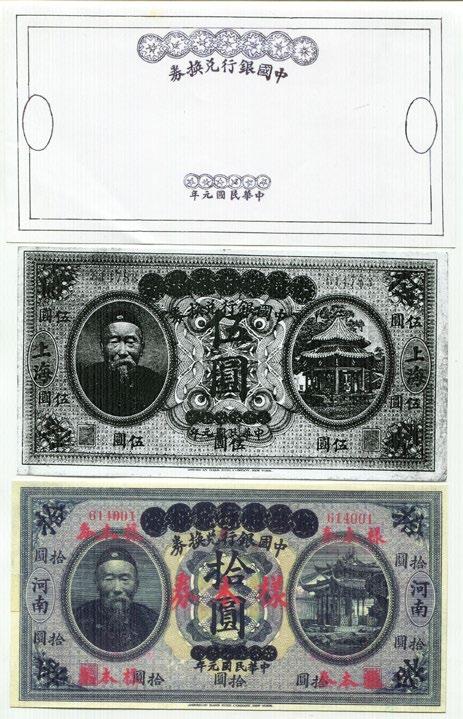






券別及狀況 券種 保存狀況與源流 1 440052 元年 上海 元年地名券 甲 香港 馮乃川舊藏 2 456582 元年·上海 ( 帝像券製版呈樣券 ) 甲 香港·馮乃川舊藏 3 487076 元年 上海 元年地名券 甲 上海 上海市博物館 4 541485 元年·上海 ( 打孔見本 ) 甲 南京·中國第二歷史博物館 5 571959 元年 上海 ( 打孔註銷 ) 甲 日本·Mr. Isamu Morimoto ( 森本勇 ) 舊藏 6 570777 元年·上海 元年地名券 甲 上海·馬定祥舊藏 7 655582 元年 天津 ( 打孔註銷
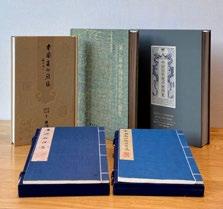

5 874586 元年·上海 ( 打孔見本 ) 甲
6 1218998 元年 上海 元年地名券 甲
7 1239976 元年·上海 元年地名券 甲 香港·馮乃川舊藏
8 1248874 元年·上海 元年地名券 甲 《 世界紙幣目錄 》
9 614783 元年 上海 元年地名券 乙 上海 上海市博物館
10 889259 元年·上海 元年地名券 乙
11 1309915 元年·上海 元年地名券 乙
12 833729 元年 北京 元年地名券 乙 臺北 許義宗舊藏
13 1188563 元年·北京 元年地名券 乙
14 1194364 元年·北京 元年地名券 乙
15 1409249 元年 北京 元年地名券 乙 香港 馮乃川舊藏
16 1498258 元年·北京 元年地名券 乙 日本·Mr. Isamu Morimoto ( 森本勇 ) 舊藏
17 1000464 元年·天津 ( 印孔註銷 ) 乙 北京·中國銀行總行
18 1000466 元年 天津 ( 印孔註銷 ) 乙 上海 中國人民銀行上海分行
19 1005169 元年·天津 ( 印孔註銷 ) 乙 日本·Mr. Isamu Morimoto ( 森本勇 ) 舊藏
20 460080 元年·河南 ( 印孔樣本 ) 乙
21 462655 元年 河南 ( 印孔樣本 ) 乙 上海 中國人民銀行上海分行
22 462657 元年·河南 ( 印孔樣本 ) 乙 上海·中國人民銀行上海分行 23 487611 元年·河南 ( 印孔樣本 ) 乙 北京·中國銀行總行 24 401344 元年 山東 ( 印孔樣本 ) 乙 北京 中國銀行總行 25 401400 元年·山東 ( 印孔註銷 ) 乙 上海·中國人民銀行上海分行 26 1051164 元年·漢口 ( 印孔註銷 ) 乙 上海·中國人民銀行上海分行 27 1051165 元年 漢口 ( 印孔樣本 ) 乙 上海 中國人民銀行上海分行 28 1051166 元年·漢口 ( 印孔樣本 ) 乙 北京·中國銀行總行 29 1051167 元年
》
4 400065 元年·中國銀行 ( 打孔註銷 ) 乙 日本·Mr. Isamu Morimoto ( 森本勇 ) 舊藏
5 445679 元年·中國銀行 元年通用券 乙 《 中國嘉德 2003 年拍賣目錄 》
6 385669 元年 中國銀行 / 北京 元年通用券改作地名券 乙 北京 中國錢幣博物館
7 471707 元年 中國銀行 / 北京 元年通用券改作地名券 乙
8 628340 元年 中國銀行 / 北京 元年通用券改作地名券 乙 北京 中國錢幣博物館
9 681985 元年·中國銀行 / 北京 元年通用券改作地名券 乙
10 695627 元年·中國銀行 / 北京 元年通用券改作地名券 乙
11 712257 元年 中國銀行 / 北京 元年通用券改作地名券 乙
12 766155 元年 中國銀行 / 北京 元年通用券改作地名券 乙
13 823290 元年 中國銀行 / 北京 元年通用券改作地名券 乙
14 807002 元年·中國銀行 / 天津 元年通用券改作地名券 乙 上海·中國人民銀行上海分行
15 807003 元年·中國銀行 / 天津 元年通用券改作地名券 乙 北京·中國銀行總行
16 807008 元年 中國銀行 / 天津 元年通用券改作地名券 乙 日本·Mr. Isamu Morimoto ( 森本勇 ) 舊藏
17 898304 元年 中國銀行 / 天津 元年通用券改作地名券 乙 《 世界紙幣目錄 》
18 1041755 元年 中國銀行 / 天津 元年通用券改作地名券 乙
19 1070298 元年·中國銀行 / 河南 ( 左 “ 河南 ” 加印黑色 , 右加印紅色 ) 乙 北京·中國銀行總行
20 1155845 元年·中國銀行 / 河南 元年通用券改作地名券 乙 上海·中國人民銀行上海分行
21 1155857 元年 中國銀行 / 河南 元年通用券改作地名券 乙 上海 中國人民銀行上海分行 22 1155872 元年 中國銀行 / 河南 元年通用券改作地名券 乙 上海 中國人民銀行上海分行 23 1205326 元年 中國銀行 / 黑河 元年通用券改作地名券 乙 24 1336500 元年·中國銀行 / 山東 元年通用券改作地名券 乙 澳門·張安生藏 25 1336601 元年·中國銀行 / 山東 元年通用券改作地名券 乙 上海·中國人民銀行上海分行 26 1600149 三年 直隸 [ 祁 ] 三年直隸冠字券 丙 27 1750001 三年 直隸 [ 順 ] 三年直隸冠字券 丙 上海 中國人民銀行上海分行 28 1750056 三年 直隸 [ 順 ] 三年直隸冠字券 丙 日本·Mr. Isamu Morimoto 舊藏 29 1850002 三年·直隸 [ 滄 ] 三年直隸冠字券 丙 北京·中國銀行總行 30 1850009 三年·直隸 [ 滄 ] 三年直隸冠字券 丙 香港·倪達彰舊藏
patterns, and can sometimes cover the coin. These chopmarks had the purpose of acting as a guarantee, and were often a kind of "secret code" among merchants that only they knew.
Fig. 1 Various Foreign Coins with Chopmarks Introduced into China in the Qing dynasty
Modern Western coins were introduced into China in the late Ming dynasty, at the turn of the 16th and 17th centuries, and gradually penetrated into the commercial activities of the southeast coast and the middle and lower reaches of the Yangtze River.
Merchants used to identify the authenticity and purity of foreign coins with chopmarks. The behavior was initially interpreted as a distrust of foreign things; however, afterward, counterfeit imitations flooded the market and inspection and chopping became a necessary testing method because there were a lot of mainly local counterfeiters.
Chopmarked coins are a distinctive thing in the history of Chinese currency. The chopmarks on coins differ in size and shape, including different Chinese characters, symbols, and
Regarding accepting foreign coins as a form of currency, there was a process for Chinese to learn, understand and inherit the experience, and several textbooks compiled by locals have become a significant source of relevant knowledge.

The textbooks which are often mentioned include The Secrets of Silver (1826 edition), IdentificationofRealForeignCoins (the first edition has an unknown author and date, the 1854 edition was written by Yen Ching and Zhou Weixin from Kuaiji, and the 1867 edition from Tsuimantong of Hangzhou Qinghefang), General Study of Silver (the first edition composed in 1885 by people from Quzhuangshan, Shanghai)2, The Study of NewlyAdded Silver (the date of the first publication and the author are unknown, it was reissued in 1876), as well as several other texts.
What kind of information do chopmarks show? In 2001, I discussed this question in several articles1, which sparked widespread discussion and attention. English source texts were also translated into French and Spanish for publication. This article, based on previous articles, is a summary. I have added additional content. Note
In addition to introducing the types, sources, texts, features,
1 Please find more relevant content of chopmarked foreign silver coins on www.sycee-on-line .
2 Masui Tsuneo; Chinese Silver and Merchants. Kenbunshuppan. February, 1986.
and pictures of foreign silver coins for beginners, the shroff guidebooks in the past were focused on the approaches on how to identify counterfeits and taught strategies to identify these coins as the rampant casting of counterfeits was widespread at that time. 3 The shroff guidebook The Secrets of Silver [ 銀經發秘 ] could represent the former. It lists 45 physical or chemical methods to identify counterfeits, including [translating literally from the Chinese] 'slightly white' (weibai 微白 ), 'large white' (dabai 大白 ), 'low white' (dibai 低白 ), 'water money' (shuiqian 水錢 ), 'letter money' (xinqian 信錢 ), 'mud letter money' (nixinqian 泥信 錢 ), 'high clip low' (gaojiadi 高夾低 ), 'clip lead' (jiaqian 夾鉛 ), 'clip copper' (jiatong 夾銅 ), 'clip ring tin' (jiaxiangxi 夾響錫 ), 'clip copper' (jiatongqian 夾銅鉛 ), 'sitting lead' (zuoqian 坐 鉛 ), 'plug lead' (chaqian 插鉛 ), 'nail lead' (dingqian 釘鉛 ), 'thin-skin copper' (bopitong 薄皮銅 ), 'medium skin copper' (zhongpitong 中皮銅 ), 'thick skin copper' (houpitong 厚皮銅 ), 'thicker skin copper' (jiahoupitong 加厚皮銅 ), 'polished copper' (jingguangtong 精光銅 ), 'copper nail lead' (tongdingqian 銅釘 鉛 ), copper inlaid with silver makeup' (tongxiangyinzhuang 銅 鑲銀粧 ), 'copper inlaid with silver buttons' (xiangyinkoutong 鑲銀扣銅 ), copper inlaid with heart (baxintong 拔心銅 ), 'mirror inlaid copper' (jingxiangtong 鏡鑲銅 ), 'inlaid half-face' (xiangbanmian 鑲半面 ), 'large inlaid heart' (daxiangxin 大鑲 心 ), 'small inlaid heart' (xiaoxiangxin 小鑲心 ), 'copper covered with silver' (tongbianyin 銅遍銀 ), 'silver inlaid three-part copper' (yinxiangsanfenyitong 銀鑲三份一銅 ), 'nailed copper' (dintong 釘銅 ), 'nail grain' (dinli 釘粒 ), 'bilge' (changdi 艙 底 ), 'silver surface' (yinmian 銀面 ), 'filed edge' (cuoban 挫邊 ), 'scorched water' (jiaoshui 焦水 ), 'soil cast' (tuzhu 土鑄 ), 'sand hook money' (shagouqian 沙勾錢 ), 'foreign bronze' (yangtong 洋銅 ), 'coat' (dayi 大衣 ), 'hook money' (gouqian 勾錢 ), 'large mouth' (shuokou 碩口 ), 'charcoal' (hantan 含炭 ), 'smoother surface' (huamian 滑面 ), 'sour white' (suanbai 酸白 ), 'scorpion' (keyong 胢臃 ). The latter, Identification of Real Foreign Coins [ 洋銀弁正 ] displays the nine most detailed strategies
Fig. 2 TheSecretof Silver ( 銀經發秘 ). [Published in the Yichou year of the Rule of the Tong-Yi Emperor 1865-66]
to identify foreign coins, including identifying purity, design, field, rim, sound, chopmark, size, thickness, and weight.
Identifying the foreign coins by sight and sound [the 'ring'] are the most common ways; however, counterfeiting tricks changed daily, constantly becoming more and more sophisticated, so in order to confirm whether the coin contained copper or lead destructive methods like using knives or axes were used on the coins or applying chopmarks become necessary ways to ensure the coin didn't contain copper or lead. Shroff guidebooks at that time viewed chopmarks as one of the approaches to recognize the foreign coins, which made future generations of collectors curious about the individual meanings of the words, symbols, patterns, etc. However, the secret chopmark belonged to the memory of the shroff and was not included in the shroff guidebooks.
Nonetheless, The Secret of Silver did not reveal the existence of chopmarks at that time. In fact, there were two different models of chopping foreign silver coins, one in Soochow and Fujian and the other in Guangdong. Behind the numerous chopmarks there was a regional law.
3 .Lin Zexu ( 林則徐 ); Regulations by Lin Zexu ( 林文忠公政書 ) Manuscripts from Jiangsu Province, Volume 5: there is no foreign money in Soochow, and it is said that “the silver in the mainland was infused with patterned silver, imitated to cast foreign silver, and named as Suban ( 蘇板 ), wuchuang ( 吳莊 ), and xiban ( 錫板 – tin plate). However, the original purpose of falsification/imitation was to make a profit, and it must be mixed with copper and lead, and then a profit can be made...". According to the text, fake foreign silver coins were from local areas at that time.


The Secrets of Silver states: "Dayi ( 大衣 ), also known as Dayin ( 大印 ), which is a real foreign coin. If it was like a new coin without text and design on it, it would be called white minute ['tiny'] chop ( 白微印 ) and is used in Soochow."
New currency without chopmarks in Soochow is called "Dayiyin" ( 大衣銀 ) (Carlos III and IV portrait 8 reales), which are similar to Guangyang ( 光洋 ) or Jingmian ( 鏡面 ) in other places, and is called "white micro chop" ( 白微印 ) locally.
The so-called "Dayi" ( 大衣 ) refers to Carolus III (1759-1788) and Carolus IV (1788-1808). These two 8 Reale coins (equal to a Chinese 7 mace and 2 candareens silver coin) were minted by the government of Colonial Mexico; "xiaoyiyin" ( 小衣銀 ) refers to the silver coins minted after Fernando VII's second accession to the throne (first ruling in 1808, and the second time in 1813-1833), which revised the sculpture and decreased the area of robe. Both Dayi and Xiaoyi were named from the clothing features of the figures on the coins by the locals.

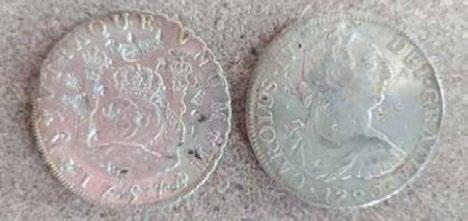
The above types are called 'benyang' ( 本洋 ), also called 'Buddha silver' and 'Buddha head silver' by the Chinese. They were prevalent in the second half of the 18th century and early 19th century. They are also the main type of foreign silver coins in circulation in the period when the 1826 edition of The Secrets of Silver ( 銀經發秘 ), the shroff handbook, was published.
It also mentioned, "... The 'dayiyin' ( 大衣銀 ) which had been used in Soochow must have the small fine character chops made with nails on faces and edges because shroffs in Soochow used the characters or square ink seals as chopmarks, in order not to hurt the silver."4(Fig. 3)
Dayiyin, which was not from the local silver business but spread to Soochow from other places, must be chopmarked. What was used is the small fine character chop made with nails or square ink seals to avoid damage.
4 The Secrets of Silver. 1866.
Fig. 3 Soochow Chopmark - Small, fine character chop made with nails so it won't hurt the silver
Fig. 4 Fernando VII revised version (1813-33), the value in Soochow was lower than other 'Benyang' ( 本洋 ), or foreign coins
Fig. 5 Fujian and Guangdong Chopmarks many large characters, destructive
It also said,"at that time, if you would like to exchange a small robe coin with a foreigner portrait for the micro chop, you need to add a premium and Guaitou ( 鬼頭 , literally 'ghost head') to each coin. How much should be added was not fixed; mostly, 4 to 6 or 7 candareens. It depends on the value of the silver. For example, if there are more than ten characters on the coin's surface, it could be called baidayin ( 白大印 ), which is commonly used in Wuyi ( 武夷 ). Premiums ranging from 1% to 5% should be added to each coin depending on the current price…"
If you would like to exchange xiaoyiyin ( 小衣銀 ) (Fernando VII revised version 1813-33) to exchange for an unchopped 'dayi', you need to add 4 to 6 or 7 candareens of silver to each coin

according to the current price. The coin with more than ten large chopmarks on the surface is called "Dabaiyin," ( 大白印 –'big white chop') which was circulated around the Wuyi area of Fujian. When used in exchange, each coin must be supplemented with 1% to 5% of silver according to the current price.(Fig. 4)
It also said, "...There is also a kind of coin called a 'qingdayiyin' ( 輕大衣銀 'light coat silver'), with several characters on it, approximately weighing about six mace and four or five cents. It is also called Chayin ( 茶印 'tea seal/chop') or Chihyin ( 紙印 'paper chop'). It is circulated in Wuyi, Fujian. Most businessmen who earn a living by making tea or paper must use this kind of silver."
There is the other dayiyin ( 大衣銀 ) which is a lightweight version, commonly used by businessmen for large transactions, such as tea and paper, in Fujian. Due to too many chopmarks, the weight became lighter. Each piece was originally about seven mace and two candareens, but became only six mace and four or five candareens.
Summarizing the relevant content of The Secret of Silver ( 銀經 發秘 ), it can be seen that there had been two chopmark 'models' of how foreign coins' silver was verified for a long time:
The Soochow model: The local silver coin industry mainly offered foreign money without chopmarks. Regarding foreign money introduced from other places, only small and thin chopmark or ink chops could be used to avoid damage.
The Fujian and Guangdong model: Taking Wuyi, Fujian as a typical representative, foreign money in circulation must be chopped with dayin ( 大印 ) – or many large chops, which usually caused damage and lowered the weight of the coin. (Fig. 5)
The formation or reason of the two chopmark models is related to the economic situation of their respective regions.
Foreign money was introduced to Fujian and Guangdong first, and replaced local silver ingots as the medium of trade for commodities such as tea and opium, forming a special regional currency phenomenon 5. In view of the thousands of big deals every day, although there were dozens of fake imitation methods, merchants had no time to check them one by one, so chopping them with big chops (da yin 大印 ) had become the most efficient but destructive detection method. In the Qing dynasty, Zhou Tenghu ( 周騰虎 ) said in The Study of Casting Silver Coins ( 鑄銀錢說 )that "the provinces of Fujian and Guangxi will definitely use them badly"6
As for Soochow area, except for the lack of external trade in the early days, silver ingots had not been completely replaced, and various silver ingots still occupied an important position in the local market.7 Foreign money was still mainly used for small transactions. The processing methods of these two types of silver were also different.
There were two chopmark 'models', one in Soochow and the other in Fujian and Guangdong. There were also different foreign coins used in each period.8
Silver Cobs came to the southeast coast in large numbers in the early 17th century. In order to check the silver content, people started splitting and chiseling, but this was quickly replaced by chopping. Since cobs mainly circulated in Fujian (including Taiwan) and Guangdong, the chopmarks on silver cobs were still mainly with the large 'dayin’( 大印 ) type. Although small chopmarks are occasionally found, they were not applied at the same time, and usually appear mixed with large dayin ( 大印 ) chops. Therefore, {I think} the silver cobs with small
5 Reference: Stephen Tai. A Study on SquareTroughs:To Explore the History of Silver Ingots ( 方鏪考-一種歷史銀錠的探索
3: Troughs of Guangdong, Ch. 5: Troughs of Fujian). Potosi Studio. November, 2020.
6 Zhou Tenghu ( 周騰虎 ); The Study of Casting Silver Coins ( 鑄銀錢說 ). The Sequel of Dynasty Compilation ( 皇朝經世文續編
Volume 85. 30 Things in Household Registration:Currency ( 戶政三十 • 錢幣上 ).
7 The manuscript of The Catalog ofYuanbao/Sycee fromVarious Roads ( 各路元寶目錄 ) This work catalogs sycee from Chuyuan Silver in Changchung ( 阊中市 ), Jiangsu ( 江蘇 ) was composed in the late Guangxu ( 光緒 ) period, and lists various ingots circulated in Jiangsu, and their weight, fineness, color, color coat, and pattern,
8 Regarding chopmarks on foreign silver coins from different periods, please refer to: Colin Gullberg, Chopmarked Coins A History. iAsure Group. 2014.
Fig. 6 Numeric mark of "Six" and "Eight" on a silver cob

chopmarks were introduced from the southeastern coastal areas to the Jiangnan ( 江南 ) area where the Soochow chopmark model was used.

In the beginning of foreign money use in China, the main problem that Chinese businessmen faced was not whether the coins could be used directly as currency or not, but how to confirm the standard quality and the actual situation to solve the problem of converting to silver before discussing the value of the piece. A silver cob from my collection can be an example.
This 8 reales silver cob was cast in the period of Philip IV (1621-1665), and has been chopped with multiple chopmarks, one of which is composed of locally used 'Soochow numerals' that appeared many times. After interpretation, the mark is the two characters "six" and "eight". This chopmark means that this piece weighs about seven mace and two candareens, and may be used as six mace and eight candareens of silver. At that time, there might have been a consensus on the purity of silver cobs. On the other hand, one silver dollar is equivalent to six mace and eight candareens of silver. Until the Daoguang period of the Qing dynasty, they had been used in many areas on the southeast coast of China, including Fujian and Taiwan. As a result, the concept of six mace and eight candareens of silver may have started from the 17th or 18th century.
The chopmark was not the result of the individual choice of a few transactions, but the result of a regional law or collective restriction. The chopmark had been successively applied to
silver cross money ( 十字錢 cobs), horse sword ( 馬劍 – Dutch 'Riders’), ’lady with a barrel’( 凭桶 – Peruvian 8 reales), double column dollars ( 雙柱 pillar dollars), Buddhist dollars ( 佛銀 – portrait dollars), ’eagle dollars’( 鷹洋 – Mexican Cap and Rays 8 reales) and other foreign coins in each period. The author of The Secrets of Silver ( 銀經發秘 ) had witnessed the operation of the two chopmark models in Fujian and Guangdong and in Soochow, so the book describes in Soochow, "the side surface must be chopped with small fine character chops made with nails ( 蟻口細字印釘 – 'ant-mouth fine characters'), and in Wuyi, Fujian, "there are large chops - dayin ( 大印 )- on the surface.'
In the process, the silver industry played a crucial role because it was the hub of foreign money supply and demand; however, it's hard to detect its existence because they were not the ones who made the coins.
Yet, from the foreign coins we have, it is still possible to find the footprints left by the shroffs from long ago. Besides the "six and eight' numbers on the cobs mentioned above, which were chopped by shroffs, a "corset or waist-shaped pattern' can be found on a 1 reale cob, the pattern imitating the shape of the "square trough' silver ingot (sycee) which circulated in and around the southeastern provinces of China in the late Ming and early Qing dynasties.9 It was chopped heavily, which shows it belongs to the Fujian-Guangdong style. There is also a 1789 Spanish Carlos IV silver dollar with a "gourd-shaped' chopmark, which belongs to the Soochow model with small fine character chop ( 蟻口細印 – ant-mouth fine chop). Both patterns represent the silver industry at that time.10 Also, most of the chopmarks may be made by shroffs. (Fig. 7)
Fig. 7

The existence of two major chopmark models of FujianGuangdong and Soochow was undoubtedly an obstacle to the circulation of foreign money.
First, it caused the price of foreign coins in the market to be different; one depreciated vis-à-vis the other which was bid up.
In The Study of Casting Silver Coins ( 鑄銀錢說 ), Zhou Tenghu ( 周騰虎 ) said, "The most important thing for businessmen and citizens doing business in Jiangsu and Zhejiang delightfully and conveniently in the market is credibility. If shops keep using the same type of coins and rarely change, it might cause fake castings with various names to manipulate the market. A one-dollar foreign silver coin was one-tael more expensive than the local silver of the same weight. When the foreign coins came out, some viewed it as treasure, and some regarded it as rubbish. Between exchanges, the silver had already been 20% off."11 Foreign coins, which were commonly used in Fujian and Guangdong, were often accepted at a depreciated value in Jiangsu and Zhejiang because of the heavy chopmarks. Compared with the local general silver dollars, the price had dropped by 20%.
The same foreign coins with different chopmark 'models' {i.e. the Soochow vs the Fujian-Guangdong model} are like two different currencies, and there is a price difference. Therefore, both sides would clearly state in advance about the existence of chopmarks on the silver used.
For instance, the attached picture is a draft from Fang Chunmao ( 方春茂 ) who remitted 200 yuan of Guangbenyang ( 光本洋 ) to Shanghai from Fenxi ( 磻溪 ), a tea township in Fujian ( 福 建 ), in the seventh year of the Tongzhi ( 同治 ) period (1868). Since the remittance is related to two places, which belong to Fujian, Guangdong and Soochow chopping models, it is not clear enough to specify the currency type as "Benyang ( 本洋 ). 11 The Secrets of Silver 1866. 12 Lin Zexu. ibid
Therefore, it is further specified as "Guangbenyang" ( 光本洋 ), which is used in the Soochow model, which means to trade with Benyang ( 本洋 ) without chopmarks, so that there will not be a disagreement over the price of the silver.
Although foreign silver coins used in Fujian and Guangdong had been discriminated against and belittled by markets beyond, its heavy chopping method also prevented many unscrupulous people from committing crimes. The picture below (Fig.8) shows a contemporary counterfeit 1810 Spanish Ferdinand VII 8 reales. In order to gain credibility with the public, the surface of the coin was deliberately chopped with multiple chopmarks, but these are as unnatural looking as its silver purity and portrait appearance. The chopmarks repeat the two 'ant-mouth fine' character chops made with nails" of "Da" ( 大 ) and "Ren" ( 人 ). From this, it is speculated that when all kinds of counterfeit coins arrived in Fujian and Guangdong, it was easy to find the differences under the heavy chop dayin ( 大印 ) hammered method; however, it's easy to fake coins in Jiangsu and Zhejiang.
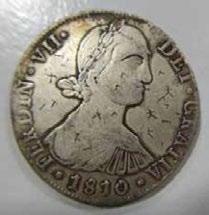
This counterfeit is probably one of the fake foreign 'suban' ( 蘇板 ) coins described by Lin Zexu ( 林則徐 ) during the Daoguang ( 道 光 ) period. He said, "Recently, the public had carefully exchanged and inspected foreign silver. The coins like suban ( 蘇板 ) were totally different from other foreign coins in their purity. No merchants would accept these coins in trade."10 With pros and cons, because neither Jiangsu nor Zhejiang heavily chopped coins, foreign money maintained a high price but also became a target to attack, and made the area the epicenter of counterfeit foreign coins.
Fig. 8 A fake Benyang with Soochow style chopmarks used in the Jiangnan (江南) area
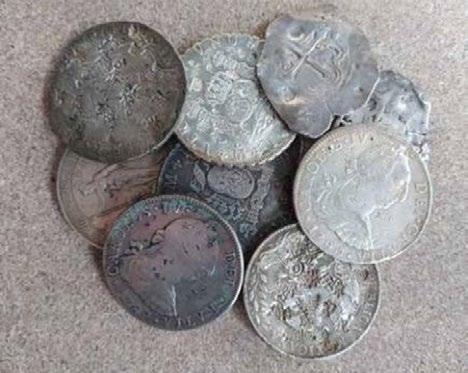


前者,有《銀經發秘》可為代表,共羅列了微白、大白、低白、 水錢、信錢、泥信錢、高夾低、夾鉛、夾銅、夾響錫、夾 銅鉛、坐鉛、插鉛、釘鉛、薄皮銅、中皮銅、厚皮銅、加 厚皮銅、精光銅、銅釘鉛、銅鑲銀妝、鑲銀扣銅、拔心銅、 鏡鑲銅、鑲半面、大鑲心、小鑲心、銅遍銀、銀鑲三份一 銅、釘銅、釘粒、艙底、銀面、挫邊、焦水、土鑄、沙勾錢、 洋銅、大衣、勾錢、碩口、含炭、滑面、酸白、胢臃等 45 種以物理或化學方法偽仿銀幣及偷銀的手法。後者,《洋銀 弁正》探討最詳盡,歸納了定神色、看花紋、觀底板、視 花邊、聽聲音、辨戳印、估大小、論厚薄、推重量等鑒別 洋錢的九大要領。 《銀經發秘》寫道:“大衣又名大印此是真洋銀 , 如新艙面上 無字印者, 名白微印, 蘇州通用。” 蘇州通用嶄新無戳印的“大衣銀”(Carlos III,IV),類似 他處所稱的光洋、鏡面等,當地則稱為“白微印”。
其所謂的“大衣銀”,是指西屬墨西哥鑄造的卡洛斯 III 世 (Carolus III,1759-1788)與 IV 世(Carolus IV,17881808)兩種 8 Reaels 銀幣(合中國的七錢二分銀);“小衣銀”, 則是斐南迪 VII 世(Fernando VII,第一次:1808-1808 , 第二次:1813-1833)於二度即位後所鑄造的同款銀幣,其 頭像進行改款,衣袍所占面積減少。大衣、小衣,顯然是

好奇,戳印上的文字、符號、圖案等,其個別意義為何?因 屬經手商家的暗記,不在各教本的討論範圍之內。
不過,《銀經發秘》卻罕見地透露當時戳印存在的態樣:其 實,洋銀戳印一直存在着蘇州與閩粵兩大不同模式。看似 雜亂無章的無數戳印背後,其實存在着規律⸺�一種區域 性規律。
歸納《銀經發秘》的相關內容,可知在洋錢上長期存在着兩 種戳印模式:

蘇州模式:本地銀錢業以供應無戳印洋錢為主,對於外地 流入的洋錢,也只使用既小又細的戳印或者墨印,以避免 損傷。
閩粵模式:以福建武夷為代表,流通洋錢必蓋有許多大印, 容易造成破壞與失重(圖5)。兩種戳印模式的形成,又應 與各自區域的經濟環境有關。
洋錢流入閩粵的時間最早,也很快就取代當地銀錠成為華 洋之間茶葉、鴉片等經濟商品的交易媒介,形成一種特別 的區域貨幣現象 5 。針對每天動輒萬千圓的大宗買賣,雖 有數十種偽仿手法的威脅,商家無暇逐一檢視,大印重捶, 就成為雖具有破壞性,但也最有效率的檢測手段。清季周 騰虎於《鑄銀錢說》曾言“閩廣各省, 必椎爛用之”6 ,說的 也就是這種情形。
至於蘇州一帶,早期除了缺少對外大宗貿易之外,銀錠尚未 被全面取代,各種銀錠在當地市場仍佔有重要地位 7,洋錢 仍以用於小額交易為主,處理方式也就有所不同。


否直接作為貨幣使用,而是在論枚計值之前,確認成色標 準與實際情形,以解決不符時折合白銀的問題。筆者收藏 的一件十字錢,正好可作為現身說法。 這枚 8 Reales 的十字錢鑄於菲利浦四世(1621-1665)時 期,上面被加蓋了多個戳印,其中有一個由蘇州數碼組成 的印記多次出現。經解讀後,印記為“六八”二字(圖 6)。 這個戳印,意味着這枚重約七錢二分、可能是被當作六錢 八分銀使用。當時,對於十字錢的成色表現,或許已有了 共識。另一方面,一塊銀元折合六八銀,至遲到了清道光 之前,在中國東南沿海包括福建與臺灣等不少地區已成為 定制,如此一來,六八銀的概念,可能是在17-18 世紀就已 開始醞釀。 戳印模式的形成,並非出自少數交易的各別選擇,而是一 種區域規律或集體制約的結果。戳印模式陸續被套用在各 時期的十字錢、馬劍、憑桶、雙柱、佛銀、鷹洋及其他各 式洋錢之上。《銀經發秘》見證過閩粵、蘇州兩大戳印模式


的運作方式,因此才膽敢斬釘截鐵地說:蘇州,“其邊面必 有蟻口細字印釘打”及福建武夷“銀面上有…大印”。
在過程中,銀錢業因系洋錢供需樞紐,是一極具關鍵性的 角色,只不過,因非洋錢的鑄造者,難以察覺其存在。 不過,從洋錢實物之中,往往仍可發現可能是銀錢業者留 下的足跡。除了上述十字錢上的“六八”數碼,出自銀錢業 者所加蓋,在一枚1 Reale 十字錢上,可找到一個“束腰形 圖”戳印,圖案是模仿明末清初東南省份共同流通的“方鏪” (Square Trough)銀錠造型9,戳印重捶入肉,屬閩粵模式。 還有一枚1789 年西班牙卡洛斯四世銀元,有一“葫蘆”圖 案的戳印,屬於蟻口細印的蘇州模式。兩個圖案,正好也 都是當時代表銀錢業的圖騰10 。(圖7)不只如此,大多數的 戳印,可能都與銀錢業者有關。
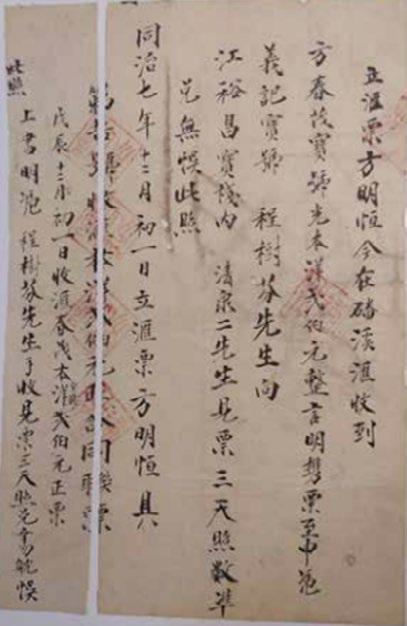


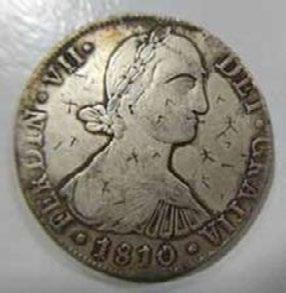
Chinese coinage justly can claim priority as to the dates of issue when compared with the achievements of the Occident. However, this country's bronze coins were not produced by machinery, but were cast into moulds.
China's modern coinage dates back to 1889 only, when the Canton provincial mint began activities; other provincial mints followed suit about one decade later. The output of those coinage plants consisted mainly of silver dollars, silver subsidiary pieces and nickel and copper coins. Side by side with such hard money sycee (silver bullion cast into "shoe" shape) circulated freely in China until its abolition by official Mandate of April 6, 1933, issued by the Central Political Council.
Prior to the production of silver money in China by means of modern machinery large quantities of foreign silver pieces had a wide circulation there. The principal countries of origin were Spain (via the Philippines) represented by the Carolus dollar; the same country and Mexico by the widely circulated Mexican dollar; Hongkong through the British dollar; IndoChina represented by the Saigon paistre; Japan by the silver yen; and the United States who supplied to China the American Trade dollar. Besides, Austrian Maria Theresia Thalers as well as Peruvian, Venezuelan and other American dollar coins were found in circulation in China in the course of the past hundred years. However, all these coins, until comparatively recently, were not accepted by count, but instead by weight only on the basis of their fine content.
Long before the inauguration of the regular minted silver dollars China could boast of such coins. These were not styled "dollars", nor "yuan", but have the inscription "7.2 Mace" in Chinese, a denomination which was maintained for China's future dollar coinage until about 1912. This nomenclature meant that the dollar coins merely were a means of payment put up in a convenient shape, but that they represented a fraction of the sycee tael, viz.,0.72 taels
The immediate cause for the production of a home-made dollar coin was found in warfare. It was in the 17th year of Tao Kwang's reign (1837) that Chang Wen started a revolution in Formosa. For this purpose he needed a uniformly-shaped silver coin. It was of the size of the Spanish Carolus dollar and weighed 7 mace and 2 candareens. This first Chinese silver dollar exists in at least three slightly varying designs, mainly in the reproduction of the God of Longevity. To the left of the deity are, in seal script, the following characters 道古南 鑄 meaning "Cast in the time of Tao Kwang". On the right border, symmetrically arranged and also in seal script, 足紋 銀 , meaning "Silver cake of the standard purity". On the breast of the god are found four characters in ordinary letters 庫平柒 弍 , denoting "Seven two by the Treaty balance." Looking at the reverse one finds in the center a sacrificial vase resting on three feet, surrounded by four characters in Manchu script. Those above and below signify "Formosa". On the left is found the character for Kyahi, probably standing for Kagi, a town situated 40 miles north of Tainan. On the right is seen the Manchu character for Hoo, which possibly is intended for "Treasury". The weight of this coin originally was 417.4 grains troy.
Although the writer possesses an original of this rare coin, it is-owing to long wear and tear--no more in such a condition as to yield a good photographic reproduction. For this reason good drawing are substituted here by courtesy of the publication “Illustrations of Chinese Gold, Silver and Nickel Coins”by C.C. Tsiang.
somewhat indistinct by extensive circulation I have succeeded in obtaining a fairly good photographic reproduction, which is given here.
A second distinctly different type of another Formosa war issue is to be seen in figure 4. Same also weighs 6.8 mace, was issued by Tai Chao-chun during the uprising of Chang Hua in the first year of Tung Chi(1862).
Fig. 1
The second attempt to produce a Chinese-made dollar dates back to 1844, when a dollar piece without ornaments, but merely with Chinese inscriptions, was produced in Changchow, Fukien province. Originally it was 7.4 mace in weight, but soon it was produced in lighter weights, the depreciation aggregating 15 per cent. These coins equally served military needs. They soon disappeared from circulation and are exceedingly rare.
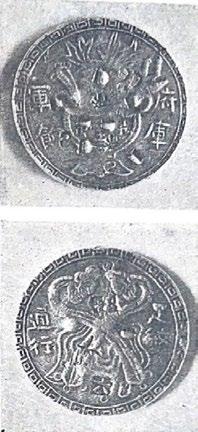
In the center of the obverse we find a legendary treasure fountain, on the body of which the inscription 聚寶盆 appears, meaning“ never ending source.” To the right the character 軍 and to the left 餉 , meaning“military rations”. Below 足 紋通行 , denoting“ pure pattern ”, and standing for“general circulation.”

The reverse shows two crossed brushes, lotus and other symbols and to the right the character 府 and to the left 庫 , meaning“Treasury”. Below characters 六八足重 state the weight, namely 6.8 mace heavy.
Some years ago, when the coin (figure3) was shown to me, I failed to place it. In fact, neither the owner, nor myself had ever heard of it. I therefore raised the problem in the columns of “Finance & Commerce”and some months thereafter received an extensive reply from France.
Fig. 2
The translation of the inscriptions reads as follows: Obverse: Changchow district, for general circulation; Reverse: Military rations, pure pattern.
Another dollar coin, now very rare, is the cause of much controversy. Undubitably it also thanks its origin to warfare. Here we have two distinct designs. Figure 3 is a ration coin for payment of the solidiery. It weighs 6.8 mace and was produced by Ling Kung during his uprising in the Fung-shan district, Formosa, in the third year of Hsien Fong(1853). Although made Fig. 3
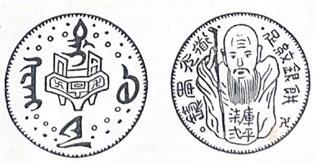
Not withstanding the fact that the said explanatory reply came from China's foremost numismatist, the late Mr. Tracey Woodward, and that it was based on notes left by the wellknown Sinologue and collector, the late Mr. S.W. Bushell, it is not convincing. Then I believed, and my belief has since not been shaken, that these dollar pieces had their origin in Taiwan (Formosa), or else in the neighbouring Fukien Province; and certainly not in Peking. Mr. Woodward's letter, published in No.3 of the China Journal (September 1936) is cited here verbatim:
"Replying to your querry on page 343 of the June (Vol.XXIV, No.6) 1936 issue of the China Journal, the coin mentioned by Mr.E.Kann was not issued during the Taiping Rebellion. From a manuscript note made by the late S.W.Bushell which fell into my possession when I bought his collection in 1921, he mentions that this piece is a Treasury dollar minted in Peking about 1868. As the Taiping rebellion ended in 1865, the piece was evidently produced for other purposes. The characters, however, reveal that the coin was placed into circulation by means of payment to the imperial troops, as has been the case with many other coins in China. The obverse represents a vase containing branches with leaves, and the characters 府庫 (Fu Ku), i.e. "Treasury", and 軍餉 (Chun Hsiang), meaning "Military Rations". On the vase itself appears the character 寶 (Chu), which means "a tablet", generally an ancestral tablet. The reverse represents two lotus flowers with their stems crossed; at the dexter are the characters 足紋 (Tsu Wen). They translate "pure pattern". At the sinister we find 通行(Tung hang), which means "for general circulation". In colloquial English, the obverse may be put down as:"Military payment of the Treasury". The reverse as "Current pure value."
The coin is not cast, but undoubtedly minted, either at a foundry or an arsenal, as has been the case with numerous Chinese coins, to wit: Kirin taels, Formosan and Fukien dollars, and so on. A remarkable fact is that all my pieces, like the one of Mr. E. Kann, have the character 六 (six) in an incused square, chopped on the reverse between the two stems of the lotus flowers. The coin is a great rarity now."
(signed) A.M. Tracey Woodward.
Fig. 4
These two interesting coins are nowadays met with only very rarely. In all cases they are "chopped" and worn, so that one will hardly ever see a fine specimen.
As their precursors the two distinct patterns of dollars were military ration coins. These pieces show no symbols, but only Chinese characters. The first dollar coin was produced by general Tseng Kuo-tsuen after the suppression of the Taiping rebellion at Changchow, Fukien province, in 1864/65, i.e. during the third year of the reign of Tung Chih.
The inscription (see fig.5) in translation reads as follows Obverse: Upper line "pure silver", below in two characters "Generally current". The reverse displays a horizontal legend in four Chinese characters, denoting "Changchow Commissariat", and below this iu quick handwriting "Value seventy-four", meaning 7.4 mace weight.

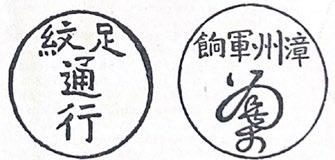

The second dollar coin belonging to the same series in very similar in design. It was struck during the fourth year of Tung
Fig. 5
Fig. 6
Chih (1865) by governor general Tsu Chung-tong at the time of the recapture of Changchow, Fukien province. As will be seen from figure 6 the legend is identical; only the size of the lettering is somewhat different. Also the inscription in quick handwriting of the weight differs considerably.
Though forgeries of these two coins are common, originals are difficult to obtain, especially in good shape. The few existing specimens are badly "chopped" and worn.
It was in 1888, the 14th year of emperor Kwang Hsu, that Kweichow province turned out by simple machinery a dollar coin with its subdivision of 50 cents. In conformity with existing custom these coins bore exclusively Chinese characters apart from symbols. They were designated as 7.2 mace, respectively as 3.6 mace, without reference to the word "dollar", or its Chinese equivalent "yuan".

Their design will be noted from the reproductions given below (by courtesy of Mr. C.C. Tsiang), figures 7 and 8. It remains to merely translate inscriptions: Obverse: Kweichow, officially minted, 14th year of Kwang Hsu; Reverse: Kweichow. These coins are extremely rare and their circulation must have been very limited.



This concludes the enumeration of China's attempts to produce
dollar-like coins before the installation of modern machinery and the adoption of up-to-date minting methods. All the dollar pieces described here, with the possible exception of the last mentioned Kweichow group, were made expressly for the purpose of producing convenient means of paying the troops.
Remarks:TheKweichowdollarprobablycameoutasessay only.Somecollectorsdoubtitsauthenticity.
The coins reproduced here are smaller than the originals, duetolackofspaceinthesecloumns.
(The article is one of six articles from the Bulletin of the Numismatic Society of China bounded by Howard Bowker.)
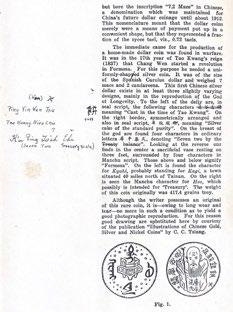

幣,大小與西班牙銀元相同,重七錢二分。這是中國的第 一款銀幣,至少有三種略有不同的壽星形象設計。神像左 邊是篆書“道光年鑄”,意思是道光年間鑄造的。右邊邊緣, 對稱地排列着“足紋銀餅”字樣,意思是“標準純度的銀 餅”,也是用篆書寫的。在神(壽星)的胸前有四個字“庫 平柒弍”,表示七錢二分。背面中間是一只三足寶鼎,周圍 有四個滿文。上面和下面為滿文“臺灣”。左邊發音 Kyahi , 可能代表位於臺南以北 40 英里的嘉義鎮。右邊滿族的發音 為 Hoo,可能是指“庫”。這枚錢幣初重為 417.4 格令(約 27 克)。
雖然作者擁有這枚稀有錢幣的實物,但由於長期的磨損, 它的狀況已經無法拍攝出良好的照片以再現其原貌。由於 這個原因,這裏用蔣仲川出版的《中國金銀鎳幣圖說》中的 精美圖片來代替(圖1)。
這些錢幣的做工非常粗糙。1842 年生產的錢幣在重量上已 經略輕,而1845 年生產的錢幣則更是輕了5% 。

在圖4中可以看到另一個明顯不同種類的臺灣軍餉銀餅,同 樣重六錢八分,由戴潮春在同治元年(1862 年)時發行。
在正面的中央是一個傳說中的聚寶盆,上面有銘文“寶”, 意指“永無止境的財富”。右邊是“軍”字,左邊是“餉”字, 即軍餉。下方題刻“足紋通行”四字。 背面是兩支交叉的畫筆、蓮花和其他圖案,右邊是“府”字, 左邊是“庫”字,意為“財政”。下面的字是重六錢八分的 意思。
幾年前,當這枚錢幣(圖3)展現在我面前時,我並沒把其 放在心上。事實上,由於無論是這枚幣的擁有者,還是我 自己都沒有聽說過這種錢幣。因此,我在《金融與商業》 專欄中提出了這個問題,幾個月後收到了來自法國的答復。 儘管其對這一問題進行解釋的答復來自中國最重要的錢 幣學家⸺�已故的伍德華先生(Tracey Woodward),而 且它是基於著名的收藏家⸺�已故的蔔士禮先生(S.W. Bushell)留下的筆記,但他的解釋並不令我信服。當時, 我堅信這些銀元來自臺灣,或者是在鄰近的福建省,而非 北京,我的這一觀點至今仍沒有動搖。伍德華先生的信發 表在《中國雜誌》第3 期(1936 年9月)上,全文如下:

耿愛德先生在1936年 6月( 第二十四卷第六期 ) 第343頁上指 出, 他提到的那枚錢幣並不是在太平天國時期發行的。 我曾在 1921年購買下已故的蔔士禮先生的收藏 , 他所作的手稿說明 中提到, 這枚幣是1868年左右在北京鑄造的。 鑒於太平天國 的叛亂在1865年結束 , 這枚錢幣顯然是為其他目的而製作的。 然而, 這枚銀元上的文字顯示, 它正如中國其他許多錢幣的情 況一樣 , 是作為軍餉而投入流通的。 正面是一個裝有樹枝的花 瓶


第二枚錢幣屬於同一系列,在設計上非常相似。它是在同 治四年(1865 年)收復福建漳州時,由總督左宗棠鑄造的。



從圖 6中可以看出,其設計是相同的,只是文字的大小有些 不同。此外,草書銘文(有識為套寫的“朱成功”個性簽 名。⸺�編者)差異很大。
最後一種老銀元
最後一種是在1888 年,即光緒十四年,貴州省用簡單的機 器製造出的一種銀幣,其面值為伍角。按照當時的習慣, 這些錢幣上除了圖案外,只有漢字。它們分別指七二足重和 三六足重,沒有提到“元”或者“圓”。
我們可以從圖7 和圖 8 的拓圖中看到它們的設計。在此翻譯 一下上面的銘文。正面:光緒十四年貴州官爐造。反面:黔 寶。這些錢幣非常罕見,其流通量肯定非常有限。 以上總結了中國在用現代機器和最新鑄造方法之前,對生 產類似銀元的錢幣所做的嘗試。除了最後提到的黔寶外, 這裏描述的所有銀元都是作為支付軍隊費用的便利手段而 製造的。

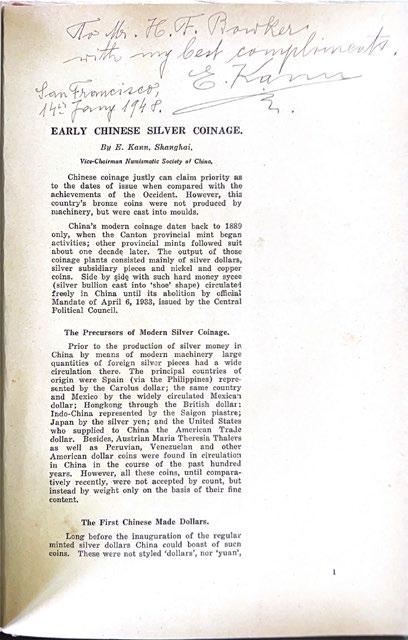


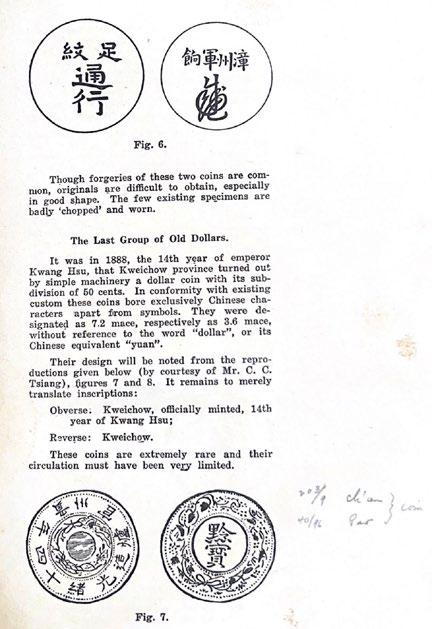
(Originally published in Collectors Club Philatelist in October 1938.)
Copyright 1938 by H. F. Bowker. All rights reserved. Reproduction or use, without express permission, in any manner is prohibited.
Having seen dubious examples of what are purported to be specimens of the half of the 2-cent scarlet of China, used as a 1-cent stamp in FOOCHOW on the 22d, 23d, and 24th of October 1903 (Scott's number 88), from the foremost collections of Chinese stamps in the exhibition at an annual convention of the largest American philatelic society; having received equally questionable copies on approval from many of the principal American and foreign dealers; and any number from stamp auctions, among which were several fakes with "guarantees"by a former "Official Counterfeit Detector", it has seemed an appropriate time to present a few notes on my studies of this stamp which are based upon a half-dozen years of interest and critical examination of scores of copies.
Practically all authorities and editors of catalogs agree that these bisects were used only on the dates stated above. There is, however, no unanimity of opinion expressed as to the relative scarcity of the various dates, and in my opinion the published statements that the first date is commonest and the last date the scarcest, are based upon a false premise. It has been my observation that fakes dated the 22d are very common, but the same cannot be said of genuine examples. As this issue was of an emergency nature, made without any advance notice to the general public, the number of letters posted on the first day were obviously only those required by the ordinary business of the day. The same might not be true of the other dates, as there had then been allowed sufficient time for interested individuals to post any covers that may have been required for philatelic purposes. It is suggested that practically no "philatelic covers"were posted during the three days of use, as the whole
affair took place prior to any general interest in stamps on entire covers. This point, however, is of purely academic interest as any of the dates, genuinely used, are of sufficient rarity to make them very desirable property.
For a number of years I have been telling collectors of Chinese stamps that these items were worth $50 each, during which time they were being cataloged at about $8. I now see that my predictions have been fulfilled by the sale in London in October 1937 of lot 604 of the Finegan collection for that amount.
Theodore Siddall, in the 2d edition of his Catalogue of Chinese Stamps, states that "nine out of ten in the market are forgeries", but I believe he has understated the case; and I find that he published an illustration in the 3d edition of his catalog of what will be shown herein to be a fake. Several years ago Michael Miller, in his series of articles on "Splits" in the American Philatelist examination as to its authenticity. The illustration in the catalog of the Stephens Stamp Co.of Shanghai is also of a forgery.
The only example of the genuine surcharge and cancellation which is readily accessible to the general collector is in Gibbons Catalog. If there are any others published they have escaped my attention.
It has been claimed that there was no legitimate reason for the use of the bisected stamps, and that the inland rate for letters in 1903 was not 1-cent. This is incorrect, for while I have not been able to determine from official sources the dates between which the 1-cent rate was in effect, I have a number of entire covers of the period showing that rate for inland letters. Figure 1 is an example of a sealed letter carried from Luan Chow (Anhwei) to Lu Chowfu (Szechuan), cities about a thousand miles apart,
in October 1903. It is backstamped 10 OCT 1903, but this date may be an error, as the sender has endorsed on the face of the envelope what appears to be the date of mailing, "10/26/1903", so that it seems more probable that the letter arrived at its destination on 10 November 1903. These inconsistencies are quite common on Chinese covers even today, due no doubt to the incomplete understanding of the abbreviations of the English names for the months of the year by the Chinese postal clerks.
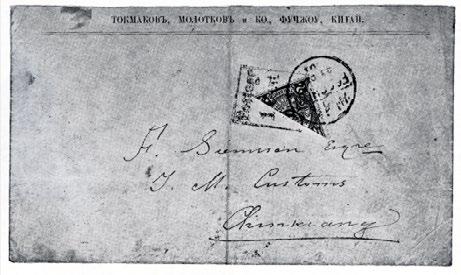


Several genuine examples of these provisionals will first be described. From these the various salient points by which the genuineness of any FOOCHOW split may be judged, will be made understandable.
The finest example of an entire cover dated the 22d of October 1903 which has come to my attention, is in the collection of James Starr of Philadelphia (Figure 2). Addressed to "Capt. J. H. G. Garver, H. B. M's Surveyor, British Consulate, Shanghai,"with the printed return address of "BROCKETT & Co. FOOCHOW"on the flap of the envelop, it is backstamped "Shanghai Local Post H OC 25 03"within the customary doublelined circle of the common local postmark. The envelope is made of white bond paper, 149 mm. By 85 mm., watermarked diagonally "HOWARD & JONES LONDON"in double-lined block letters 7/16 high, manufactured by "Howard & Jones, Manufacturers 16, Cullum St.London", as evidenced by the colorless embossed lettering on the back of the envelope. The impression of both the surcharging chop and cancellation are gray-black. The piece of the stamp used is the lower left half.
The only genuine example of an entire cover used on the 23d of October, other than the Chinese-type cover described later in this article, that I have seen is in my own collection (Figure 3). It is addressed to "F.Siemssen,Esqre. I(mperial) M(aritime) Customs, Chinkiang."Across the top of the front of the gray envelope, measuring 164mm. by 95mm., is the return card of the sender,"TokmakoffMolotkoff & Co. Foochow, China"in Russian, and on the back flap is an impression in purple ink of an oval rubber stamp with the same firm's name in English and Russian and two Chinese characters, probably the Chinese hong name of the company. The cover is backstamped "CHINKIANG 2 NOV 03." The stamp is also placed fortuitously and is the lower left-hand section. The surcharging chop and cancellation are both gray-black.
The best example I have seen of the third and last day's use, 24 October 1903, was purchased in London (Figure 4). It is a common buff wove-paper envelope without any particular identifying characteristics, 150mm. by 87mm., addressed to "A.S. Watson & Co., Limited, Amoy." It is backstamped
Figure 3 Second day cover, 23 OCT 03
Figure 4 Third and last day cover, 24 OCT 03
"AMOY 26 OCT 03."The surcharging chop and cancellation are also gray-black, and the stamp is the upper right-hand section. I have a second example of this date on a white envelope, 94mm. by 67mm., with a colorless embossed impression "Custom House,Foochow" on the flap, addressed to "Sing Mi Sing, Esq. Customs, Santuao."It is backstamped in that city on the 26th of October 1903. The impression of the surcharging chop and cancellation are gray-black, and the stamp is the lower left-hand section. Mr. Starr has an excellent specimen of this day's usage, addressed to "Herren Pasedag& Co. Amoy." The stamp is the upper right-hand section. The envelope is of dark blue paper with a large watermark showing a figure of Britannia seated within an oval 150mm, by 83mm, surmounted by an elaborate crown, and with single diagonal lines 26 mmapart running thru the whole design, and closely laid lines 1 1/2 mm apart at right angles thereto. The envelope's backflap has the firm name of "Siemssen&Krohn, Foochow"printed thereon. The cover is backstamped "AMOY 26 OCT 03." At the left-hand edge of the face of the envelope is the name of the addressee in hsingshu characters. The stamp is also the upper right-hand section.
A study of the signal characteristics of the above-described covers, as well as many others, enables one to determine that in order to be considered genuine a specimen should have most of the following features:
1. Color of the stamp section must be scarlet, not red.
2. Stamp section should be the upper right or lower left-hand section.
3. Cover must be addressed to a point outside of FOOCHOW.
4. Cover should be backstamped conforming to the address, with correct interval between date of posting and date of arrival at destination.
5. FOOCHOW postmark and oblong surcharging chop must be grayish black, not black.
6. Stamp section should be applied at random on the envelope, with postmark adjacent thereto and not necessarily impinging upon the oblong chop or stamp section.

7. Envelope should have some sort of characteristic identifying it with FOOCHOW, such as the printed return card of the sender.
8. Dealers' "guaranteemarks" should be considered of value only insofar as they identify the source of supply, as they are in the case of this particular item of no other significance.
The reasons for stressing these characteristics will now be discussed.
1. The scarlet shade was current at this period, being the shade of the earlier shipments of this stamp. The 2-cent stamps were later issued in darker shades of red, and the many fakes on the market are almost invariably made from these darker shades.
2. It appears that the stamp clerk or clerks who handled the outgoing mail in FOOCHOW on the dates under discussion, cut up the sheets of stamps by cutting diagonally across the face of the sheets from the lower right-hand corner to the upper lefthand corner. This method of separation caused the half-stamps to be in strips with alternately an upper right-hand and a lower left-hand section. Once this method of cutting up a sheet was started it was impossible to reverse the direction without loss
of stamps, and no sections composed of the lower right-hand and upper left-hand parts of the stamps resulted. This inference is drawn from the fact that I have never seen a single genuine example of either of the latter sections, although many fakes made from these sections have been seen. It would seem that the fakes were prepared from used copies of the 2-cent stamps which did not happen to have cancellations on one half of the stamps, so that they are to be found made from any of the four possible bisections, upper right-, upper left-, lower right- or lower left-hand. In the absence of any evidence to the contrary, I am of the belief that all splits with the lower right- and upper left-hand sections are fakes.
3. The local rate was 1/2 cent, consequently there was no point to paying the 1-cent rate for mail addressed to local addresses. Therefore, the many covers addressed to FOOCHOW addresses are fakes. This conclusion is succinctly stated in this manner only as a ready means of eliminating at once the most obvious fakes which are commonest. Further on in this study additional demonstration of this fact will be given.
4. The reasons for this statement are too obvious to need discussion.
5. All genuinely used examples of this split which have been seen had both the surcharging chop and the cancellation impressed with grayish black ink. The fake cancellations and surcharging chops were always stamped heavily with black ink.
6. It has been noted that most of the covers which it has been possible to establish as genuine have the stamp sections applied at random. The only specimens which have been seen which have the stamp sections and surcharging chops placed in an orderly manner are those mentioned above addressed to Herren Pasedag & Co. and Figure 2, from Mr Starr's collection. This combination is so rare that it may be considered accidental.
7. All of the fakes on entire covers which have examined were entirely without any markings identifying them with the city of their purported origin. Most of the genuine covers examined originated with firms in business in FOOCHOW, and as is customary there as elsewhere, they had their envelopes
endorsed with their return cards.
8. As the state of knowledge of this interesting split, as evidenced by the printed record in philatelic publications, is very meager, and because of the rarity of the genuine and the abundance of the fakes, dealers everywhere have apparently taken the easiest way and have guaranteed that which came into their possession. This condition has been so prevalent that in consequence dealers’guarantee marks, with regard to this particular stamp, have been found to be without value, and collectors are accordingly cautioned to disregard such, excepting insofar as they may be of value in securing refunds for fakes sold as the genuine. Of course the presence of guaranty marks should not in themselves be considered a defect if one can otherwise substantiate the genuineness of the specimen, but its presence is no guaranty of genuineness.
Several years ago I was favored with a private view of what was generally believed at that time to be the foremost American collection of Chinese stamps, and was furnished with photostats of the entire section devoted to the FOOCHOW splits. A critical study disclosed that only two specimens, both on entries, were genuine. The balance of about a dozen specimens on entries and pieces of covers were all fakes. The stamp collection in the Smithsonian Institution at Washington, was examined and the only specimen on display was an obvious fake of the commonest sort. The Curator, Mrs. Manning, stated when her attention was called to this, that it would be withdrawn from exhibition.
I have seen only one genuine example of a FOOCHOW split on a Chinese type envelope with the address in Chinese characters. It was from the collection of Mr. Scheible, formerly of Shanghai, and was sold by J.C. Morgenthau & Co. of New York as lot 255 of their 260th sale. It was described in the catalog as follows: "1903 1 c on Half 2 c scarlet (88), used on original which was cancelled Foochow Oct. 23, and receiving stamp Tientsin Nov. 5, 1903, very rare in this shape and not in the same class as August 1904 bisect of Tchongking."This fine piece was an entire envelope of the conventional Chinese-type with a broad red stripe thru its length. It was sold on 29 October 1928 for $9.10. It is one of my greatest regrets that I was not the
Figure 5 Registered cover, half of 2 cents used in Foochow 24 OCT 03, as a 1-cent stamp, without surcharging chop
purchaser, but at that time I had not yet arrived at the opinions I now hold regarding the rarity of such a piece. This is not the cover, lot 597 of the Finegan sale.
Thru the courtesy of James Starr, I am able to illustrate (Figure 5), what is perhaps an unique example of the Foochow split. This cover differs from all others examined in that the split 2-cent stamp is used without the oblong surcharging chop, and taken with the 5-cent stamp makes up the 6-cent registered letter rate. It originated with the same firm, Siemssen & Krohn, as did the cover described above addressed to Herren Pasedag & Co., altho the sender is stated on the face to be C.D. Ling; and was despatched from FOOCHOW on 24 October and backstamped in Amoy on 26 October. The bisected stamp is also the lower left-hand section. It will be noted that the half-stamp overlays parts of the address in two places, indicating that it was applied when it was cancelled in the FOOCHOW post office. I do not have any notes on the shade in which the 2-cent stamp was printed, but if my memory serves me correctly, it is the same scarlet shade described above. Had it differed from the usual shade which I have always noted in the originals, I should certainly have made a note of the fact.
Perhaps the largest group of this item which has come upon the market is that from the collection of E.H. Finegan of Utica, New York, which was sold at auction in London by Harmer, Rooke & Co. on the 15th of October 1937. It consisted of 8 lots, 4 entires
and 4 on pieces of covers. Of the entires, 3 were dated the 22d and 1 the 24th. One on a piece of cover was dated the 22d and 3 the 23d. Recapitulating: 4 dated the 22d, 3 the 23d, and 1 the 24th. These proportions do not necessarily reflect the relative scarcity of the various dates, although it would seem that the cataloger thought so. More probably the only things indicated are the opportunities presented themselves. Unfortunately, I never had the opportunity to view Mr. Finegan's collection prior to its dispersal, altho I did telephone him from Binghamton to make an appointment for that purpose several years ago when I was driving from New York to San Francisco. He was leaving that day on a business trip and no further occasion was ever available. I should have liked to have had the chance to look over the entire collection, and particularly these 8 lots, as the descriptions in the catalog are, as with all British auctions, notoriously inadequate unless one can personally examine the stamps. As a matter of fact, one might infer from the descriptions given of these lots that the stamps had been bisected vertically and not diagonally. As shown above and if my conclusions about the method of bisecting are correct, and if all the lots were genuine, which is not necessarily true, where the descriptions specify "right half" it is inferred that the upper right-hand section is meant, and where "left half"is indicated, lower left-hand section is understood. If any are upper left-hand or lower right-hand sections, I am of the opinion that they are not genuine, altho I am open to reason on this point and would be glad to revise the conclusions expressed above upon the presentation of concrete evidence.
Without expressing any opinion as to whether the prices obtained truly reflect values, as a matter of record, all the catalog data together with the prices realized is reprinted.
1903 October 22-24.
597 1c. on half of 2c.deep red, right half on native cover, postmarked Oct.22, cat.60/ $37.50
598 Another lot, but left half, on small cover dated Oct.22 $42.50

599 Another similar lot $25.00
600 Another lot, but right half used on piece, dated Oct.22 $22.50
601 Another similar lot, used Oct.23 $21.00
602 Another lot, but left half, used Oct.23 $21.00
603 Another similar lot $21.00
604 Another lot, left half, used on entire cover dated Oct.24 (rare date) $50.00
The color nomenclature given may be safely ignored as there is no consensus regarding colors and shades of colors, and while the first lot above may be correctly described as to shade, the inference conveyed that all the lots are the same shade may be incorrect. It is hoped that they are not, as all deep red ones I have seen were not genuine. The average price obtained at this sale was about $30 each; $38.65 for entire covers and $21.35 for pieces of covers.
The appreciated value of these bisects on entire envelopes has been particularly stressed thruout because of the fact that the entires show the added features by which absolute authenticity may be determined, which are not or may not be present in the case of those specimens on small pieces of covers.
With regard to the relative values of entires as compared with specimens on pieces, it is my carefully considered opinion that specimens on pieces are worth not more than 20% of the value of specimens on the entire envelopes, including of course both front and back. Those on the front only, with the back of the envelope removed, are not very much more desirable than specimens on smaller pieces of covers. There is, however, no hard and fast rule applicable to the question of relative philatelic values, which are largely governed by the personal ideas of both the seller and the buyer. Values may be based upon the condition of a particular specimen or on the imponderable ideas
of one of the parties. A stamp always looks much better and has a higher value to the average seller than to the buyer, and a sale is usually a matter of a compromise between the ideas of the two parties. If there is any possibility of a specimen being a scarce or rare variety, the seller almost invariably claims that his specimen is the rare one, and great is his indignation if the prospective buyer has greater philatelic knowledge or discrimination and is able to refute or disprove his claim. A case in point is that of the 5-candarin bistre 1885 issue of China. Most every off-color or faded copy in dealers' stocks are claimed to be the scarce bistre printing which catalogs several times the catalog value of the commoner printings. Every China specialist knows that if the stamp offered does not have the rough perforations measuring 12 1/2 it cannot possibly be the bistre shade, although having perforations of that type and gauge does not always mean that it is the bistre shade; but that simple fact seems to have escaped the attention of most dealers, or if known to them is kept carefully concealed.
Returning again to the consideration of relative values, the following schedule reflects the writer's estimates:
100% $50.00 For specimens on entire covers having all points (a) to (g), inclusive.
90% $45.00 For specimens having points (a) to (f), inclusive.
50% $25.00 For specimens lacking the back of envelope, with points (a) to (c), and (e) to (g), inclusive.
25% $12.50 Piece of envelope including surcharging chop and cancellation and part of address.
20% $10.00 On small piece of cover.
The question now arises, how can the authenticity of specimens be determined which are not on entire envelopes, but consist only of pieces of covers? This is a very simple matter. If the
Figure 6 Cancellation in use in Foochow on 22d, 23d, and 24th Oct 1903
Figure 7 Cancellation in use in FOOCHOW from July 1912 to May 1918
cancellation conforms to type II (Figure 7), the specimen is a fake. There are many other crude forgeries in which the cancellations are neither of these post office types, but are merely crude imitations which will scarcely deceive anyone.
It is my opinion that all the type II fake covers were manufactured between the years 1912 and 1918 by someone employed in the FOOCHOW post office who had access to the original oblong wooden surcharging chop which was used in 1903 by that post office. As the 1903, type I cancelling stamp had been worn out, the cancelling stamp then in current use, type II, was used. A person or persons in the office of the Eastern Exchange Telegraph Company probably acted in collusion with him, as many of these fakes are addressed to the office of that company.
Over a period of more than ten years I have collected all Chinese stamps that I could obtain having legible FOOCHOW cancellations thereon, believing that therein lay the clue to the source of these fakes. These cancellations separate themselves into the following groups:
Single lined circle, FOOCHOW across center, Chinese characters for Foochow above the horizontal line, dated below in English. Dates collected, 14 November 1900 to 1 March 1910. ALL GENUINE FOOCHOW SPLITS HAVE THIS TYPE CANCELLATIONS.
Single lined circle, FOOCHOW across center, Chinese characters for FOOCHOW above the horizontal line, dates below in English. Dates collected, 11 July 1912 to 14 May
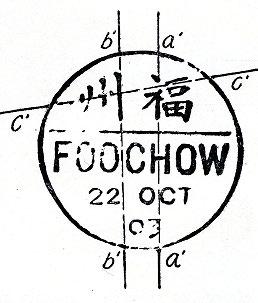
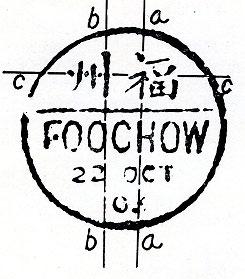
1918. MOST FAKED SPLITS OF THE DANGEROUS VARIETY DESCRIBED ABOVE HAVE THIS TYPE CANCELLATIONS.
A record was kept of typical addresses found on faked entire covers, type II.
Addressee Address Date
Mr. Chui Foochow Oct. 22, 03
The Eastern Ex Telegraph Co. W. Lee Esq. E.E. Telegraph Co. Warren Esq. E.E. Telegraph Co. Mrs. Warren Esq. (sic) Mr. Wong Mr. D.B. Wong E.E.T. Co. Mr. W.B. Wong C.T. Sia Esq. C.T. Sia
Oct. 24, 03
It is believed that these are the names of actual persons and perhaps among them is that of the perpetrator of this fraud. A critical examination of the handwriting of these addresses
indicates that they were all written by one person. Altho it is apparent that an attempt was made to disguise the handwriting by executing some of them backhand, there are enough peculiarities in the manner of the forming of certain letters for one to categorically declare that one person wrote them all. These are most noticeable in the forming of the capital letters "W"and "E", and in the "oo", and the "ch"in Foochow. Most of the faked entires examined were addressed by this person.
One exception, of which I have a photostat, is not addressed in English but in Chinese, on a narrow typical native envelope without the customary red middle stripe. However, in this example both the oblong chop and the cancellation differ from the commoner type II fakes described above, notably in the date which is the 23d, the incorrectly formed figures of the date, and the horizontal dividing line of the postmark joining the circular outer line at both ends.




There are other forgeries in which both the oblong surcharging chop and the cancellations are crude imitations of the originals. These are, however, too crude to deceive anyone other than the veriest tyro, and will be dismissed with a few notes on their most noticeable features.

One odd forgery which came to my attention dated 22 Oct 03 was of the correct shade but was made from a cancelled stamp peeled from an envelope with the red bar thereon, which left red on the back of the stamp, that could plainly be seen thru the thin paper upon which it was later mounted for making the
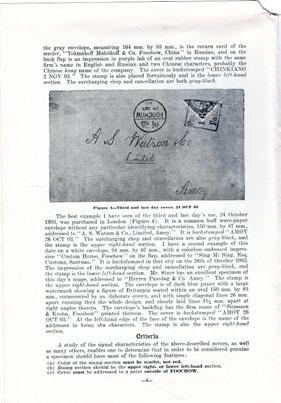
fake. The figures "2"were very poorly formed.
Another common forgery which has spurious cancellation and oblong surcharging chop, is usually found on stamp sections from which the cancellations have first been washed. In this type the horizontal line of the cancellation is joined to the circle at both ends, and the corners of the oblong chop are rounded.
In conclusion, my thanks are due to the many collectors and dealers who have so obligingly permitted me to examine their collections and stocks. I am particularly indebted to James Starr and the late H.F. Colman of Washington, D.C. I appreciate that many readers may not fully concur with my conclusions regarding what I have called the type II fakes or forgeries, but I believe that after mature consideration they will agree that these "album weeds"are worthless and should be eliminated from collections and the philatelic trade. I believe that I have bought as many of the various types of fakes and forgeries of China number 88 as anyone, and if I am willing to call my fakes by their proper designation, I think they should likewise.
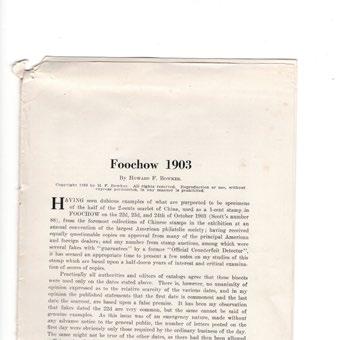

If I have failed to make clear any points relative to these most interesting philatelic rarities or their imitations, I should be only too pleased to correspond further with interested collectors. My address until May 1939 will be Box 184, Agana, Guam. Use the transpacific air mail to insure a prompt reply, as ordinary mail service to this island is very irregular.

值 50 美元。在此期間,目錄裏福州對剖郵票的價格約為 8 美元。現在,我看到1937年10月倫敦菲那根收藏(Finegan collection)拍賣中的 604號拍品實現了我的預言,達到了 這個價格。
西奧多 西德爾(Theodore Siddall)在他的《中國早期郵 票圖錄》(Catalogue of Chinese Stamps)第二版中說, 市場上十有八九是贗品,但我認為他低估了這種情況。我 發現他第三版目錄中的一張圖片上面展示的是贗品。幾年 前,邁克爾 · 米勒( Michael Miller)在他關於《美國集郵家》 ( American Philatelist)中的《對剖郵票》系列文章中對 其真偽進行了檢驗。上海斯蒂芬斯郵票公司目錄中該種郵 票的圖片所顯示的也是贗品。
一般收藏者唯一比較容易能夠看到的真品福州對剖改值郵 票和蓋銷票是在《吉本斯郵票目錄》(Gibbons Catalog )中。 也許還有其他出版作品中有該種郵票的真票,但是它們都 沒有引起我的注意。 有人聲稱當時並無使用對剖郵票的正當理由,而且
1903 年10月22日信封是其中品相最好的一件,出 自費城的詹姆斯 · 斯塔(James Starr)的收藏(圖2)。該信 封是寄給“上海英國領事館 H.B.M. 調查員 J.H.G.Garver 上尉”。信封上印有回郵地址“布魯克特 & 福州”,並在常 見的本地雙圈郵戳內加蓋“上海本地郵政 H OC 25 03”。 信封由證券紙張製成,長149 毫米,寬85毫米,斜向雙行 大寫字體浮水印“霍華德 & 瓊斯倫敦”(HOWARD & JONES LONDON),浮水印高11.25mm 。信封背面的 鋼印字體可以證明,該信封由“倫敦庫倫街16號霍華德 & 瓊斯製造商”製造。信封銷戳都是灰黑色油墨。所貼對剖 郵票的左下半部分。




司的英文和俄文名稱以及兩個漢字,尺寸為164 毫米×
毫米,在信封背面有一個紫色橢圓形戳,可能是該公司的 中文名稱。信封背面加蓋“1903 年11月2日鎮江”。湊巧的是, 這個信封使用的郵票也是對剖郵票的左下方部分,信封銷 戳都是灰黑色油墨。
我看到的郵票發行第三天,也是最後一天貼有福州對剖郵 票的信封中,品相最好的一個是1903 年10月24日寄出的, 購於倫敦(圖4)。這是一個普通的米色橫紋紙信封,沒有 任何特別的識別特徵,規格150 毫米×87 毫米,收件人是 “廈門沃特森集團”。它的背面銷戳“廈門 1903 年10月26 日”。郵戳和蓋銷戳都是灰黑色的,上面所貼的是郵票右 上角部分。我要介紹的第二張是發行第三天寄出的白色信 封,規格 94 毫米×67 毫米,封皮上有一個郵戳,上面寫着 “福州海關”,收信人是“ Sing Mi Sing”。它的背面加蓋福 州1903 年10月26日戳。郵戳和蓋銷戳都是灰黑色的,上面 所貼的是郵票左下角部分。斯塔先生有一件該日的實寄封, 是寄給“赫倫 帕塞達公司”的,所貼為郵票是右上部分。 信封為深藍色紙張,上面有一個巨大的150 毫米×83 毫米 的橢圓形浮水印,浮水印是頭戴精緻的皇冠的不列顛女神
8. 郵票商的“保證 標記”應該是有 價值的,因為在 沒有其他信息的 情況下,這個可以 確定信封的來源。 任何一種。在沒有任何反例的情況下,我認為所有右下角 和左上角部分的對剖郵票都是假的。
可以認為是偶然的。
7. 我檢查過的所有贗品信封上沒有任何可以辨別其寄出城 市的標記。我看過的大部分真品信封均來自於福州的商行。 按照香港和其他地方的慣例,這些商行的信封背面均附有 回郵信封。
8. 從集郵出版物上顯示的郵票印刷記錄來看,人們對這種 有趣的福州對剖郵票瞭解甚少。而且由於真品非常稀少, 有很多的贗品存在,各地的郵票商都顯然採取了最簡單的 方法,那就是對他們手中的東西進行擔保。這種情況非常 普遍。結果發現,郵票商對這種對剖郵票的擔保標記並沒 有價值的。因此,收藏者被警告不要理會這種擔保標記, 除非它們可能有價值,如以真品價格出售的贗品可以獲得退
款。當然,如果人們能夠以其他方式證實郵票是真品,那 麼即便擔保標記不能證實郵票的真偽,擔保標記本身也不 應視為郵票的一種缺陷。
我在幾年前有幸私下看到了當時被普遍認為是美國最重要 的中國郵票收藏品,並得到了整個專門介紹福州對剖郵票 的影印本。一項重要的研究顯示,裏面只有兩枚郵票是真
的,都是粘貼在信封上。餘下的大約十幾個完整信封以及 信封剪片上面所貼對剖郵票都是假的。我查看了華盛頓史
密森尼學會的郵票收藏,唯一一枚展出的郵票是最常見的 那種明顯贗品。館長曼寧夫人( Manning )在被告知此事 時表示,她將把這枚郵票從展覽中撤下。 我只見過一個帶真品福州對剖郵票的中式信封,上面附有
戳,而是與5分郵票粘貼在一起,變成了6分掛號封的郵費。 (圖5)它與上面寄給 Herren Pasedag& Co. 的信封一樣, 都是由西姆森 & 克羅恩公司發出的,但封面上的寄件人是
C.D.Ling 。它於10月24日從福州發出,並於10月26日在廈 門蓋上背戳。上面粘貼的郵票也是左下邊的半張。人們會 注意到,對剖郵票覆蓋了部分地址,表明它是在福州郵局 蓋銷。我對這枚 2分郵票的色調沒有任何說明,但如果我 的記憶沒有錯的話,它就是上述提到的緋紅色。如果它與 我在原文中所注意到的常見的顏色不同,我一定會把這個 事實記錄下來。

我一直強調粘貼在整件信封上的對剖郵票的欣賞價值,因 為這些信封展現了這些可以絕對確認其真實性的郵票所具 有的額外特徵,而這些特徵在信封剪片上可能並不存在。
LOT 597 1枚兩分深紅色郵票對剖改作壹分郵 票, 右半部分貼於本地信封上 , 郵戳為10月22 日, cat.60/
成交價 37.50美元 LOT 598 同上 , 但為左半部分, 信封日期10月22 日 成交價 42.50美元
LOT 599 類似上件拍品 成交價 25.00美元 LOT 600 同上 , 但右半部分貼於信封剪片上 , 日 期為10月22日
成交價 22.50美元
LOT 601 類似上件拍品, 10月23日使用 成交價 21.00美元
LOT 602 同上 , 但為左半部分, 10月23日使用 成交價 21.00美元
LOT 603 同上 成交價 21.00美元
LOT 604 同上 , 左半部分, 用在10月24日的完 整信封上( 罕見日期) 成交價 50.00美元
就完整信封與信封剪片的相對價值而言,我經過仔細考慮 後認為,剪片上面郵票的價值不超過正反面皆完整的信封 上郵票價值的 20% 。那些只有正面,背面被剪掉的信封, 並不比剪片更受歡迎。然而,郵票相對價值的問題並無成 規,很大程度上取決於賣家和買家的個人想法。其價值可 能基於某個特定郵票的狀況,或基於其中一方難以估量的 想法。一般而言,一枚郵票對賣家來說,總是比對買家來 說要好看得多,價值也高得多,而交易通常是雙方想法妥協 的結果。如果賣家的郵票有任何是稀缺或罕見品種的可能 性,都會幾乎無一例外地聲稱他的郵票是罕見的,如果潛 在的買家有更多的集郵知識或辨別力,能夠反駁或推翻他 的說法,他就會非常憤怒。一個典型的例子是中國1885 年 發行的橄黃色 5分銀小龍郵票。在郵商的存貨中,大多數非 彩色或褪色的郵票都被之稱為是稀有的橄黃色郵票,其目 錄價值是普通郵票的數倍。每個中國專家都知道,如果郵 票沒有12.5度的毛齒齒孔,就不可能是橄黃色郵票,儘管 有這種類型和規格的齒孔也並不總是意味着它就是橄黃色 郵票。但這個簡單的特點似乎沒有引起大多數郵商的注意, 或者即使他們知道,也小心翼翼地隱瞞這點。
再次回到對相對價值的問題上,下表反映了作者對價值的 估計。
100% 50.00 美元 貼於整張信封且具有 (1) 至 (7) 所有要點的 郵票 。 90% 45.00 美元 具有 (1) 至 (6) 所有要點的郵票 。 50% 25.00 美元 貼於沒有背面的信封郵票, 包括 (1) 至 (3) 和 (5) 至 (7) 的要點 。 25% 12.50 美元 貼於剪片且有改值戳 、 蓋銷戳以及部分地 址 。 20% 10.00 美元 貼於信封剪片的郵票 。
真品與贗品
現在的問題是,如何確定那些不在整個信封上,且貼於信 封剪片上的郵票的真實性?這是一個非常簡單的問題。如果 上面的蓋銷戳不是第一種類型(圖 6)爾是第二種類型(圖 7),則該郵票為贗品。還有許多其他粗製濫造的贗品,其 中的蓋銷戳不是郵局的蓋銷戳,而只是粗製濫造的仿製品, 幾乎不會欺騙任何人。 我認為,所有帶有第二種類型郵戳的假封都是在1912 年 至1918 年期間由受雇於福州郵局的某人製造的,他可以獲 得該郵局在1903 年使用的原始長方形木質郵戳印章。由於 1903 年第一種類型郵戳已經不再使用,當時使用的是第二 種類型的蓋銷戳。東方交換電報公司( Eastern Exchange Telegraph Company)辦公室的一個或幾個人可能與他串 通一氣,因為這些贗品中有許多是寄給該公司辦公室的。
在十多年的時間裏,我收集了所有我能得到的、上面有清 晰的福州蓋銷戳的中國郵票,相信這就是這些贗品郵票來 源的線索。這些蓋銷戳的情況分為以下幾組:
單線圓形蓋銷戳,中間為福州,橫線上方為漢字福州,下 方為英文。收藏的時間在1900 年11月14日至1910 年3月1日 之間。所有真正的福州對剖郵票都有這種類型的蓋銷戳。 (見圖 6)
單線圓形,中間為福州,橫線上方是福州的漢字,下面是 英文的日期。收藏的時間在1912 年 7月11日至1918 年5月14 日之間。大多數上述提到的很有可能是贗品的郵票都有這 種類型的蓋銷戳。(見圖7) 贗品
我們對贗品整個信封上發現的典型地址進行了記錄,上面 的蓋銷戳為第二種類型。
收件人 地址 日期 崔先生 電報 福州 1903年10月22日 東方前線電報公司
W. 李 E.E. 電報公司 沃倫 E.E. 電報公司 沃倫太太
王先生 D.B. 王先生 E.E. 電報公司 W.B. 王先生 C.T. 西亞 C.T. 西亞 1903年10月24日
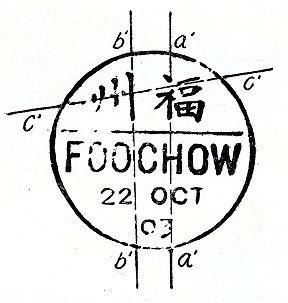
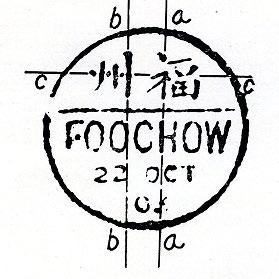
據信,這些都是真實的人名,也許其中就有郵票偽造者的 名字。在嚴格檢查這些地址的筆跡後表明,它們都是由一 個人寫的。儘管,有人明顯試圖通過反手書寫來掩飾筆跡, 但某些字母的形成方式有足夠的特殊性,讓人可以斷然宣 佈這些字母都是一個人寫的。這在大寫字母“ W ”和“ E ”的構成中最為明顯,在福州的拼寫“oo”和“ch ”中也 是如此。我看到過的大多數偽造的信封都是由這個人寫的。 但有一個例外,我有一個信封的影印件,不是用英文寫的, 而是用中文寫的,在一個常見的細長的本地信封上,中間 沒有傳統的紅條。然而,在這個信封上,長方形郵戳和蓋 銷戳都與上述常見的第二類型郵戳不同,特別是上面的日 期是 23日,日期的格式不正確,且郵戳的水平線在兩端連 接圓形外側的線。




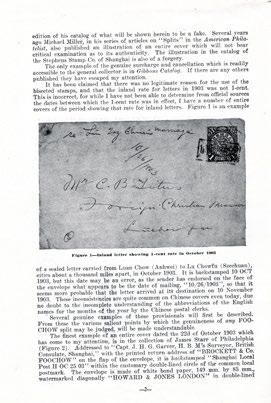



還有一些贗品,其長方形的改值戳和蓋銷戳相比真品而言

上面製作的,上面有紅杠,在郵票的背面留下了紅色,透過 薄薄的紙可以清楚地看到。而且數字“ 2 ”的形狀非常差。
另一種常見的贗品,上面有偽造的蓋銷戳和長方形改值郵 戳,通常出現在首先被洗掉蓋銷戳的郵票部分上。在這種 類型的贗品中,蓋銷戳的水平線與圓的兩端相連,長方形 改值郵戳的角是圓的。
最後,我想對許多收藏家和郵票商表示感謝,他們如此慷 慨地允許我查看他們的收藏和存貨。我尤其要感謝斯塔和 華盛頓特區已故的科爾曼(photostat)。我知道許多讀者可 能不完全同意我關於第二種類型贗品的結論,但我相信經 過深思熟慮後,他們會同意這些東西毫無價值,應該從收 藏和集郵行業中清除。
如果我對這些最有趣的集郵珍品或其仿製品的任何要點有 未作清楚說明之處,非常樂意與感興趣的集郵者進一步溝 通。在1939 年5月之前,我的郵箱地址是關島阿加尼亞的 184號信箱。鑒於該島嶼的普通郵件服務不佳,請使用跨太 平洋航空郵件以確保我可以迅速回復。
I once read the article the Chinese Stamp Collection of Howard Franklin Bowker in the 24th issue of the Journal of East Asian Numismatics, which describes Bowker's research and collecting of Chinese stamps in detail. Recently, I saw some postal envelopes, banknotes, and postal cards sent to and collected by Bowker in Mainland, China during the Republic of China period at the Champion Shanghai Office. Although I do not collect stamps or do research on postal items, I feel that it is quite interesting to explore 14 of these envelopes.
In 1918, China Post began issuing postal cards [postcards with the postage already printed on the card]. Three versions of a postal card featuring grain patterns with postage were issued. The one in the Bowker collection is the third version (Fig. 1) issued in 1921 in a complete set (1 postal card in a set). The postal card is a vertical type with a postage of 3 cents
and there is a vertical line on the lower right side that reads "Price 3.5 cents". Its difference from the previous two versions is that the words "Postcard with Postage" are printed vertically in Song font below the postage image. On the reverse of the envelope, Bowker wrote 3RD PRINTING in English.

An envelope was sent from a foreign bookstore called Western Arts Gallery in Weihaiwei Road (now Weihai Road), Shanghai, to Bowker in Oakland, USA. (Fig. 2) It bears three Sun Yat-sen 2-dollar stamps surcharged to 100 dollars on the reverse. The Western Arts Gallery was opened by a German, a Mr. Heinemann, who had a master's degree and originally ran a bookstore in Berlin, Germany. He fled to Shanghai during the Nazi antiJewish wave and then opened this bookstore at 1166 Xiafei Road (now Huaihai Road) and 904 Weihaiwei Road, and he was considered the most knowledgeable and sophisticated bookseller among his peers.

Figure 3 is an envelope from the Bowker Collection, with the "Central Bank of China Customs Gold Unit Notes" printed in English, and the handwritten year, denomination, color, printing house, obverse, and reverse design of the banknotes on the cover. Inside the envelope are four pieces of the 1939 Central Bank of China 5-cent Banknote featuring the Yong Ning Tower in the center, printed by Xinhua Printing House, 32 Haikou Road.
An envelope was sent by the Fengtien Haicheng Ming Lang Stamp Club to Bowker, who was in Saratoga, U.S.A. at the time (Fig. 4).

The cover bears 15 Manchukuo 1-cent stamps in a block on the obverse and 10 stamps in a block on the reverse. Haicheng City is a part of Anshan City, Liaoning Province, located in the hinterland of Liaodong Peninsula. Since the text on the stamp is not clear, what can be distinguished is“ XX first year, November 20, XX ” , and the pseudo-Manchukuo reign titles "Datong" (from 1932 to 1933) and "Kangde" (from 1934 to 1945). Therefore, this letter was sent either in the first year of Datong, 1932, or in the first year of Kangde, 1934.
An envelope was sent from the Shanghai Chinese Stamp Society to Bowker, New York, USA. (Fig. 5) The cover bears 4-cent Junk Stamps. The Chinese Stamp Society was one of the most famous philatelic groups in early China, founded in July 1925 in Shanghai. It was formerly known as the Maritime Postal Association, playing an important role in early Chinese philatelic activities. Its president was Zhou Jinjue ( 周今覺 ).
Figure 6 is an envelope sent by Mr. Chou from the 4th floor of 53 Fuzhou Road, Shanghai, to Bowker on the USS Seattle, New York. It bears 1 Sun Yatsen one-dollar stamp and 1 Sun Yat-sen three-cent stamp. The address of 53, Fuzhou Road for the Hunt
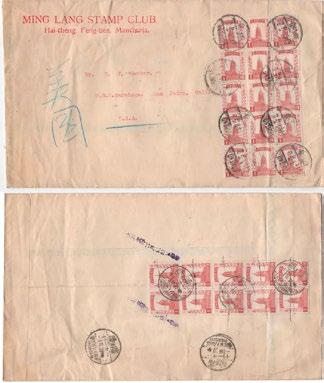
Fig. 2 Fig. 3 Fig. 4

Fig. 5
Fig. 6
which mean 'Yellow Hall'. It bears 1 Sun Yat-sen stamp surcharged 500 dollars and 1 China Post 500-dollar stamp. A P.O. Box is a rented mailbox that needs valid proof of home or office address to rent, and the user needs to present a card issued by the post office with the box number and the name of the delivery office to pick up the mail.
The letter from 582 Changning Road, Shanghai (Fig.8) was sent by Mr. Chen from China to Bowker in Oakland, USA. The envelope bears 10 Sun Yat-sen two-dollar stamps surcharged at 5,000 dollars.
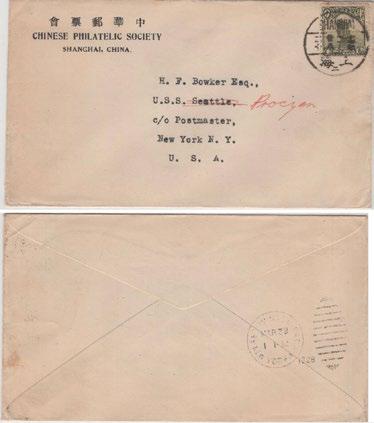


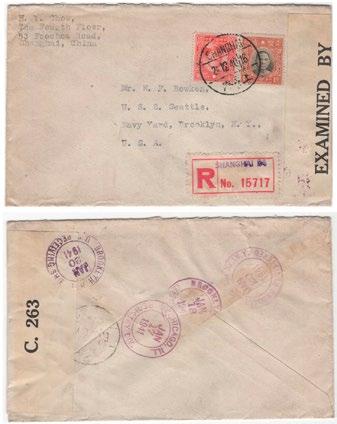
Fig. 7
& Co (William, Hunt & Co; William. Fed, Inc; U.S.A) was built in 1930 by William P. Hunt, the former vice president of Foley's on the Bund, in Shanghai. Its business covers the import and export of hardware, timber, shipping, insurance agency, etc.
Figure 7 is an envelope printed with Yellow Hall P.O. BOX 1773-Shanghai China in English, featuring an ancient Chinese architectural design in the oval circle at the upper left corner and the Chinese characters
Fig. 8
Figure 9 is an envelope sent from the Tianjin Oriental Book Store to Bowker on the USS Seattle, Brooklyn, USA. The sender's address on the envelope is 164 Victoria Road P.O. BOX 74 Tientsin, China, and‘ Tianjin Oriental Library' is written in Chinese. During the Republic of China period, Victoria Road and the northern half of the Great French Road in the British Concession of Tianjin were known as the "Oriental Wall Street", and after the liberation, the two roads were renamed as the "North Liberation Road". The envelope bears 1 Sun Yat-sen 5-cent stamp.
Fig. 10 Fig. 9
University Hospital, Nanking (now known as Gulou Hospital of Nanjing University School of Medicine), built in 1892, was one of the first Western hospitals in China. Figure 10 is the envelope sent by University Hospital to Dr. Edwin Walline on Yuen Ming Yuen Road in Shanghai. It bears 1 Sun Yat-sen 100 Dollar stamp and 1 5-dollar stamp surcharged at 250 dollars.
Figure 11 is an envelope sent from Book Mart, 286 Yuyuan Road, Shanghai, to Bowker, then on the USS Seattle, Brooklyn, bearing 1 Sun Yat-sen 1-cent stamp and 2 Huang Xing 2-cent stamps. Book Mart, owned by a Hungarian Jewish woman, had two stores in Shanghai, and it was the largest old book store in Shanghai. When she left China after the liberation, she gave her store to "Datong", a famous foreign bookstore in Shanghai during the Republic of China. In addition to a large number of books, "Datong" unexpectedly obtained catalogs of valuable books from European used book markets with prices from Book Mart.
Number 147 Ward Road (now Changyang Road) in Shanghai was the Shanghai Public Concessions Police Station, also known as Tilanqiao Prison, in the Republic of China. The prison was first built in
1901 by the Bureau of Public Works of the Shanghai Public Concession and was designed by the British Engineering Office in Singapore. Its construction began at the end of that year and the building was put into use in May 1903. The envelope in Figure 12 was sent by a Mr. Clarke of the Shanghai Public Concessions Police Station, to Bowker on the USS Seattle, Brooklyn. It bears 1 Sun Yat-sen one-dollar stamp.
An envelope sent from North Chengdu Road, Shanghai to Oakland, United States, (Figure 13) bears 1 Sun Yat-sen 50,000-dollar stamp, and 2 2-dollar stamps surcharged at 1,000 dollars. It is interesting to note that there is also one 1948 New Year stamp with no face value. On the stamp is written 'China Fights Tuberculosis', an anti-epidemic stamp issued during the Republican period.

The last envelope in Figure 14 is written from 904, Weihaiwei Road, Shanghai to Bowker, Oakland, California, USA. (1716 Gouldin Road Oakland Calif U.S.A.) and bears 2 Huang Xing 2-cent stamps surcharged at 8 dollars and 10 dollars respectively.
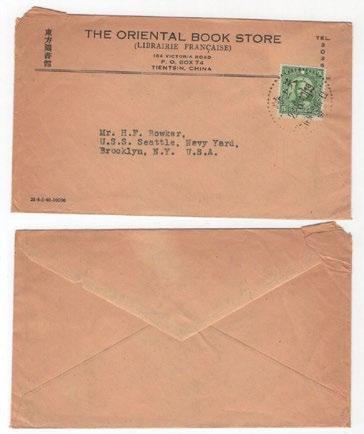
Fig. 12 Fig. 11
Fig. 14 Fig. 13
Through these postal envelopes, we can learn about Mr. Bowker's hobbies and interests. It also shows how widely and deeply he integrated into Chinese society
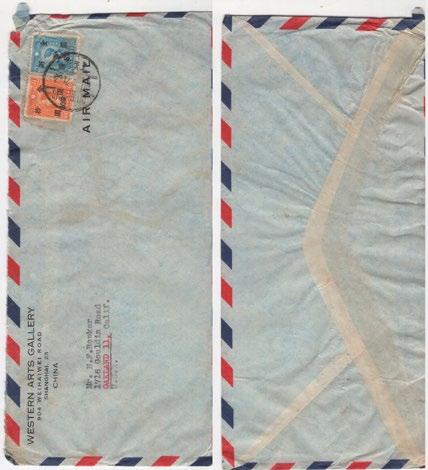


and made friends. Looking at these dated envelopes, it brings back pictures of those days and the passage of time.
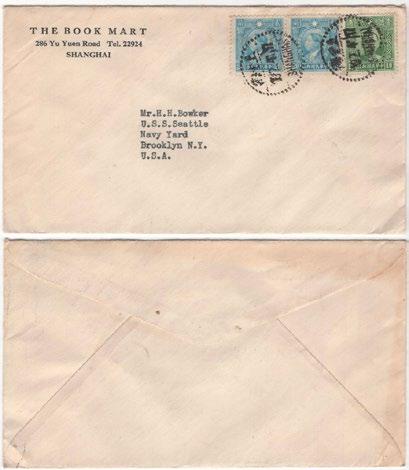




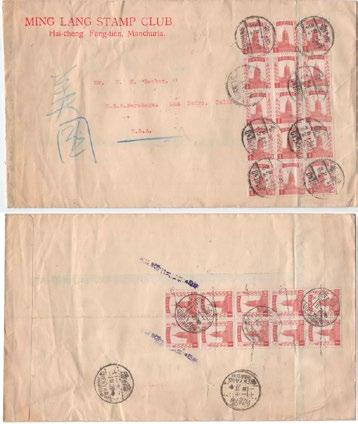

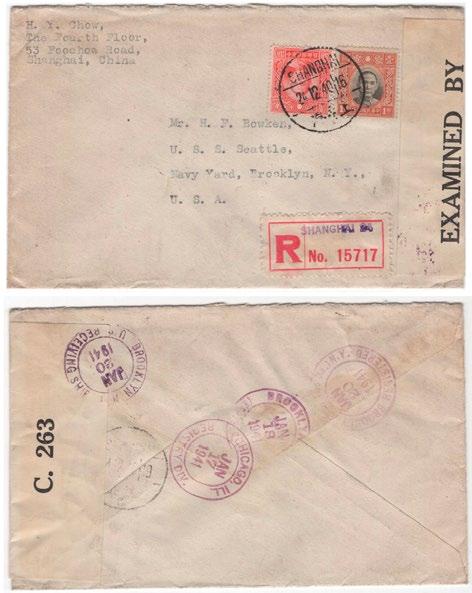



店面,規模是上海舊書店中最大的。她在中華人民共和國
成立後離開中國時,把店面盤給了“大同”書店,大同書店 是上海民國時聲名遠播的外文舊書店,大同書店此次除得 到大批圖書外,還意外地得到歐洲舊書市場名貴書籍的目 錄,並附有價格。

民國時,上海華德路147號 (Ward Road, 今長陽路 ) 是上海 公共租界巡捕房,即提籃橋監獄。這座監獄最早由上海公 共租界工部局始建於1901年,由英國駐新加坡工程處設計 中標,當年年底動工興建,啟用於1903 年5月。圖12信封是 上海公共租界巡捕房 Clarke 寄給在美國布魯克林西雅圖艦 上服役的包克的。貼有中華民國郵政孫中山像壹圓郵票1枚。

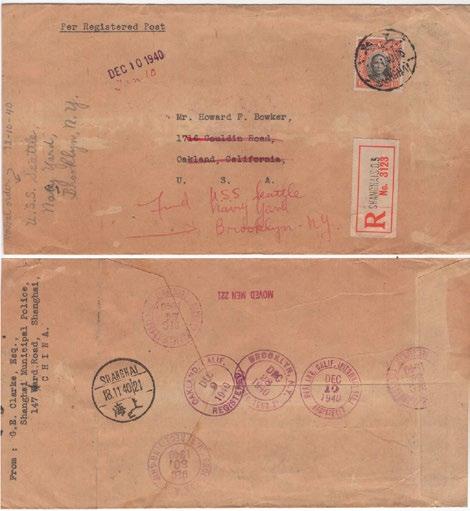

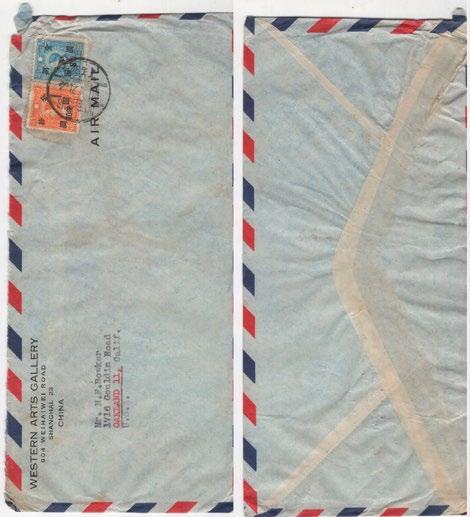
While price guides and other numismatic tools are useful to collectors, no resource can compare to the personal advice of professional numismatists.
Several years ago, while attending the Baltimore Whitman convention, I had the pleasure of spending some time talking to numismatic legend Harvey Stack. When Harvey passed away early this year, we all lost an important link to numismatic history. Thankfully, Harvey had produced a long series of articles for Coin Week discussing the history of the Stack's Bowers auction house.
During our chat, Harvey told me some of his stories about dealing with the great collector, Josiah K. Lilly Jr. As some of you may know, Lilly assembled one of the finest collections of United States and world gold coins in history. Today, the collection resides in the Smithsonian and is a pillar of the numismatics holdings of the National Numismatic Collection.
For decades, the rooms of gold coins were on display in the Museum of American History, where they inspired thousands of collectors over the years. Today, only a small portion of the Lilly gold coins are on display. In recent years, the Smithsonian has made tremendous progress on digitizing the entire Lilly Collection so it can be viewed online.
This Templeton Reid 1830 $10 graded NGC VF Details and pedigreed to the Norweb Collection realized $120,000 at a Heritage sale in August 2021. The Lilly Collection also had an example of this rare coin.
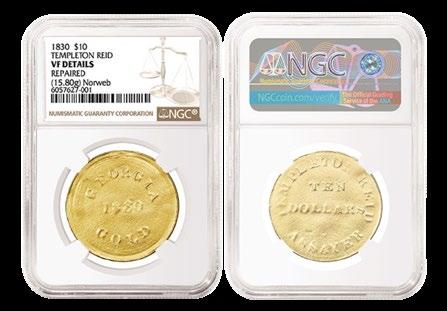
I asked Harvey if Lilly was a serious numismatist, or just a wealthy individual who amassed large numbers of coins with little knowledge of what he was buying. Harvey emphatically stated that Lilly loved rare coins and studied them carefully. Harvey personally worked with Lilly to build one of the finest-ever collections of gold coins. Thanks to guidance and encouragement from the Stack's family, Lilly was able to build this world-class collection.
This 1854-S Quarter Eagle graded NGC VF 25 realized $288,000 at a Heritage Auctions sale in July 2022. The Lilly Collection also had an example of this rare coin.

The value of working with an experienced expert should not be understated; rare coins are a complex subject that can take years to master. There are many pitfalls to avoid and working with someone you trust is extremely important. In today’s Information Age, many do their own research. There is a considerable wealth of information available today in comparison to the past, but nothing can replicate years or decades of experience.
Finding a mentor to guide and encourage you in your numismatic endeavors can be rewarding in several ways. For example, many collectors have worked with the same dealer for decades and consider them among their closest friends. Additionally, having someone on your side will be very helpful when looking for that elusive coin, or when you’re considering an important buying decision. The small fees most dealers charge is usually well worth the investment. Paying too much or purchasing a coin that you could be unsatisfied with can be a costly mistake; it can sometimes take years to recover your loss on an unwise acquisition.
A solid rare coin mentor can also help you develop a sound collecting strategy. Sometimes it can be difficult getting started on a rare coin collection. With guidance, you can decide on the best set or series that fits your taste and budget. Without guidance, some collectors become impatient and want to buy the first coins they see.
With an experienced set of eyes, you will avoid purchasing coins that you could later regret. Many of the top dealers in the country attend every major convention and rare coin auction held in the United States. Naturally, these dealers know where to acquire even the most elusive numismatic rarity.
Working with an expert can be helpful when trying to establish the correct price to pay for a coin that you have been looking for. Price guides are extremely useful, but there are many other issues to consider.
Most dealers will know how popular a series is, and whether the coin is high-end or average for the grade. Rare coin prices can be extremely high these days, and having someone in your corner for a large purchase could be very useful.
Numismatic advice is really important now, given the seemingly crazy prices some coins are selling for at auction. Buyers clearly get carried away when finestknown examples cross the auction block. Some sage advice would be greatly useful when entering these battles. It takes experience to know if a coin was just a lucky submission or if it’s truly sensational.
One might think in today’ s Information Age, with thousands of coins available with only a few clicks of the mouse, that the days of dealers being useful might be numbered. This could not be further from the truth. Several billionaires are now assembling staggering collections of US and world coins. They all have one thing in common: the guidance of numismatic experts.
You do not have to be a millionaire collector to get personal service from a rare coin dealer. Most will help you get started regardless of your budget. Many professional rare coin dealers are very passionate about numismatics, and they enjoy sharing that passion with others.
Even if you already have plenty of friends, having someone to trust and share the excitement of your numismatic pursuits will pay dividends long after you have sold your last coin!

的錯誤;有時可能需要幾年時間才能挽回你在不明智的購 買過程中造成的損失。
一位可靠的珍稀錢幣老師還可以幫助你制定一個合理的收 藏策略。有時,開始收集珍稀錢幣可能會很困難。在老師 的指導下,你可以決定最適合你的品味和預算的錢幣。在 沒有老師指導的情況下,一些收藏者便會沒有耐心,只想 購買他們第一眼看到的錢幣。
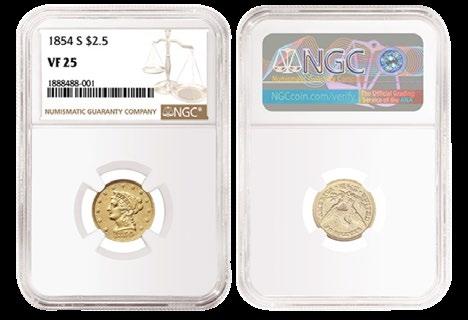
有了一雙有經驗的眼睛,你將避免購買那些後來可能會後悔 購買的錢幣。全國許多頂級幣商都會參加在美國舉行的每 一個大型展會和稀有錢幣拍賣會。自然,這些幣商知道從 哪里可以獲得最難獲得的錢幣珍品。
與專家合作,會對你在為一直尋找的錢幣確定正確的價格 很有幫助。價格指引是非常有用的,但還有許多其他問題
需要考慮。大多數幣商會知道某個系列錢幣的受歡迎程度, 以及該幣在品相上是上乘還是普通。如今稀有錢幣的價格 可能非常高,如果有人支持你進行大規模購買,可能對你 會非常有用。
鑒於一些錢幣在拍賣會上拍出的價格看似很瘋狂,因此, 專家給出錢幣方面的建議現在真的很重要。當最知名的錢 幣被拍賣時,買家顯然會被衝昏頭腦。在進入這些競爭時, 一些睿智的建議將是非常有用的。要知道一枚錢幣是運氣 好被人所喜歡還是真的轟動一時,需要經驗的積累。
Originally published on ngc. com
Learn about the evolution of imperial portraits on Byzantine coins.
Imperial portraits were a defining feature of coins issued in the Roman Empire (27 B.C. to A.D. 476/80). After Italy fell to German soldiers late in the 5th Century, Roman civilization was to survive another thousand years in the East, securely within the walls of Constantinople. Today we know that successor empire as the Byzantine Empire,
even though its inhabitants only knew themselves as Romans.
Not surprisingly, Byzantine coins retained the primary features of Roman coinage, including the imperial portrait. In this column we'll take a visual survey of how the portrait on Byzantine coins evolved over nearly a thousand years, from A.D. 491 to 1453.
The gold coins of the first Byzantine emperor, Anastasius I (419-518), looked almost exactly like those of his Roman predecessors. Above is one example, a gold solidus, with its typically imprecise, military portrait.
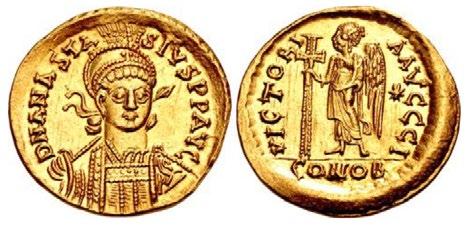
On Anastasius' bronzes, the portraits are even more crudely engraved, taking on an almost comical appearance. Their crudeness is quite appealing, and Byzantine coin collectors revel in the simplicity of these images.
Under Justinian I (527-565) a full-facing portrait was introduced on bronzes. Shown above are two examples from the Constantinople mint: first is a follis struck in

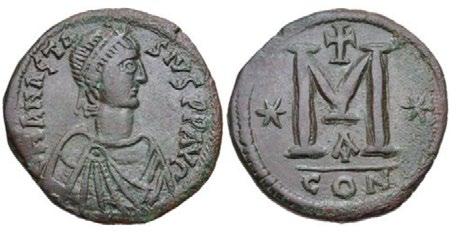
538/9, and beneath that a half-follis struck in 542/3. The follis has a reasonably well-executed portrait, whereas the portrait on the half-follis is almost comical.

The emperor Tiberius II Constantine (578-582) issued gold solidi with some interesting portraits, including the piece above, which shows the emperor from mid-waist. This bust type is known as a 'consular bust' because the emperor wears the garments and holds the objects associated with a consul, the highest office-holder in the senate.
Starting with Phocas (602-610) it became fashionable for emperors to portray themselves with beards. On this solidus, above, Phocas has offers a stern image.
The beard fashion continued, with some emperors choosing to display extremely long beards. A perfect example is the gold solidus above, depicting the emperor Constans II (641-668).



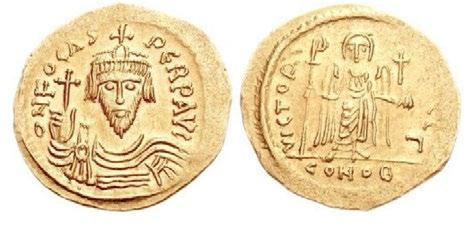

A slightly more refined style emerges during the first reign of Justinian II (685-695). The engraving is a bit more sculptural, even if the portrait itself remains a generic representation of the emperor. Above is an example–a solidus bearing Justinian II's facing portrait.
The improved engraving style continued under other emperors, including Leontius, who revolted against Justinian II and ruled briefly from 695 to 698. Above is
a gold solidus of this emperor, who came into power by rebellion and who was relieved of his authority in the same manner.
Imperial portraits on coinage became even more stylized in the 8th Century, as seen on the solidus above, issued by Constantine V (741-775), who inherited the throne from his father, Leo III. Interestingly, the deceased father is given the place of honor on the obverse of this coin, yet there is little or no effort to distinguish their appearance.
For comparison, we harken back six centuries earlier to the heyday of the Roman Empire, when Hadrian (117-138) issued coins with magnificently styled portraits. Above are a gold solidus of Constantine V and a gold aureus of Hadrian.



Some of the crudest Byzantine coin portraits were issued at the Syracuse mint in the 9th Century. Above is a gold 'globular' solidus of Theophilus (829-842) struck at this important western mint. Just for entertainment value, shown below that coin is a silver tetradrachm struck at
Syracuse by the tyrant Agathocles (317-289 B.C.) more than 1,100 years earlier. These two coins illustrate how, over the passage of time, there was a significant decline in artistic expression at this once-great city.

In many cases the portrait quality had improved by the 10th and 11th Centuries, as seen on this gold histamenon nomisma of Basil II (976-1025). Although they can hardly be described as lifelike, these portraits (including that of Christ on the obverse) at least have some character and some sculptural depth.
By the 12th Century it was more common for emperors to be depicted as standing figures than as portrait busts.
Above is an electrum aspron trachy of Manuel I (11431180) depicting on its obverse Christ enthroned and on its reverse the emperor being crowned by the Virgin Mary.
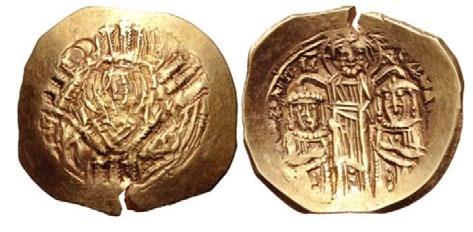
As is so frequently seen on Byzantine coins, the image of the emperor is not individualized.
The figures of emperors assume an even more simplistic form on this gold hyperpyron of the emperors Andronicus II and Andronicus III (1282-1328). The obverse–blurred by a poor strike–shows the Virgin Mary within the walls of Constantinople, and the reverse shows the two standing emperors crowned by Christ.

The final degradation of the Byzantine coin portrait occurred in the 15th Century, when the empire neared extinction. Shown above is a silver stavraton of John VIII (1421/5-1448) bearing on its obverse the portrait of Christ, and on its reverse that of the emperor. In both cases the images are reduced to simple sketches which, by use of a pencil, could just as easily have been created by a kindergartener as by an engraver at the Constantinople mint.
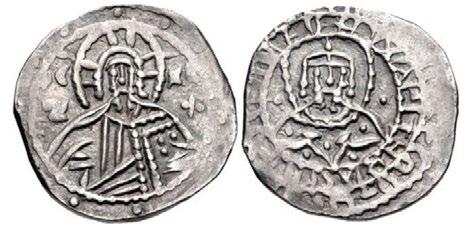












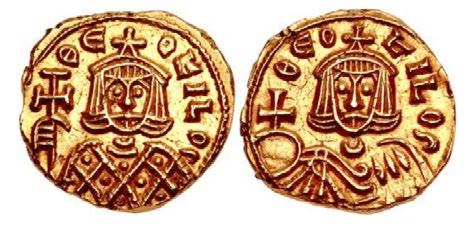





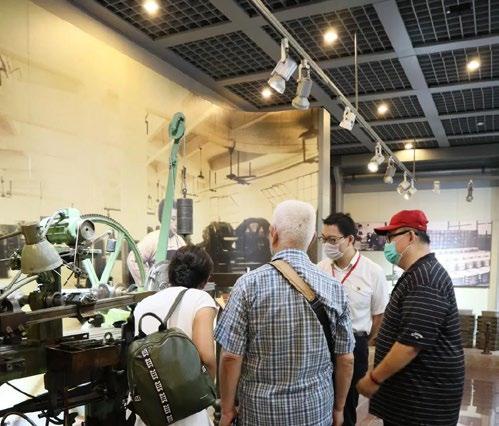

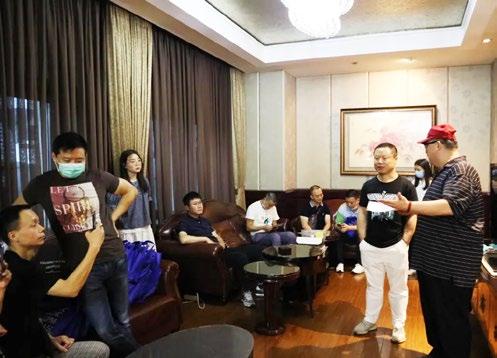





Coins Survey, a landmark event held in the winter 2009 to search for the 10 most valuable Chinese struck coins. Coins submitted for review were judged by their rarity, historical importance, artistic appeal, condition, market value and group identity. The deluxe bound book offered details on the Top Chinese Coins Survey as well as high-quality pictures, price trends, degrees of rarity and historical context of the 60 top Modern Chinese Coins.
Top Chinese Coins, Vol. 1 had a limited print run of 1000, leaving many numismatists and enthusiasts unable to purchase a copy of their own. In response to high demand, iAsure has made certain that the second volume which was released in June 2011 will be available to a much wider audience. While Top Chinese Coins Vol. 1 included gold, silver and copper coins, the second volume highlights the great range of silver coins. Because 2010 is ancient history in numismatics and because so much has happened in the Chinese coin market in the past eleven years, it is high time for a revision. The third edition will be the same as the first edition to include gold, silver and copper coins. In addition, the new edition covers the information of top coin museums, the most expensive coin in the world, etc. This bilingual third edition will have the same beneficial effect on the market that the second edition had.
助益。
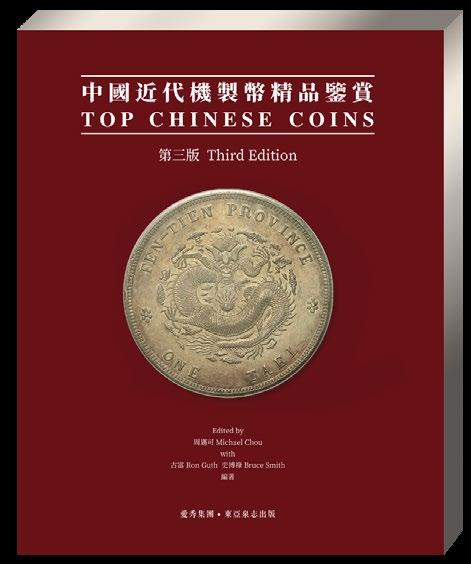
◎ Donald Scarinci, the author of the book Coin of the Year "This is a superb innovative coin with matching artistic design, as one of the most appealing coin of the 2021 dated coins."
◎ This is a rose that can be enjoyed for a lifetime, and each rose is a real rose.

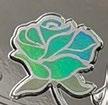

◎ Naturally grown roses are cut in full bloom. This silver coin features a real rose processed through a special preservation process and finished with 24k gold plating on the edge of each petal.

◎ The coin is designed by Mr. Yu Min, the winner of the Lifetime Achievement Award for the Coin of the Year Award and former senior designer of Shanghai Mint Co. The coin is manufactured by Shanghai New Century Commemorative Coin Manufacturing Co., Ltd, one of the world's most technologically advanced mints.


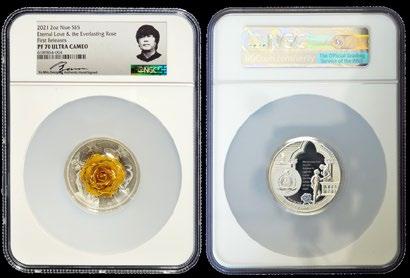
◎ Obverse: It is based on one of the greatest Chinese love stories, Butterfly Lovers. The rose coin features an everlasting rose with the two main characters in the story of Butterfly Lovers in high relief. They look away from each other with a Chinese plum tree separating them, and two butterflies flying together showing the final scene of the story.The plum flower, the plum tree, and the background use a finish silver effect. For the butterflies and the window, blasting and mirror effects are used while the face and clothes of the characters employ a blasting effect.


◎ Reverse : It shows Romeo and Juliet. The two stand on the balcony dressed in classical European dresses, the rose below is overall flat and convex, but a prism allows for different colors to be seen from different angles. Behind are the characteristic Venetian dome windows and faded bricks. The text inside the window is the classic line of Romeo and Juliet. The white brick seam lines on the walls are white blasting, and the walls are blasted with a gradual change of brighter top and whiter bottom. The balcony, windows and brick wall replicate the actual location where the story takes place.


Address: Building, No.1211, Changde Road, Putuo District, Shanghai












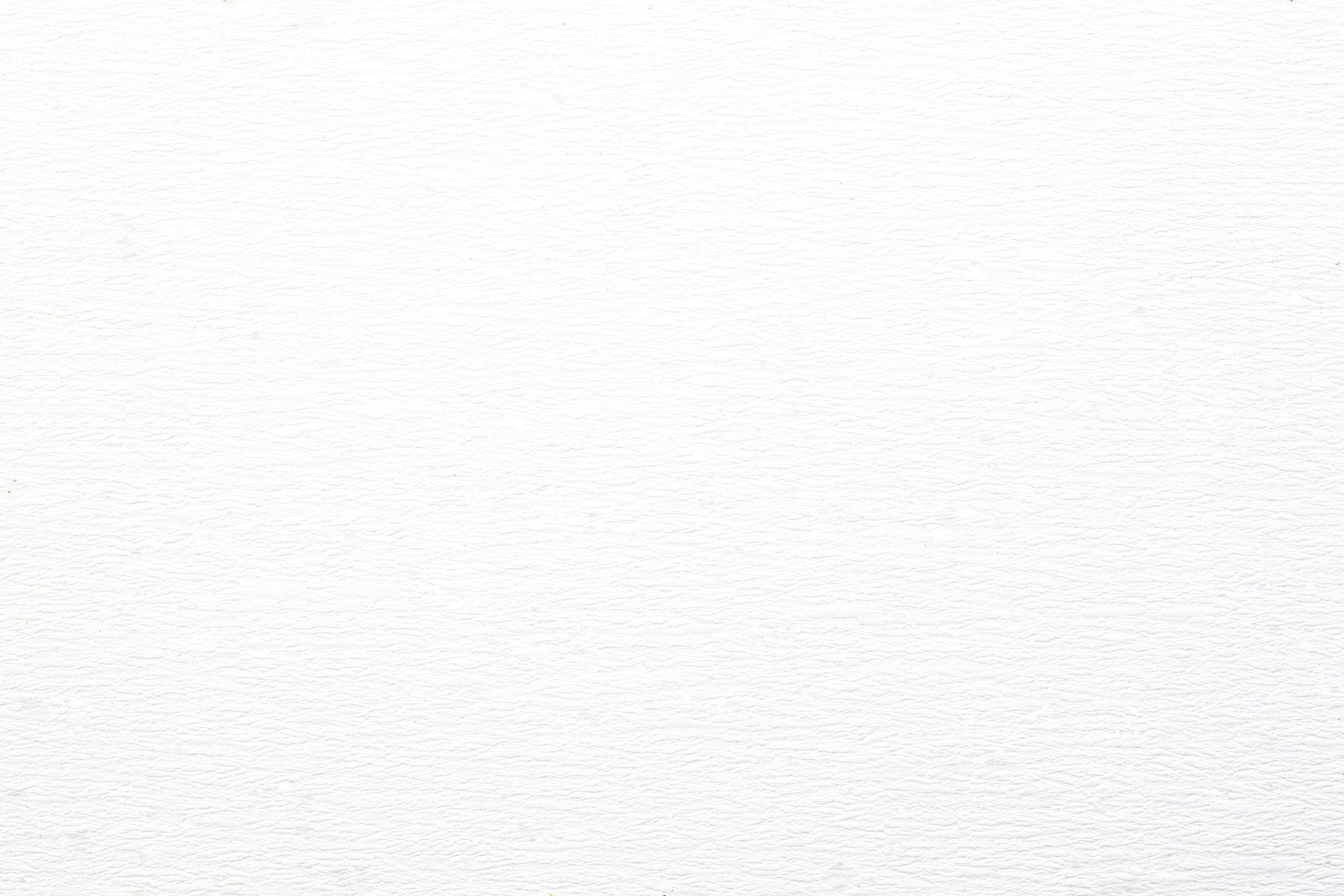


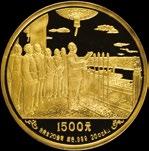


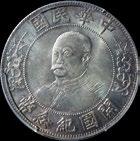




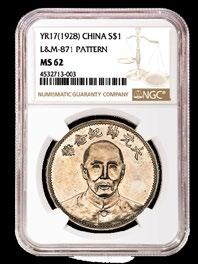



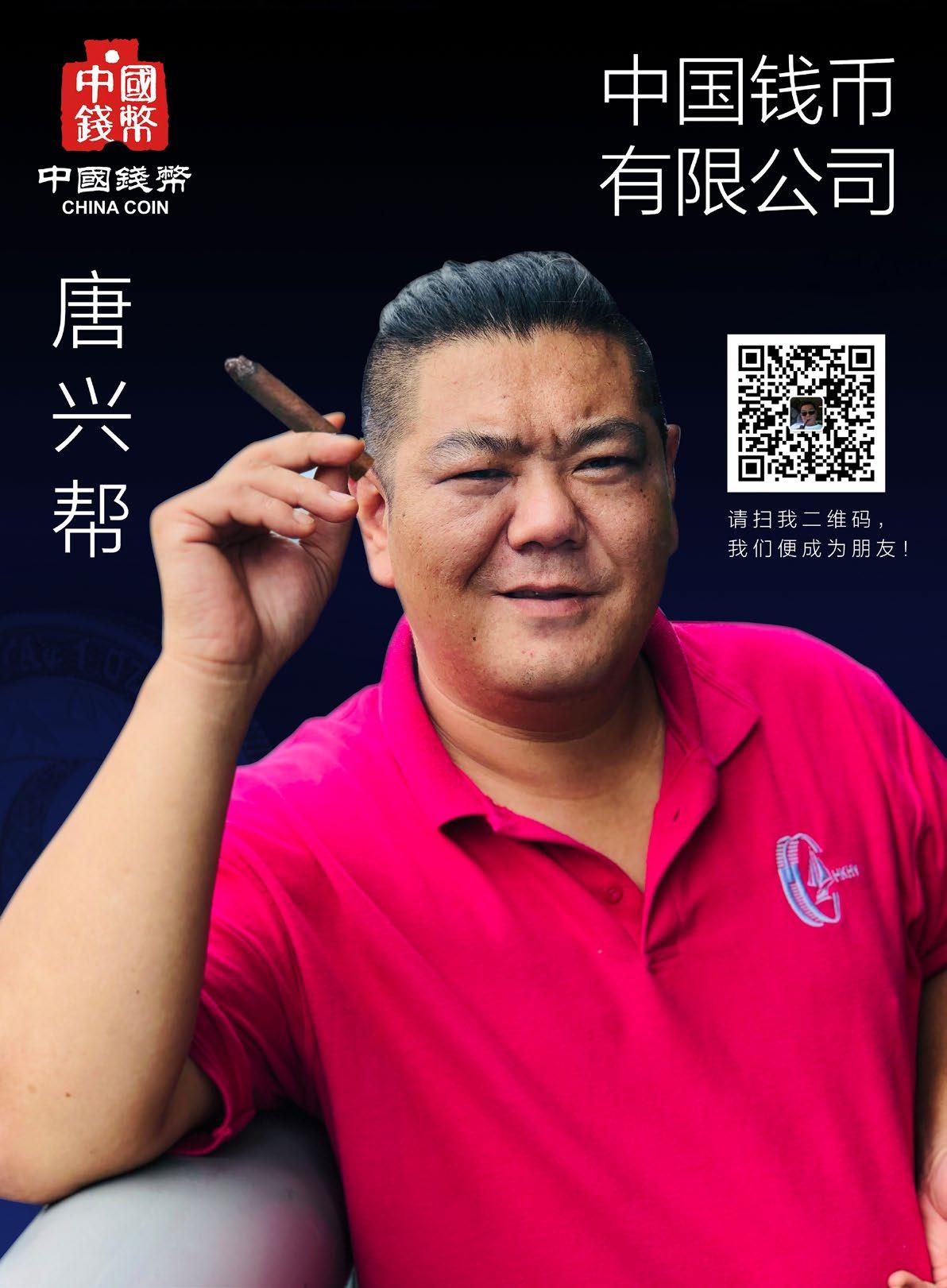


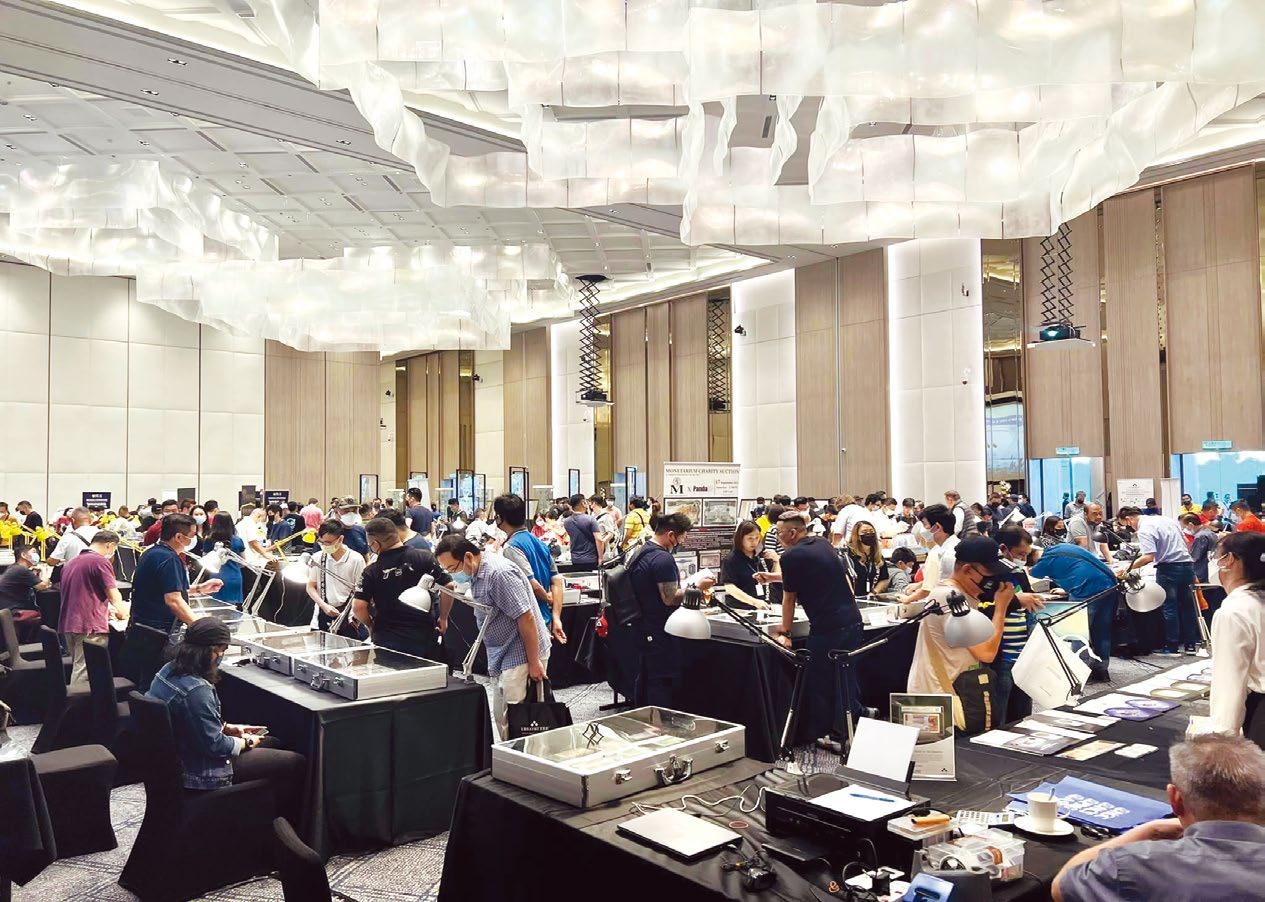



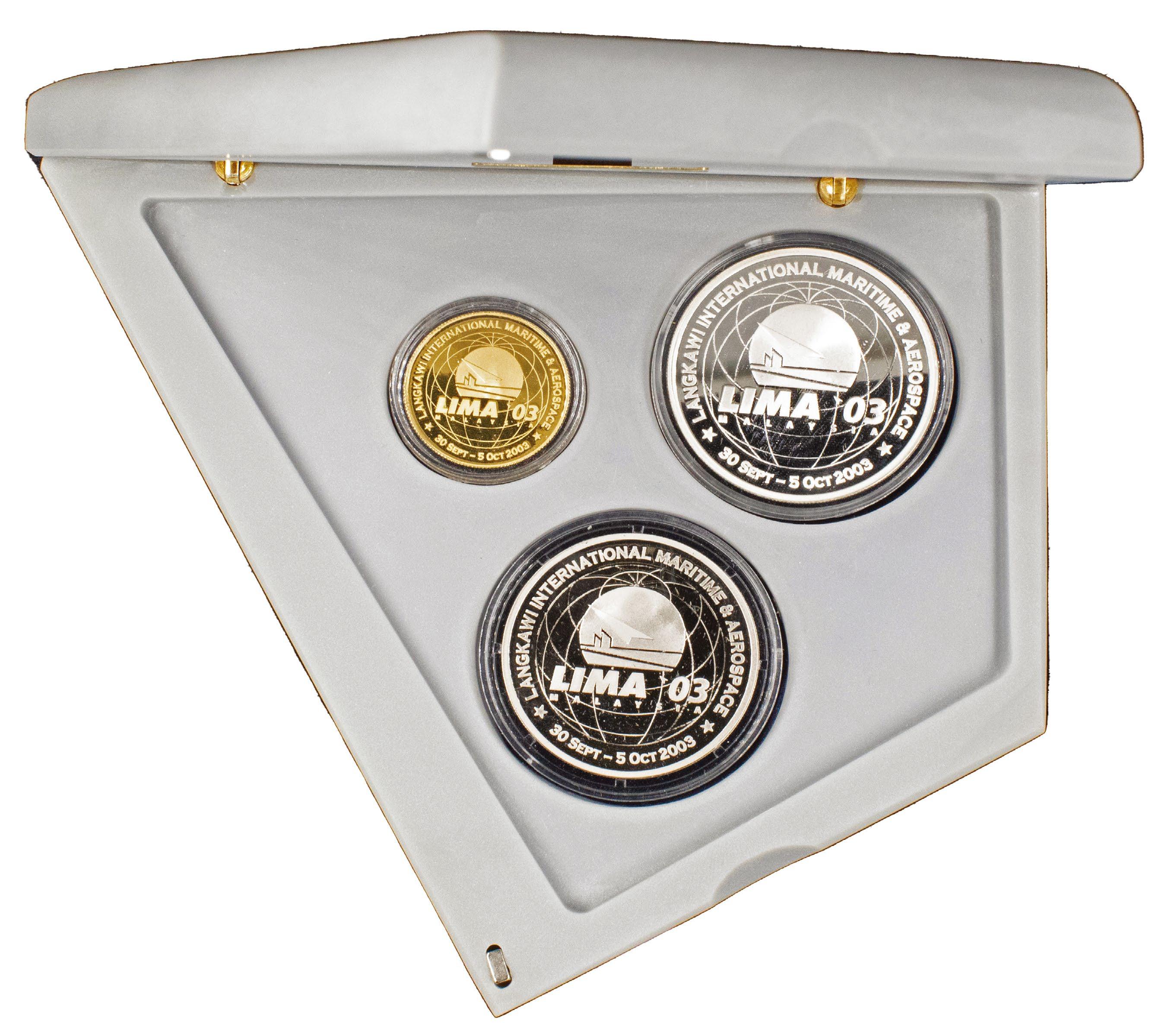




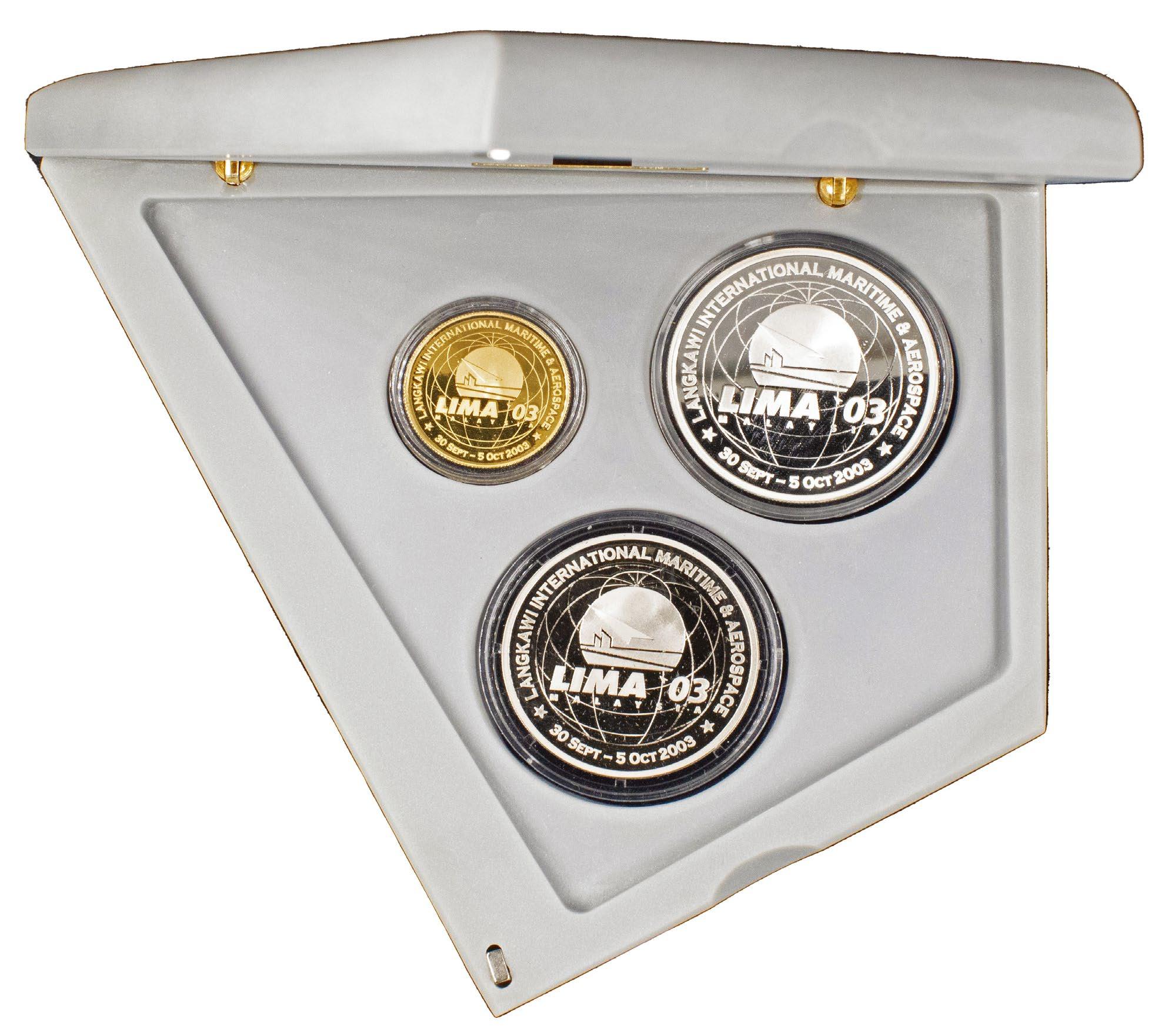


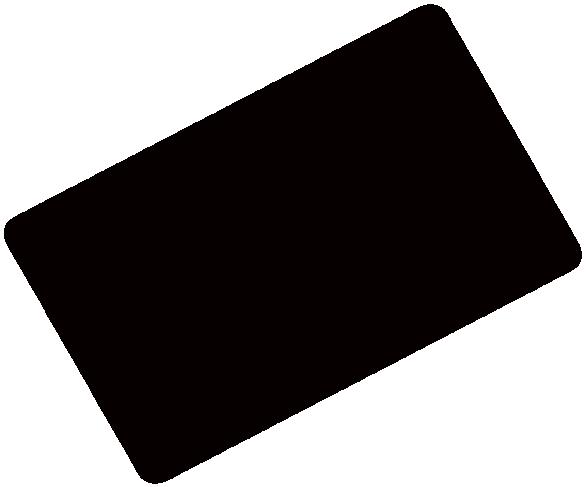
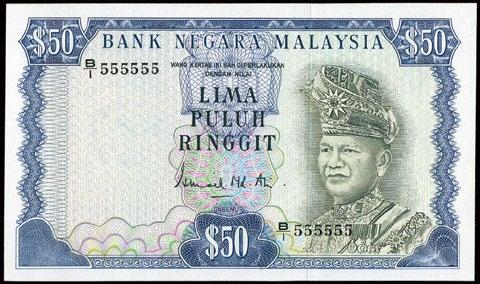
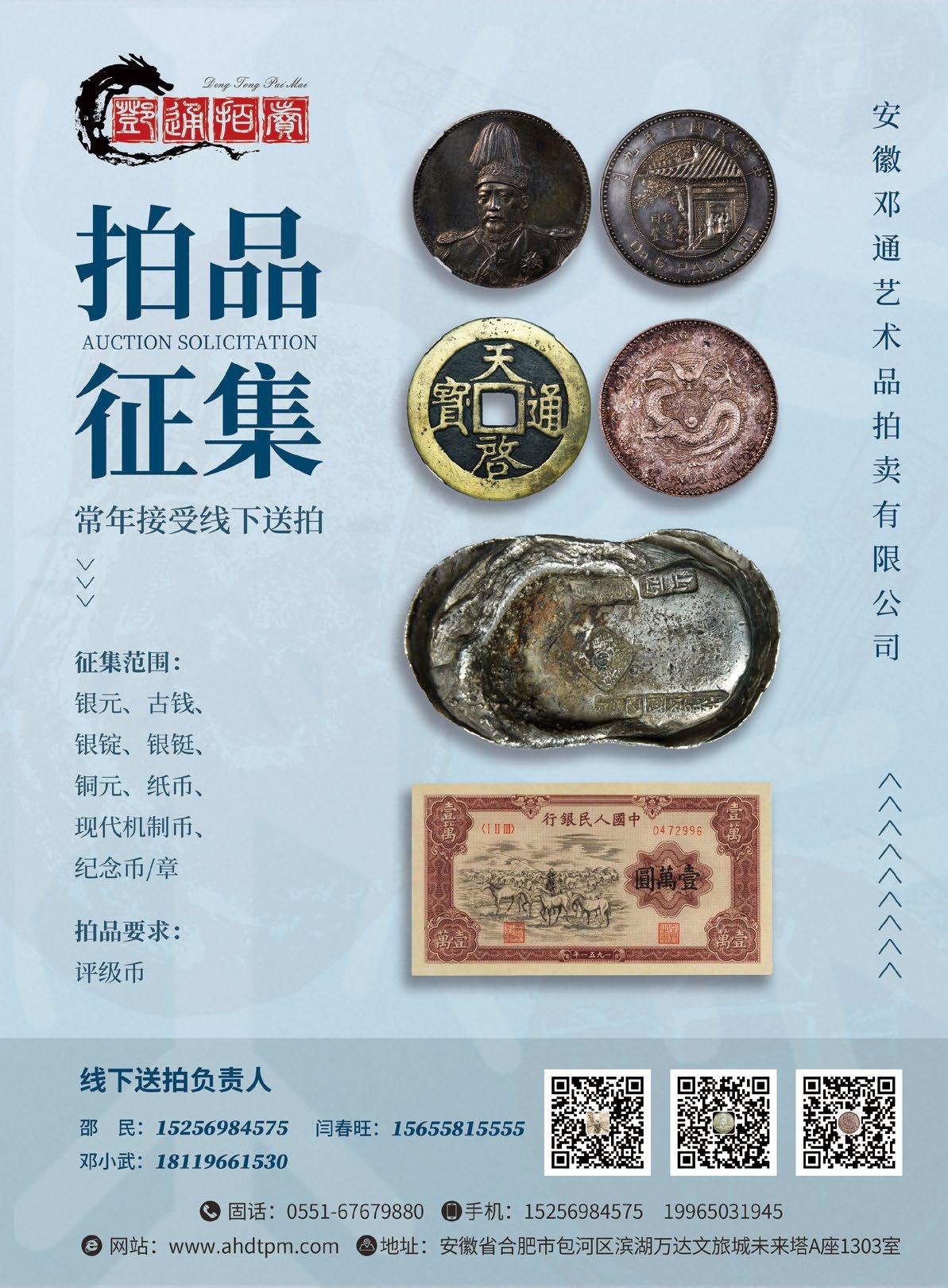

CHINA. 1500 Yuan (20 Ounce), 1993. Peacock Series. NGC PROOF-69 Ultra Cameo. Realized: $192,000

CHINA. Anhwei. 7 Mace 2 Candareens (Dollar), Year 24 (1898)-ASTC. Anking Mint. Kuang-hsu (Guangxu). PCGS MS-63. Realized: $126,000
CHINA. Gold K’uping Tael Pattern, CD (1906). Tientsin Mint. Kuang-hsu (Guangxu). NGC MS-62. Realized: $324,000
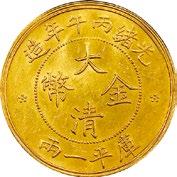
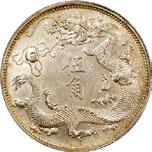
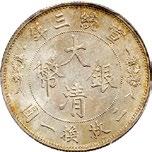
CHINA. Gold Presentation Dollar, ND (1912). Nanking Mint. NGC MS-61. Realized: $264,000

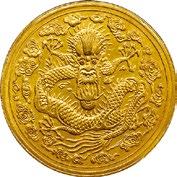


CHINA. Silver Dollar Pattern, ND (1916). Tientsin Mint. Hung-hsien (Hongxian [Yuan Shih-kai]). PCGS SPECIMEN-60. Realized: $372,000
CHINA. Silver 50 Cents Pattern, Year 3 (1911). Tientsin Mint. Hsuan-t’ung (Xuantong [Puyi]). PCGS SPECIMEN-63. Realized: $384,000

CHINA. Gold Dollar Pattern, ND (1923). PCGS SPECIMEN-61. Realized: $360,000

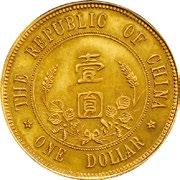

CHINA. Silver Dollar Pattern, Year 12 (1923). Tientsin Mint. PCGS MS-64 Prooflike. Realized: $432,000



CHINA. Copper 1/2 Dollar (50 Cents) Pattern, Year 24 (1935). Shanghai Mint. PCGS SPECIMEN-63+ Brown. Realized: $204,000

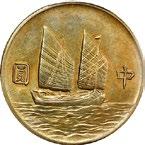

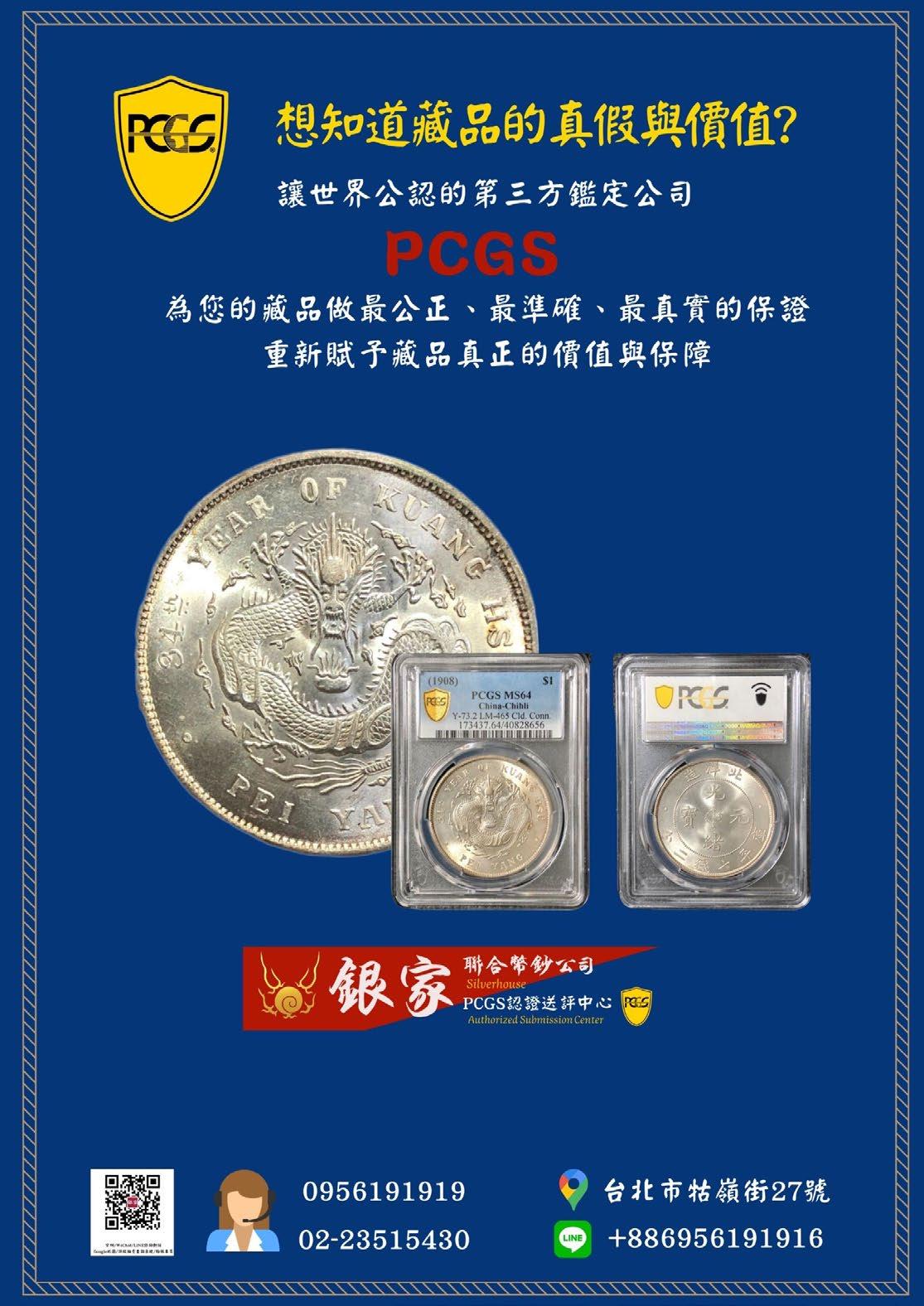




this world of instant experts and brokers, Mish International is still your best choice to handle the purchase of your prized coins in this fast-changing market. Well-capitalized, truly knowledgeable and accommodating, we buy both single pieces and major collections at fair
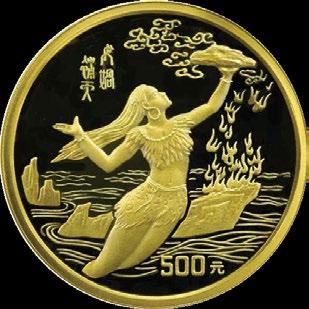


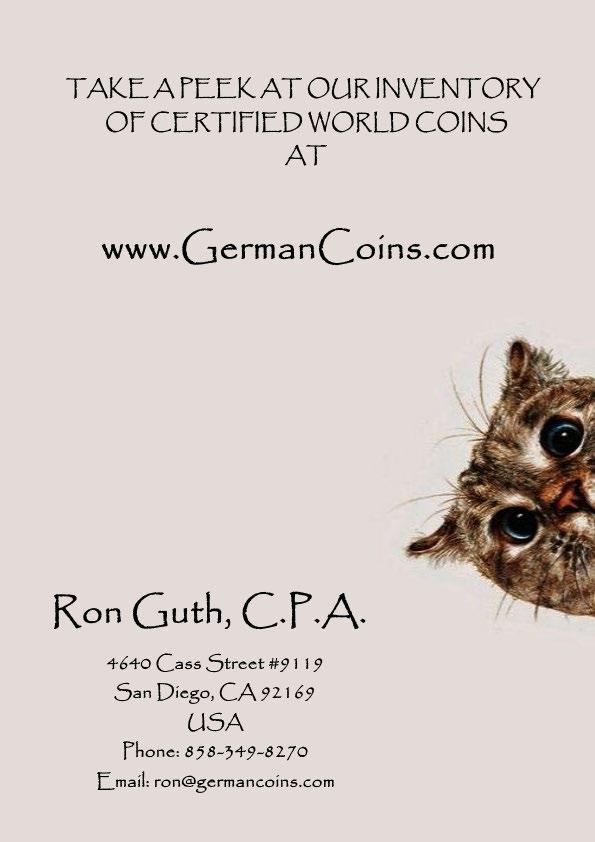

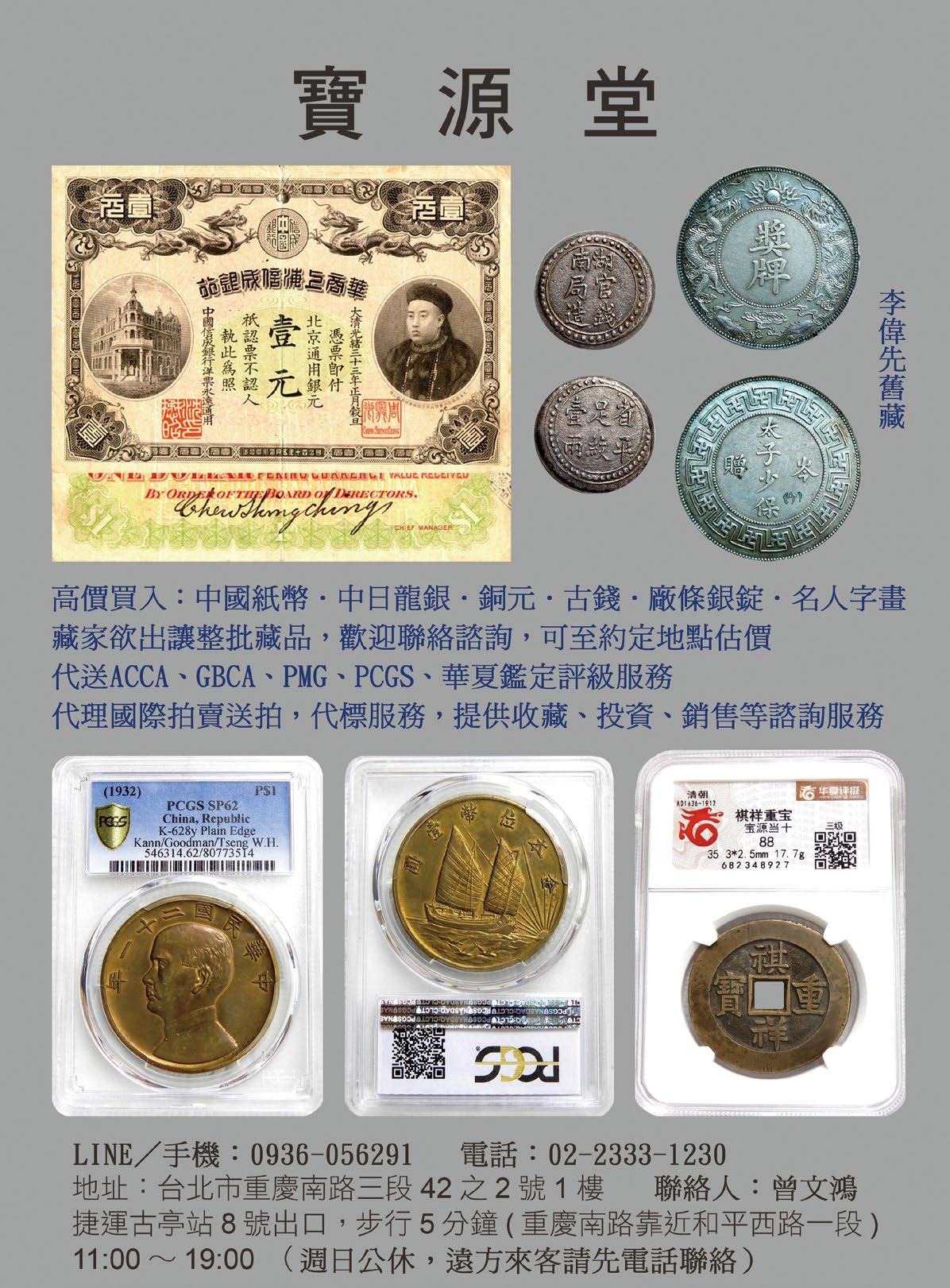



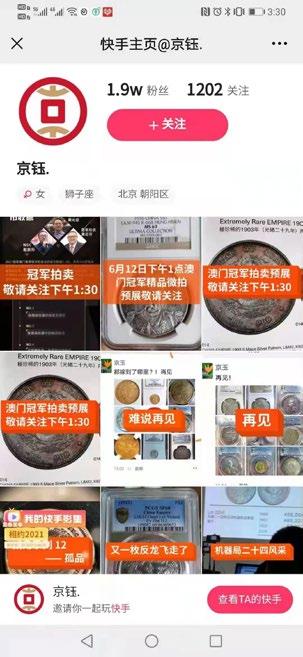

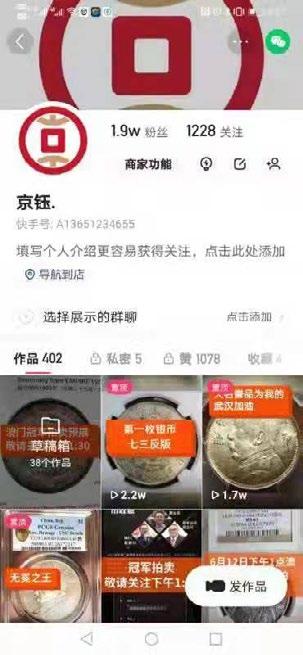


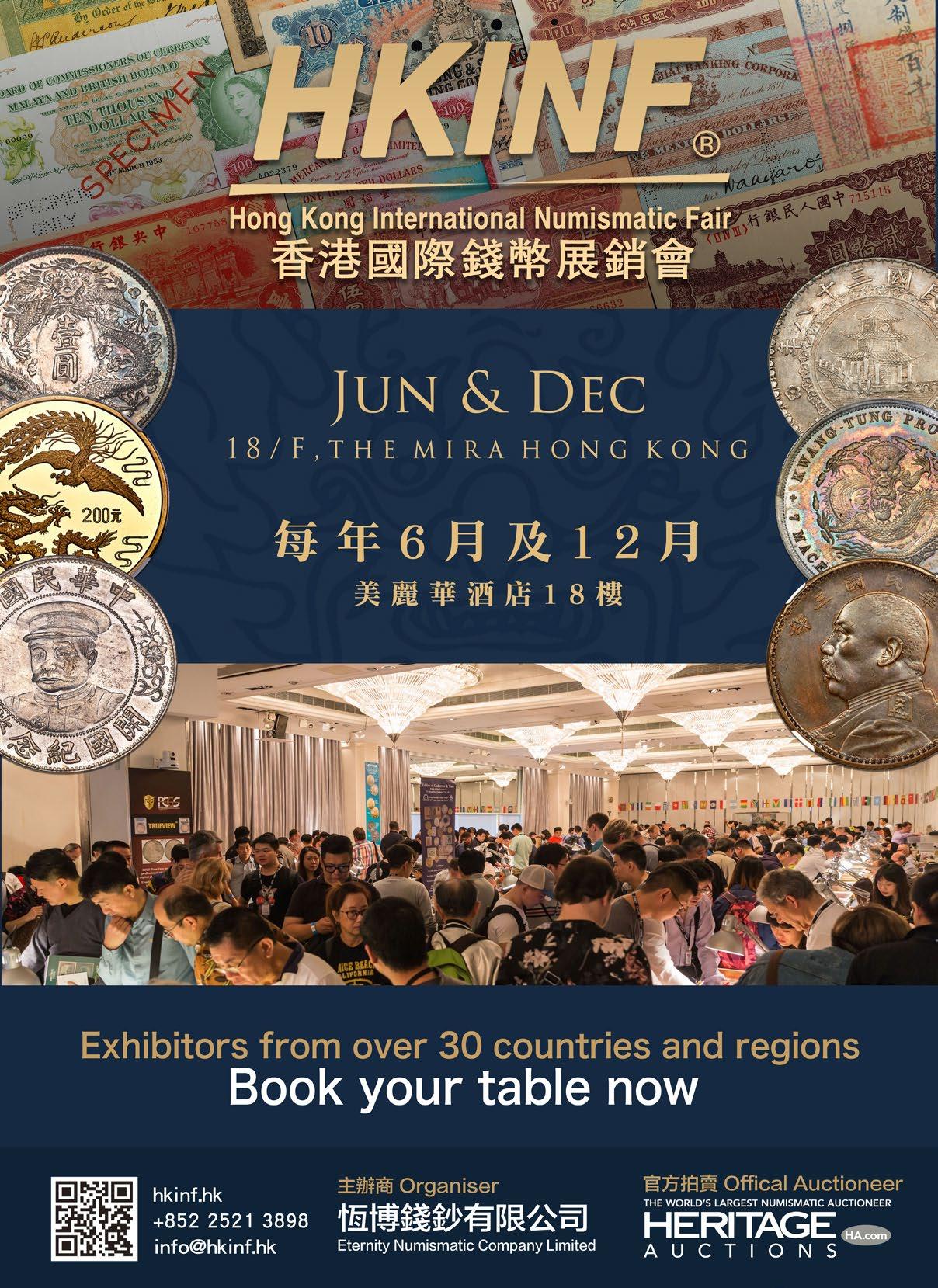



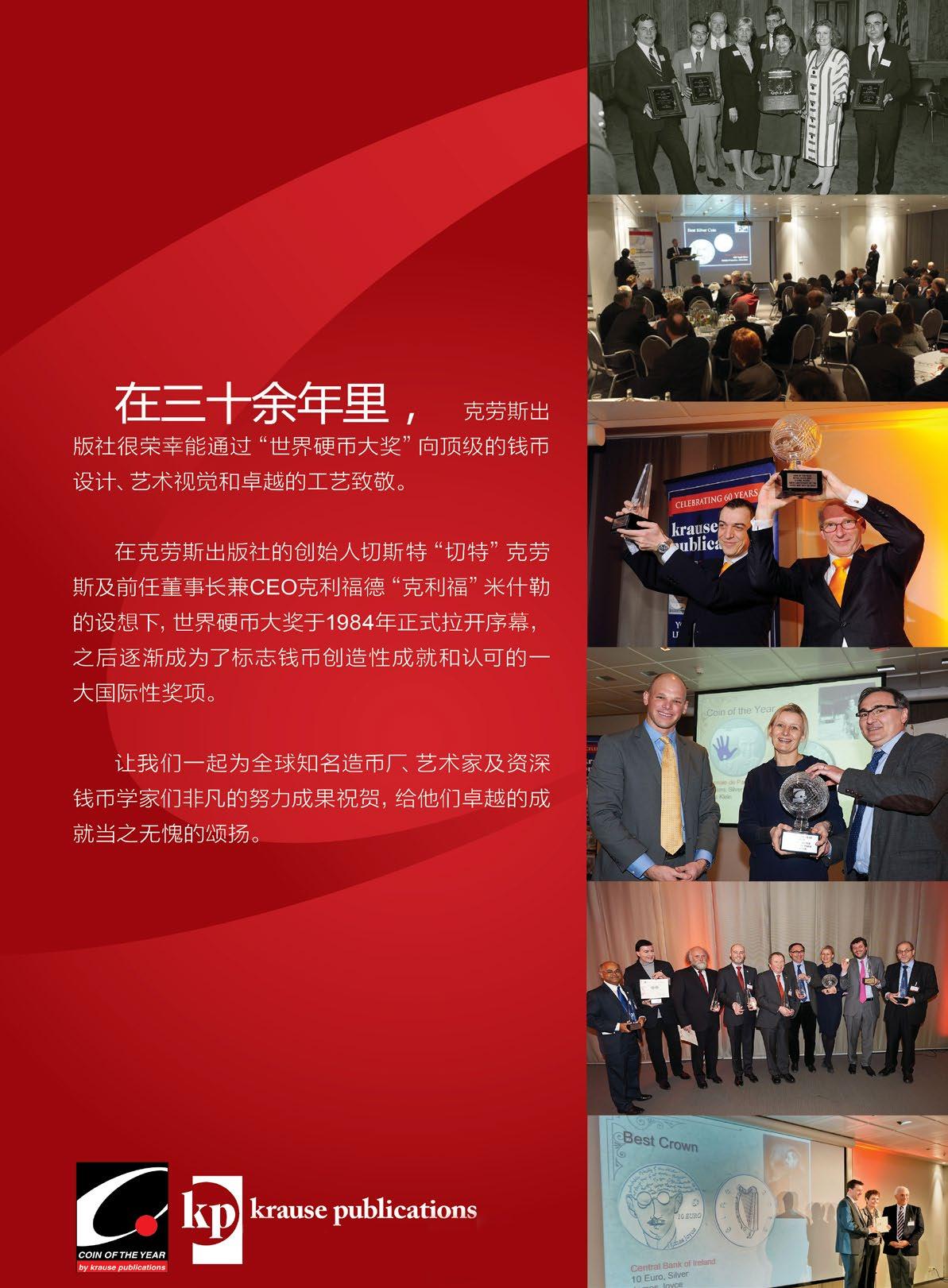








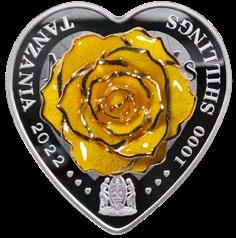
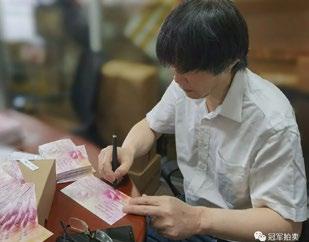


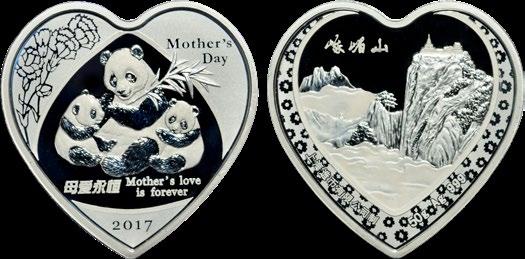


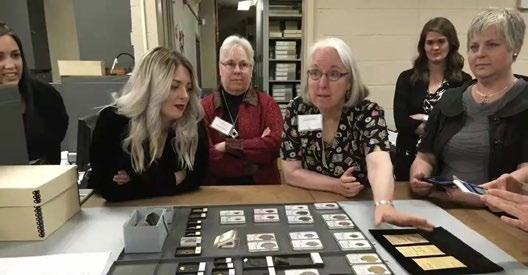
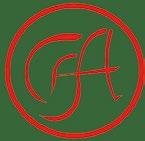





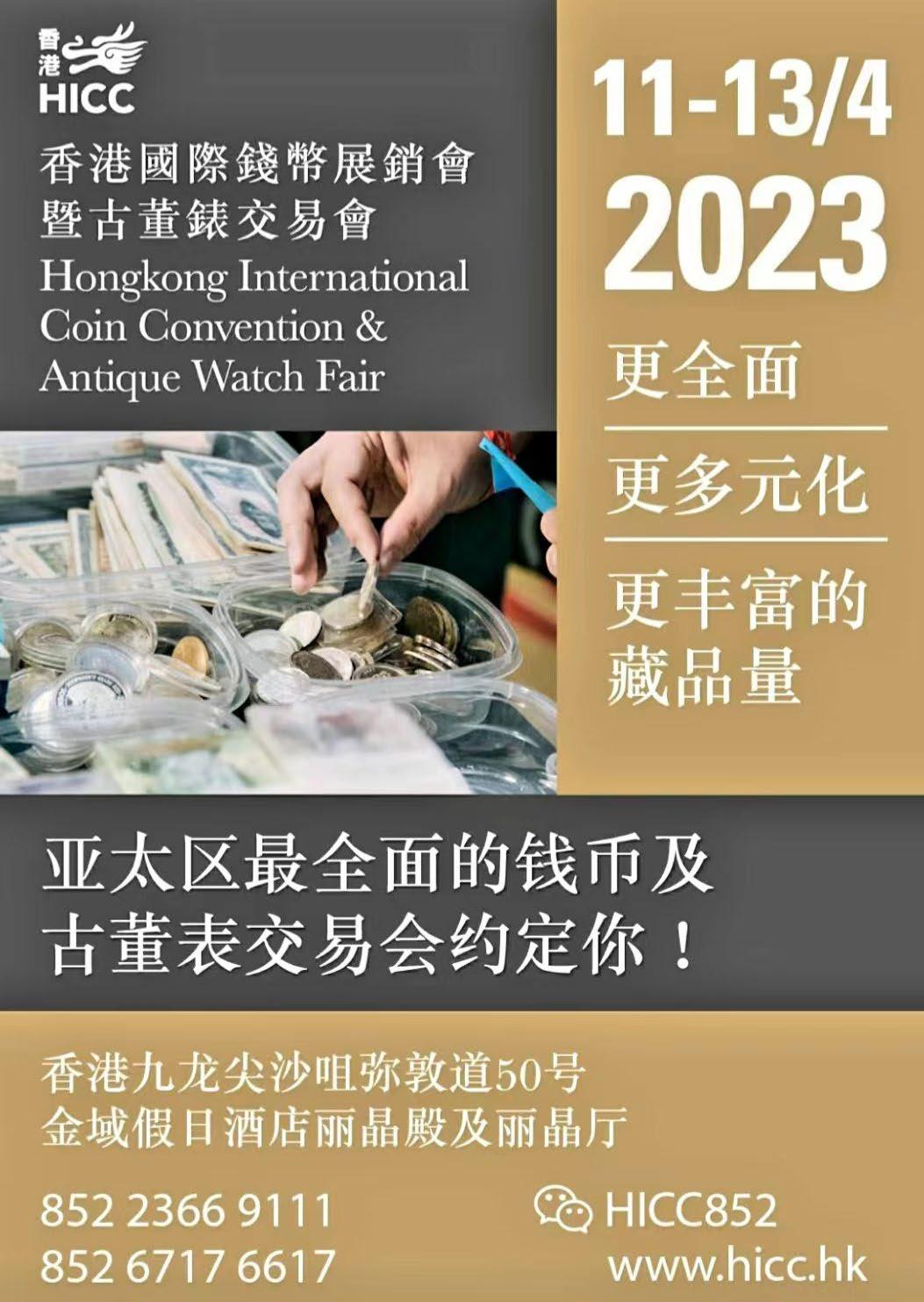


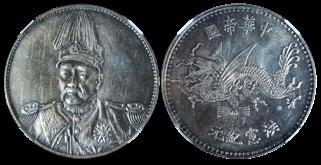

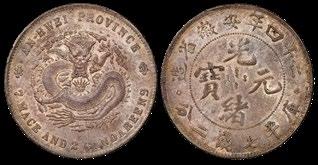





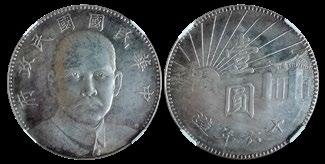
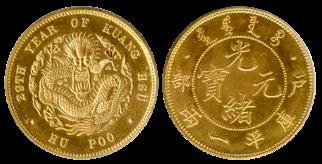








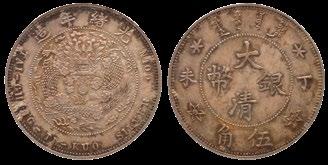

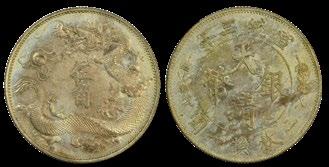





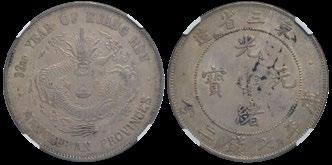












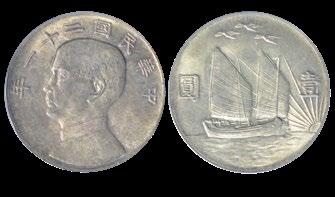
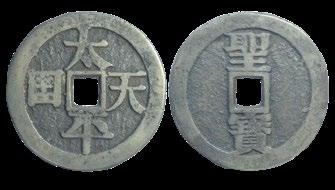


















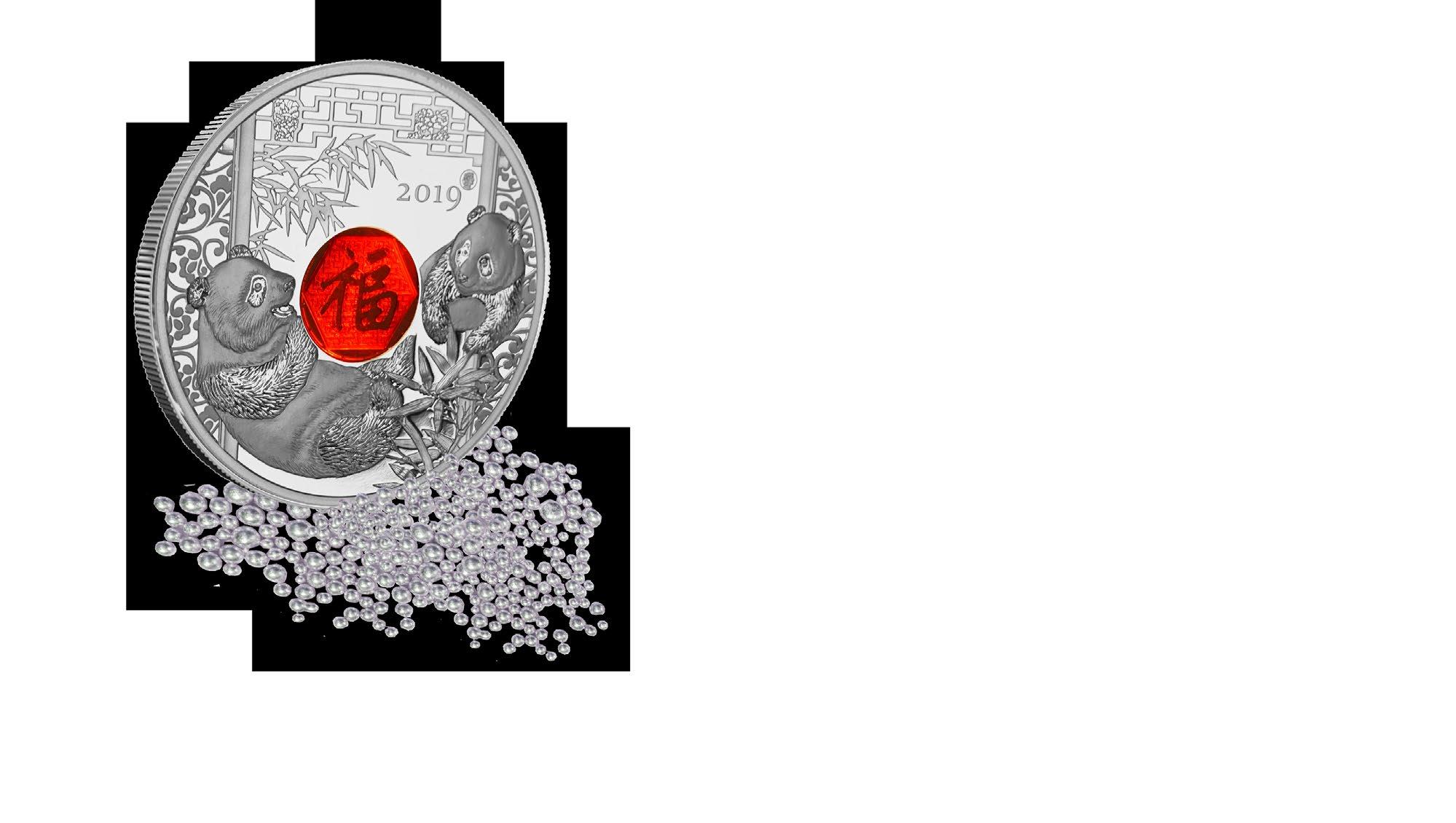

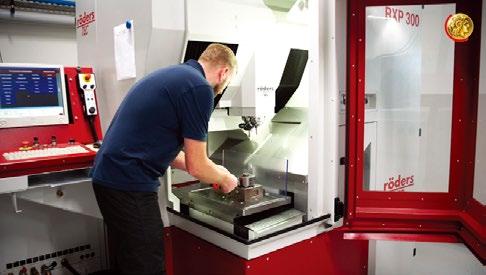
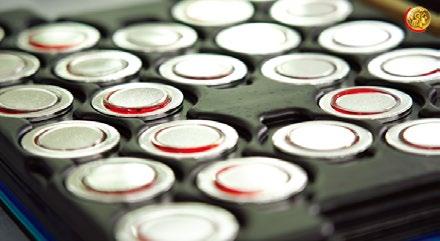
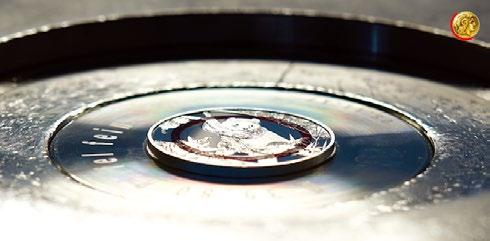
http://jeandigital.asia/






In 1994, The Journal of East Asian Numismatics (JEAN) was founded by Michael Chou, the CEO of Champion Auction and Bruce Smith, a noted numismatist. It is a professional numismatic academic journal whose mission is to educate collectors and researchers on the subjects of Chinese numismatics, culture and history.
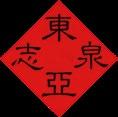

Bruce Smith, the chief editor of JEAN, was born in 1951 in St. Louis, MO. He received his BA in history from the University of Missouri St. Louis; and his MA in China studies from Harvard University. In 19741977, he worked for Krause Publications as Editorial Assistant on World Coin News and as cataloger for Standard Catalog of World Coins and Standard Catalog of World Paper Money. He was a full time coin dealer 1977-1987. In 1988-1989, he studied in China as a student of China Studies in Chengchow (Zhengzhou) University, Henan province. In 19911993, Mr. Smith was a graduate student at Harvard University. In 19941998, he was the editor of The Journal of East Asian Numismatics (JEAN). Bruce Smith has been a collector and researcher of Chinese coins for over 30 years. His published research in JEAN has added immensely to the body of knowledge for Chinese coins.
The first issue of JEAN was released in July 1994, and the last issue (18th issue) in 1998. Most articles were written in English, the remainder in Chinese. The journal was distributed in over 20 countries, and remained a mainstay on many important library shelves, including the Smithsonian Institution, the British Museum, the Harvard Yenching Library, Harvard University, Yale University, Columbia University, Stanford University, Cornell University, the ANS (American Numismatic Society), and the ANA (American Numismatic Association). The journal enjoyed great popularity and many important articles were published in JEAN, including “Peking Coins of 1900” by James Sweeny, “More on the Hsu Shih-Chang Pavillion Medals with engraved names” and “The true story of China’s 1936 and 1937 Silver Dollars” by Bruce Smith, “The Apparent
1st Issue 2nd Issue
3rd Issue 4th Issue
5th Issue 6th Issue
7th Issue 8th Issue
9th Issue
10th Issue 11th Issue 12th Issue 13th Issue 14th Issue 15th Issue
16th Issue 17th Issue 18th Issue 19th Issue 20th Issue 21st Issue 22nd Issue 23rd Issue 24th Issue 25th Issue 26th Issue 27th Issue 28th Issue
Relationship between 1897 Chekiang 5 Cents Pattern and 1899 Anhwei 5-Cents Circulation Strike” by Tom Keener, and “A Forgery of Taiwan’s Old Man Dollar” by Dr. Che-lu Tseng.
In May 2015, Michael Chou decided to start issuing the journal again starting in January 2016. The famous numismatic researcher Mr. Yuan Shuiqing will be chinese chief editor. He is a member of China Numismatic Society, serving as executive director of the Shenxi Numismatic Society and executive vice president of the Xi’an Collectors Association. As a numismatic researcher, he was chief editor of Collections and China Numismatics. He has published over 100 numismatic research articles and the masterpiece The Elite of Monetary History of China. Other distinguished contributors from home and abroad are numismatists, collectors and coin dealers, including Bruce Smith (author of Howard Franklin Bowker-Numismatic Pioneer), Colin Gullberg (Canada, author of Chopmarked Coins-A History), Chinese American senior numismatist Dr. Che-lu Tseng, Steve Feller former international banknote society editor, senior numismatic scholar of China modern gold and silver commemorative coins King L. Chan (Hong Kong), senior numismatist Chien Fu Chou (Taiwan) and CEO of Beijing Coins website Richard Guo.
It will be a quarterly, bilingual e-journal, covering the latest numismatic research, interviews with famous collectors, auction reviews, and general news. The Journal's distribution is now over 1,000, including over 3,000 in Greater China region.
Starting in 2017, Journal of East Asian Numismatics is a co-sponsor of Krause's Coin of the Year Award Ceremony in Berlin with World Money Fair.
You are welcome to subscribe, submit articles for publication, and advertise in the upcoming JEAN. The 2023 subscription is free of charge. Please send your email to jeanzg1994@163.com, http://jeandigital.asia/
issuu.com/jean388/docs/the_first_issue_of_jean issuu.com/jean388/docs/the_second_issue_of_jean issuu.com/jean388/docs/the_third_issue_of_jean issuu.com/jean388/docs/the_fourth_issue_of_jean issuu.com/jean388/docs/the_fifth_issue_of_jean issuu.com/jeandigitala1/docs/the_sixth_issue_of_jean issuu.com/jeandigitala1/docs/the_seventh_issue_of_jean issuu.com/jeandigitala1/docs/the_eighth_issue_of_jean issuu.com/jeandigitala1/docs/the_ninth_issue_of_jean issuu.com/jeandigitala1/docs/the_tenth_issue_of_jean issuu.com/jeandigitala1/docs/the_eleventh_issue_of_jean issuu.com/jeandigitala1/docs/the_twelfth_issue_of_jean issuu.com/jeandigitala1/docs/the_thirteenth_issue_of_jean issuu.com/jeandigitala1/docs/the_fourteenth_issue_of_jean issuu.com/jeandigitala1/docs/the_fifteenth_issue_of_jean issuu.com/jeandigitala1/docs/the_sixteenth_issue_of_jean issuu.com/jeandigitala1/docs/the_seventeenth_issue_of_jean issuu.com/jeandigitala1/docs/the_eighteenth_issue_of_jean issuu.com/jeandigitala1/docs/the_nineteenth_issue_of_jean issuu.com/jeandigitala1/docs/the_20twentieth_20issue_20of_20jean issuu.com/jeandigitala1/docs/the_twenty_first_issue_of_jean issuu.com/jeandigitala1/docs/the_twenty-second_issue_of_jean issuu.com/jeandigitala1/docs/the_twenty-third_issue_of_jean issuu.com/jeandigitala1/docs/the_24th_issue_of_jean issuu.com/jeandigitala1/docs/the_twenty-fifth_issue_of_jean issuu.com/jeandigitala1/docs/the_twenty-sixth_issue_of_jean issuu.com/jeandigitala1/docs/the_twenty-seventh_issue_of_jean issuu.com/jeandigitala1/docs/the_28th_issue_of_jean
full page (A4): 210×297mm PX: 300 1/2 page: 210×148mm
讓廣大錢幣收藏家、研究學者更深入地瞭解錢幣知識,讓世界各地 的讀者更好地瞭解中國深厚的錢幣文化。 雜誌高級編輯史博祿先生 1951年生於美國密蘇裏州聖路易斯市, 為密蘇裏大學歷史系學士,哈佛大學中國研究專業碩士。19741977年在克勞斯出版社任《世界錢幣新聞》助理編輯,參與《世 界硬幣標準目錄》與《世界紙鈔標準目錄》編輯工作。1977-1987 年全職進行錢幣交易。1988-1989年在中國鄭州大學留學,主修 中國研究課程。1991-1993年在哈佛大學攻讀碩士。1994-1998 年任《東亞泉志》總編。史博祿先生擁有30多年的收藏和研究中 國錢幣的豐富經驗。他在《東亞泉志》上發表的研究文獻極大地豐 富了中國錢幣的知識內涵。
《東亞泉志》於1994年7月份問世,1999年停刊,發行了18期。 雜誌中大部分文章是英文,只有少部分是中文,在20多個國家發 行,廣受歡迎,長期佔據許多重要圖書館書架的顯著位置,包括美 國國家博物館史密森尼學會、大英博物館、哈佛燕京圖書館、哈佛 大學、耶魯大學、哥倫比亞大學、斯坦福大學、康奈爾大學和美國 錢幣學會、美國錢幣協會。雜誌刊發過不少有重要學術價值的文章, 如詹姆斯 史威尼寫的《1900年京局銀元》、史博祿寫的《徐世昌 刻字紀念章》和《民國二十五年和民國二十六年之中國銀元故事》、 湯姆 基納寫的《1897年浙江三分六厘樣幣和1899年安徽三分六 厘流通幣的關係》以及曾澤祿寫的《臺灣老公銀偽品》等。
幣收藏研究成果、推介泉界成功人士的事蹟為主。主要欄目有學術 研究、人物專訪、鑒賞爭鳴、拍賣回顧、重要信息等。 從2017年起,《東亞泉志》加盟由克勞斯在德國柏林世界錢幣展覽 會期間舉辦的“世界硬幣大獎”頒獎活動。

《東亞泉志》2023年免費訂閱,如果需要,請把您的郵箱發到 jeanzg1994@163.com !我們的網址:http://jeandigital.asia/
http://issuu.com/jean388/docs/the_first_issue_of_jean http://issuu.com/jean388/docs/the_second_issue_of_jean http://issuu.com/jean388/docs/the_third_issue_of_jean http://issuu.com/jean388/docs/the_fourth_issue_of_jean http://issuu.com/jean388/docs/the_fifth_issue_of_jean http://issuu.com/jeandigitala1/docs/the_sixth_issue_of_jean https://issuu.com/jeandigitala1/docs/the_seventh_issue_of_jean https://issuu.com/jeandigitala1/docs/the_eighth_issue_of_jean https://issuu.com/jeandigitala1/docs/the_ninth_issue_of_jean https://issuu.com/jeandigitala1/docs/the_tenth_issue_of_jean https://issuu.com/jeandigitala1/docs/the_eleventh_issue_of_jean https://issuu.com/jeandigitala1/docs/the_twelfth_issue_of_jean https://issuu.com/jeandigitala1/docs/the_thirteenth_issue_of_jean https://issuu.com/jeandigitala1/docs/the_fourteenth_issue_of_jean https://issuu.com/jeandigitala1/docs/the_fifteenth_issue_of_jean https://issuu.com/jeandigitala1/docs/the_sixteenth_issue_of_jean https://issuu.com/jeandigitala1/docs/the_seventeenth_issue_of_jean https://issuu.com/jeandigitala1/docs/the_eighteenth_issue_of_jean https://issuu.com/jeandigitala1/docs/the_nineteenth_issue_of_jean https://issuu.com/jeandigitala1/docs/the_20twentieth_20issue_20of_20jean https://issuu.com/jeandigitala1/docs/the_twenty_first_issue_of_jean https://issuu.com/jeandigitala1/docs/the_twenty-second_issue_of_jean https://issuu.com/jeandigitala1/docs/the_twenty-third_issue_of_jean https://issuu.com/jeandigitala1/docs/the_24th_issue_of_jean https://issuu.com/jeandigitala1/docs/the_twenty-fifth_issue_of_jean https://issuu.com/jeandigitala1/docs/the_twenty-sixth_issue_of_jean https://issuu.com/jeandigitala1/docs/the_twenty-seventh_issue_of_jean https://issuu.com/jeandigitala1/docs/the_28th_issue_of_jean


Didn’ t enjoy reading only one issue of the JEAN? Follow me here for all previous issues of the quarterly the JEAN, which will also be updated regularly. Besides that there will be a lot of latest numismatic articles, news, events and other information here.


